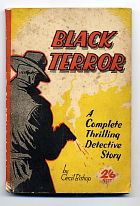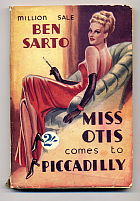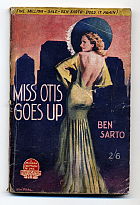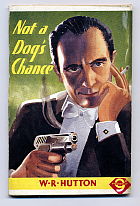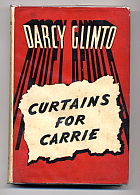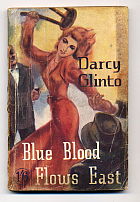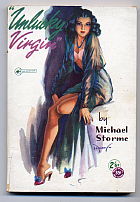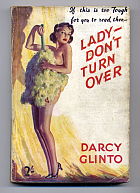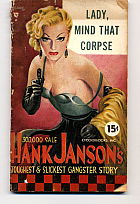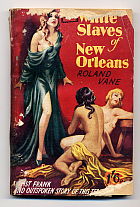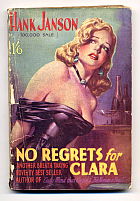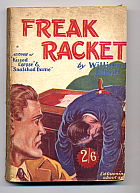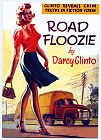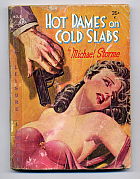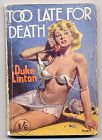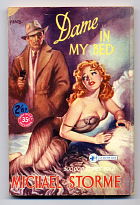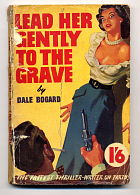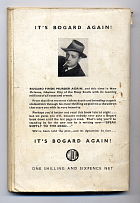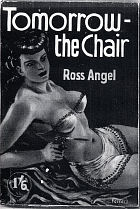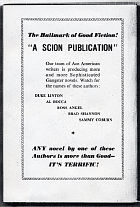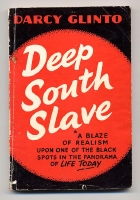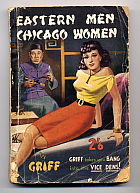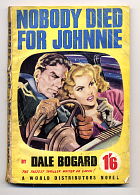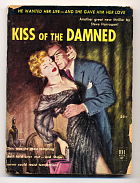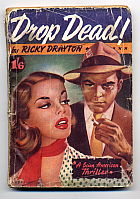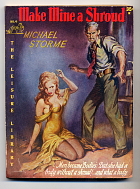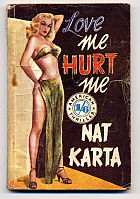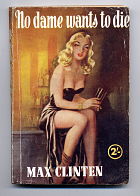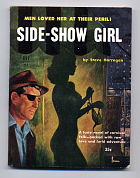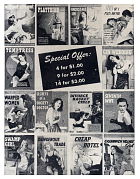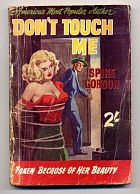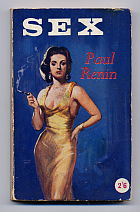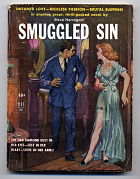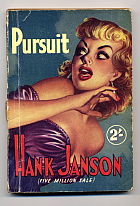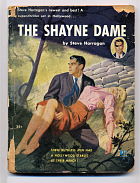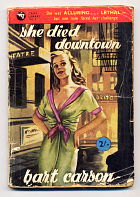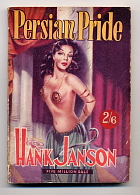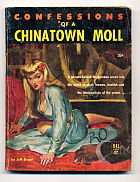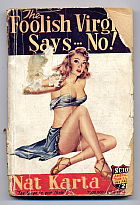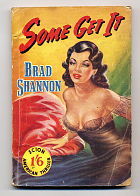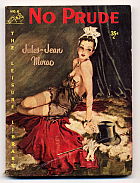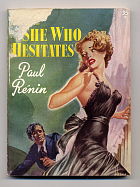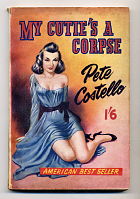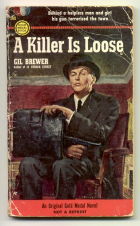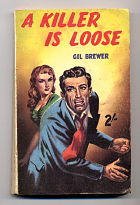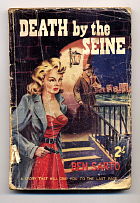Found Pages: The Remarkable Harold Ernest (“Darcy Glinto”) Kelly, 1899–1969.
Mushroom Jungle books II: a sampling ENLARGED
The late 1940s were a period of pervasive corruption in Britain. Profit-taking from the supply of illicit drugs began to escalate during a crime wave reflecting the strict government controls imposed upon free markets. Peacetime rationing of food, clothes, petrol and raw materials, together with controls over the import and export of currency and commodities, persisted until the early 1950s. These “austerity measures,” as they were known, increased lawlessness at all levels of society, rather in the manner of the US alcohol prohibition in the 1920s.
Richard Davenport-Hynes, The Pursuit of Oblivion; A Global History of Narcotics (2002), p. 372
Here are my descriptions of the Jungle books that I have been able to get hold of.
I’ve not treated James Hadley Chase as a Jungle writer, major though the impact of his pre-1943 books was, and I’ve been selective with Darcy Glinto. For more about both of them, see Violence Inc and Sidebars 1, 2, and 3.
SH signifies annotations by Steve Holland after the first version of the page went on-line.
To access descriptions, click below or scroll down the page. The list is alphabetical. The descriptions themselves are arranged by year.
A Curtain of Glass • A Guy Named Judas • A Killer is Loose • Accused • Black Terror • Blue Blood Flows East • Broads Don’t Scare Easy • Bullets for Snoopers • Carney’s Burlesque • Chicago Dames • Coffin for a Cutie • Confessions of a Chinatown Moll • Crazy to Kill (Trouble with a Woman) • Cry Wolf Sister • Cuban Heel • Curtains for Carrie • Curves Cause Trouble • Dame in My Bed • Dared by a Dame • Death by the Seine • Death for a Doll • Deep South Slave • Don’t Touch Me • Drop Dead • Eastern Men—Chicago Women • Fireball • Foolish Cargo • Gardenia • Get Me Headquarters • Goodbye, Honey • Hear the Stripper Scream • Hell Hath No Fury • Hot Dames on Cold Slabs • I’ll Get You for This • Kill and Desire • Killer • Kitty Takes the Rap • Kiss of the Damned • Lady, Mind That Corpse • Lady—Don’t Turn Over • Ladies Sleep Alone • Landscape with Corpses • Lead Her Gently to the Grave • Love Me Hurt Me • Make Mine a Harlot • Make Mine a Shroud • Miss Otis Comes to Piccadilly • Miss Otis Goes Up • Mister Violence • My Cutie’s a Corpse • My Gun Her Body (Danger for Dinah) • My Life is My Own • Night Haunts of Paris • Nobody Died for Johnnie • No Come Back from Connie • No Dame Wants to Die • No Mortgage on a Coffin • No Orchids for Miss Blandish • No Prude • No Regrets for Clara • Not a Dog’s Chance • Now Try the Morgue • Over My Dead Body • Pay-off for Paula • Persian Pride • Pick-up Girl • Pursuit • Remember Mimi • Road Floozie • Scarred Faces • Sex • She Died Downtown • She Who Hesitates • Side-Show Girl • Sin is a Redhead • Sinful Sisters • Smuggled Sin • Snatched Dames • Some Get It • Some Look Better Dead • Stiffs Don’t Squeal • Strip-Tease Angel • Sunny • Take It and Like It • The Big Snatch • The Brute • The Dame Plays Rough • The Dead Sleep for Keeps • The Dead Stay Dumb • The Foolish Virgin Says No • The Hangman is a Woman • The Hideout • The Shayne Dame • The Snatch • The Unsuspected • This Way for Hell • Three Bad Girls • Three Steps to Hell • Tomorrow—the Chair • Too Late for Death • Too Tough to Die • Torment for Trixie • Tough On The Wops • Trixie • Trouble with a Woman • Unlucky Virgin • When Dames Get Tough • When Shall I Sleep Again • White Slave Racket • White Slaves of New Orleans • Women Hate Till Death • You’ll Never Get Me
Cecil Bishop, Black Terror (1945) NEW
A transitional work. Wartime production quality—small print, narrow margins, two staples, impossible to open pages flat. The action seems to be going on in the Thirties, maybe around 1937. Reads as though it could have been in an issue of the tuppeny large-page weekly The Thriller, unless too long at around 60,000 words. An unsexy economy cover.
Basically, as in earlier novels like John G. Brandon’s Gang War (1929), John Hunter’s When the Gunmen Came to London (1930), and Edgar Wallace’s When the Gangs Came to London (1932), the British professional class—Scotland Yard, a couple of journalists, an inspector back from the Far East—is coping with the homicidal activities of American criminals in Britain. But social order is less secure.
As we learn from the opening conversation between the Director of the United States Bureau of Investigation and Paul Hariman of the Hong-Kong police, a couple of Britons have gone missing down in redneck Hayley County, the fiefdom of rich wicked Morgan Shuyler and his son Maurice. It’s agreed that Hariman can go down and mosey around, with special attention to one of the infamous prison camps.
Cut to a work detail and abusive guards.
Every coarse and brutal word made the poor devils strive more desperately, even when they were almost collapsing with the merciless heat. They well knew what tortures awaited them at the prison camp if the guards reported unfavourably upon them to Drood, the prison warden. Men had been flogged with blacksnake whips until they were in ribbons, strung up in the dreaded sweat box until they went insane, even branded with white-hot irons at the dictates of the inhuman Drood. Their horrible screams came to the shivering prisoners in theit foul huts, but Narrow Ridge was a lonely spot, and there were none outside the camp to hear them. (10)
Hariman shoots Drood just when he is about to murder jewel-thief convict Frank Johnson out in the privacy of the swamps, and deposits Johnson with the Bureau of Investigation in Washington. The Shuylers, whose agent Drood was, flee to Britain, where the libel laws, according to Hariman, are known as the “Rogues’ Charter” because of the crimp they put on newspaper exposés.
But more than ordinary criminality is involved. As Gustav Holm, the financier father of reporter Pat Kelly’s girlfriend Irene, tells Kelly,
“The trouble about undemocratic parties is that they are treated as a joke for too long. … Today everyone is ridiculing the idea of a Fascist government for Britain or America. Five years ago they said the same thing in Germany. These movements have a habit of growing by stealth, my boy. …
They thrive on murder and terrorism. Even now, in America, the vilest men run whole districts, using every means of coercion against those who oppose them. You don’t hear much of them in England, apart of course from Huey Long’s late dictatorship in Louisiana. But they’re there all the same. …
At the present time they have branches in every state of the Union and even in Great Britain. Backed by the influence—unofficial, of course—of a certain foreign power, the [Black] Riders, now known as the Black Legion, as you have probably read, aim at securing control of the United States Government.” (58, 61)
And are now poised to spring.
But though on paper there’s a fair amount of action, the activities of the Legion mostly come to us second-hand in reports, there are no shocking violences, you don’t hear American-sounding voices, and the emphasis is more on trying to figure out what’s going on and who the mystery British head of the Legion is, with reporter Kelly (who’s not afraid to shoot a baddy in the guts) getting into and out of trouble and trying to protect Irene. The explanation at the end of what’s been going on behind the scenes has the complexity of whodunits.
Still, we have a two-page meeting of members of the Legion at which the mysterious Leader (who has an accent from the American South ) declares, “Brethren, to-night you will draw for the everlasting honour of deciding who shall strike the crushing blows we plan to aim at the effete leaders of British democracy.” (100)
And Press lord Viscount Isaacstein, owner of Kelly’s paper, is unequivocally a good guy, despite being referred to at a couple of points as “the Hebrew” and “the Jew.” No irony seems intended when we’re told that “His nose was large, not essentially Semitic, but his keen, piercing eyes were the eyes of a race that has for ever suspected—and with excellent cause—the designs of all men save their own brethren.”(74)
He’s given the last word, too, when he announces fervently to the assembled cast,
“I thank you all. You have each helped to smash an evil body—one which sought to make this country a hell for my people, and for all of you. They have learned once and for all that the strong and just Governments of England and America can and will fight them with their own vile weapons. Again I thank God that we have men and women with the courage to face these monsters and strike them down.” (127)
So, when was the book written? Its liberal tilt isn’t what one would have instantly expected from an author described on the title page as “Late of the C.I.D., New Scotland Yard.” It would be nice to feel that Bishop wrote with foresight rather than with the rectitude of hindsight.
In any event, politics would vanish from the ensuing Jungle books, as would, to judge from what I’ve read so far, the paradigm of the invasion by unruly Americans of an orderly Britain. From now on, “American” values in action in imagined American locales would be foregrounded, with plots less wide-angle and violences intensified.
In “Some Orchids for James Hadley Chase,” I express some reservations about George Orwell’s classic “Raffles and Miss Blandish,” in which he protests against the Americanisation that had achieved industrial strength with the novels of James Hadley Chase and, by implication, Darcy Glinto (He initially confused Miss Callaghan Comes to Grief with Lady—Don’t Turn Over) in 1939–42.
What he did in that essay would pervade Hoggart’s very influential characterization of the Mushroom Jungle in his partly autobiographical study of working-class culture in The Uses of Literacy (1957).
James Hadley Chase, I’ll Get You for This (1946; pb 1951)
I’d inferred from the title that this would be an injection into the Jungle of the old Chase toughness, a hope reinforced by the claim on the front cover of the Avon paperback (“complete and unabridged”) that “Dashiell Hammett and Raymond Chandler combined might have written this gun-blazing story.” Oh yes?
Gambler and dead-shot Chester Cain (“They said I was the fastest gun-thrower in the country”) has come to Paradise Palms for a vacation, where, as courtesy to a visiting Somebody, he’s fitted up with a great hotel suite and the company of Miss Wonderly, who casually removes her two-piece when they swim out to a raft, and lets him tell her about himself, after which, back in his suite, he’s put to sleep with drugged brandy and wakes to find they’d keeping company with a corpse.
The rest of the narrative is Cain getting away from the Law and trying to clear their names, hither and yonning, There’s some “action.” He tussles with a snotty dame in her apartment, dodges cops’ bullets and projects a few of his own during a getaway, and breaks Miss Wonderley out of jail with the aid of a coffin, after fighting off a couple of crazy women behind bars. But he doesn’t feel especially tough, and while there’s a conflict between a couple of Italiano gang bosses, there isn’t a strong hoodlum presence. He isn’t even beaten up. The book would probably read OK if a name like Al Karta or Spike Morelli were on the cover. But there are no flickers of the Chase of the unexpurgated No Orchids and The Dead Stay Dumb. Chase probably never recovered from the 1942 prosecution of Miss Callaghan Comes to Grief at the Old Bailey, with the heavy fines and the voiced disgust of the prosecution, for whom it was “pornography of the vilest type, … a new type of obscenity …” whose “appeal was to sadism.” [See Sidebar 8.] LINK
Eight years later, Stephen Frances, starting out along the Chase/Glinto road in 1946, would escape by the skin of his teeth from the prosecution of several of his own novels.
Ben Sarto (Frank Dubrez Fawcett), Chicago Dames (1946)
Loathsome Big Peto operates Chicago protection racket hooking rich dames and guys (but we see only dames) on a white injectable, making them pay through the nose, and threatening them with mutilation and/or death if they don’t keep paying. Little Jewish Anna is strangled in front of virtuous Bunty Dickson, who’s intimidated enough to be willing to let Peto have her, with handsome husband Jerry no help. Bang-bang stuff (guns, I mean). Deaths. Statements like, “Anna Toplinski had fallen on her knees in ghastly terror … Bunty Dickson stood by the door. Tall and erect, her drooping eyelids showing scorn, her proud lips pursed.”
Ben Sarto, Miss Otis Comes to Piccadilly (1946)
Here is the high (or low) spot of violence in this soporifically badly written introduction of blonde American gang-leader Miss Otis to well-mannered England.
(e) Sir Surtees hung limp then, like a rag doll pressed nearly in half by the clutching arm. But Kensett didn’t let up. He went on pounding like he had pounded the policeman at the Ritzbilt on the night of the Sousa rock lifting. Once more his eyes were glowing, his nostrils opening wide and shutting like valves. The killer urge was on him again.
Miss Otis watched him, while queer little shivers of pleasure trickled up and down her spine. At last she could stand it no longer. She stooped for and grabbed the poker from the fire-grate and started in to lash the unresisting body and legs wherever she could reach them. Horrible thuds and cracks sounded as she did it. The whole scene might have come out of a devil’s dream. Two human beasts of prey smashing and crushing with the sheer voluptuousness of destruction.
Of course the little guy was dead long before they had finished. He might have been no more than the bolster the Otis had used that other day.
At last Kensett let go and the rag doll dropped to the floor.
Kensett’s face was spattered with blood. His hands were the same.
As the body fell, he and the Otis were left facing each other.
Tiger eyes, flooded with awesome light, stared into wolf eyes, glaring and bloodshot.
She made a moaning sound and tottered into his arms.
He held her tight and crushed his bloodstained mouth over hers.
They swayed together like exhausted wrestlers in a prize-fight.
Miss Otis Comes to Piccadilly, 1946, chapter VIIIn 1954, Fawcett’s Hole in Heaven was published over his own name by Sidgwick and Jackson as “the first of a series of Science Fiction novels by British writers,” edited by, of all people, the respected fictionist Angus WIlson, who should have known better and praises it fulsomely. The plot involves some kind of extra-terrestrial take-over of the body of a burn victim. The prose is tidier, the action plodding, the ideas thin, the characters dull, the book awful. Preston Yorke’s Space-Time Task Force looks like an Asimov beside it.
Hank Janson, When Dames Get Tough (1946)
The opening pages anticipate (and influenced?) those of Spillane’s Kiss Me Deadly (1952). Hank, driving at night, comes across a girl who’s screaming as three hoods do things to her, and who, when he rescues her, has nothing on under her coat and is difficult. After that he’s trying to stay ahead of the bad guys who’ve tortured Lola and are now after them both, for reasons that aren’t explained until near the end—a bit of commercial theft with Lola’s roommate Hettie in on it. There’s some heavy breathing by Hank about Lola’s perfume and a bit of stripping down to flimsy undies, also a cat-fight, watched by a bound and helpless Hank:
Then they were turning over and over in a wild flurry of silk underclothes and gleaming white thighs. Hettie got her legs wound around Lola’s neck in the scissors grip and began to apply a strangling pressure. But Lola’s long fingernails raked Httie’s thighs until the skin came off in long slivers and blood spurted from the furrows. That made Hettie release Lola’s neck pretty snappy, but although she was moaning in agony, she grappled again. I began to grow pretty sick. Every now and again there’d be a squeal of pain from one of them, a gasp, or a ripping sound as clothing tore. It was worse than any scrap I’d seen between men. (47)
Hank at this stage is a traveling salesman in beauty products.
Hank Janson, “Scarred Faces” (Scarred Faces, 1946)
After witnessing in a hotel lobby a well-dressed dame being so appalling injured by vitriol from a booby-trapped package that, after ripping off all her acid-soaked clothes, she dashes blindly out into the street, where she dies in the traffic, Hank is picked up by hoods who think he’s seen more than he should have and, after being questioned, is taken for a ride. He gets away, and investigates what turns out to be a blackmail operation bringing sexy dames together with rich and powerful men. Which he puts an end to.
Frances’ “American” prose here seems to me the best that was being written at this stage in the “Jungle.” He was chameleonic, and had obviously steeped himself, like Chase when he wrote No Orchids, in the America of the best tough fiction, including, Latimer’s, Chandler’s, probably other Black Mask writers, and Chase’s and Glinto’s several books from before their 1942 prosecution.
The rides on which Hank is taken come pretty directly out of the episode in Latimer’s The Lady in the Morgue when Bill Crane is picked up by Frankie French’s goons.
Hank Janson, “Kitty Takes the Rap” (Scarred Faces, 1946)
Frances is bursting out of the box. Things have come a long way, about the permissible, during the four years since René Raymond and Harold Kelly and their publishers were heavily fined at the Old Bailey.
After an opening ogling of her recalling that of Jonathan Latimer’s Solomon’s Vineyard (1941), Hank and beautiful classy blonde Kitty, whom he’s tried to help get away from some hoods closing in on her in the street, are taken to the gang’s hideout in the country. Hank, still a traveling salesman, is beaten up (“my face became a swollen bag of agony. The blows smacked home irresistibly, mercilessly, knuckles pounding again and again into an area of throbbing, screaming flesh”), and we’re treated to seven pages of flagellation that fill the gap left in Glinto’s No Mortgage on a Coffin (1941) when the shudder-pulp flogging of lovely Hester in an American-Nazi torture chamber is aborted after only three strokes.
Kitty, suspended by her thumbs, is flogged with what sounds like a sjambok, with time-outs that make the resumption worse, by a retard hunchback out of Lady—Don’t Turn Over by shudder pulp monsters, to get her to reveal the whereabouts of her gangster love Spike who’s absconded with the proceeds of a robbery. Eventually,
From shoulder to ankle, there wasn’t a square inch of Kitty’s body that wasn’t bruised and bleeding. Again and again the lacerating leather had torn slivers of flesh from her body. What little remained of her dress was in ribbons and caked with blood. (Ch.2)
She still heroically holds out until threatened with having her face hacked with a razor, at which point Spike turns up, settles scores with Hunchy (yes, his name) and the others, brutally rejects Kitty for “betraying” him, and leaves her and Janson, still bound, to be burned alive in the house.
Did this come out before “Scarred Faces,” or was Frances working with more unstable models? Hank is almost “stifled” with a handkerchief (not scarf) tightened around his neck. He shows no signs of being discommoded by having his nose pulped flat, his eyes probably closed, and maybe cheekbones fractured during his beating. Nor does Kitty, despite what he says about her continuing pain, act like someone who’s been virtually flayed. The dialogue is off too at times.
But if you’d been eighteen back in 1946, with tantalizingly brief allusions to Gestapo interrogations in your head, you’d have been reading bug-eyed like a cartoon teenager in 1950 up in his room with an EC comic book.
Rine Gadhart, Too Tough to Die, 1946 (Reprint of the 1942 edition)
See Violence Inc 3
Paul Renin, The Brute (1946)
Handsome popular novelist Desmond Carter has withdrawn to a tropical island and moodily boozes in low bars because of having been let down by a woman, Mona Carnforth. Who then turns up as a new “white slave” captive, having survived the shipwreck of the yacht on which she was voyaging with her husband old Lord Deslake. Desmond rescues her in a fight with a low Dago, and then (shades of The Sheik) coldly demands that she become a serving girl in his kitchen. Which she does, subduing her haughty spirit under threat of physical punishment.
But when he’s gravely wounded in another fight, she goes to his side. And when corrupt Doctor Daudet agrees to save his life in return for a night of amour with her, she agrees. And when Desmond recovers, she finds she’s pregnant with Daudet’s child, and has to confess her fall to Desmond. And Desmond kills Daudet, but murder isn’t considered a crime on that island. And Lord Deslake turns up again, and the baby is stillborn, and there’s another shipwreck, and Deslake drowns for real this time (I may not have got the sequence entirely right), and she and Desmond are reunited, and “over the sea came the first faint light of the dawn.”
Renin’s Flame, from around 1940, opens memorably with:
The last throbbing note had found its way back to the silence of that great theatre. Adam Danieli, erect and handsome as a god despite his graying hair, smiled faintly over his violin into the shadowed faces of five thousand thrilled and motionless people.
His recital, “the unchallenged act of the evening, came between the Merry Gangsters and a highly paid troupe of acrobats who concluded the programme.”
In a theatre with five thousand seats, all filled? In London?
Ben Sarto, Miss Otis Goes Up (1947) NEW
So much more controlled stylistically than Miss O’s debut that I assumed while reading it that it was from the Fifties, only to learn from Hubin’s bibliography that, along with Miss Otis Throws a Come-Back, it appeared in 1947, continuing the saga of “the glamorous Mabie [Mabel?] Otis, the smoke-sexy blondie who had spent her crowded lifetime in collecting more adventures, amorous and otherwise, than ever fell to the lot of any ten women.” (10)
In the present book (going on from Miss Otis Throws a Come-Back?), Junoesque Mabie, back in the States, scarcely needs to do or even say anything dramatic herself for there to be drama, namely her having to cope with the unfair depredations of others, and almost of life itself. Her husband/lover/ partner Granger Girton is mysteriously murdered at the outset during a celebratory party, leaving her to cope alone with ownership of a large Manhattan apartment building, along with her Otis Restaurant. An “evil-looking yellow-faced guy” (Sigmund Knieffer) barely five feet tall, tries to extract two or three thousand bucks out of her for not having her stuck with a ruinous business injunction. Admirers George K. Thoday and Carter Schooling are savagely beaten by hoods. And the Otis (Sarto’s French-derived phrasing) has to pay out big blackmail bucks to crafty old Doctor Palmer. True, this is because the Doc has found out that Schooling had throttled Kieffer after Kieffer spat in Mabie’s face. But she didn’t take part in the killing the way she did in her London venture. The novel ends with her financial ruin and Doc Palmer and his snippy lethal mistress Barbara Love still prospering.
To be continued?
So, since there’s virtually no sex, what is one getting for one’s 2/6d, I mean, you know, really getting?
Well, how about this, from the beating of big craggy-faced realtor Carter Schooling?
He staggered back with a thin scream of agony, and screamed again as the [razor] blade caught him a second time. The first slash had cut right across the cartilage of his nostrils, the second carved downwards, laying open his cheek from cheek-bone to chin. And as if this was not enough, the second attacker, an undersized youth, swung a loaded club and caught him a crushing, staggering welt on the right ear. The effects of the blow were immediately horrible, for the soft tissue of the ear was split and crushed and rushed up into a swelling as if it had been blown up with an air-pump. The excruciating agony of the blow was such that Schooling couldn’t even yell; it had taken his breath away completely. (101)
W. R. Hutton, Not a Dog’s Chance (1947)
On the front cover a suave, head-and-shoulders, dark-haired guy in evening dress, with white tie, looks enigmatically out at us, left-hand (with cigarette) to cheek, right holding a smoking automatic. Tiny margins and microscopic print. 96 pp. Price 9d.
A leisurely whodunnit / espionage novel set in the Puddenham Gun Engineering Company works, a milieu that the author was evidently personally acquainted with, to judge from the density of characterization and settings. Lots of dialogue. A “difficult” Communist foreman is presented sympathetically. There’s quiet ironical comedy with the manoeuvrings between cops (one of them particularly dense) and bosses.
The cover image is unrelated to the contents.
James Hadley Chase, No Orchids for Miss Blandish (reprint) NEW
No Orchids (1939) exists in at least five different texts (see Sidebar 1, Afterpiece 5.) The reprints during the Jungle years would have been of the 1942 Jarrolds text, revised by Chase himself. The book was reprinted in 1947 and 1949 in hardcover and in 1950 as a paperback. Probably a number of Jungle writers knew the original text.
The book is simply the most powerful and best written of all the Jungle gangster novels. Have I read them all? No, but what one might be better.
In his 1944 polemic against it in “Raffles and Miss Blandish,” George Orwell called No Orchids “a brilliant piece of writing, with hardly a wasted word or a jarring note anywhere.”
It had the advantages of a classic situation, a clear story line, distinctive characters, and no shying away on the author’s part from the unpleasantnesses that one feels emerge naturally from the almost uniformly unadmirable characters.
A couple of minor hoods, Bailey and Riley, kidnap beautiful redhead Miss Blandish (no first name provided), daughter of a millionaire meat-king, after a dance to which she wears a very pricey necklace. Slim Grisson, depraved son of gangleader Ma Grisson, kills Bailey and Riley and takes Miss Blandish back to the gang’s headquarters, where, Ma beats her with a rubber hose and starts her on dope to soften her up as a sex-toy for Slim. Ma also picks up half-a-million bucks in ransom money, using a chunk of it to set up a fancy nightspot.
The cops having got nowhere, Daddy hires tough shamus Dave Fenner to search for Miss Blandish, which he does with violences along the way, culminating in the successful police third-degreeing of former gang member Eddie Schultz. Slim makes a getaway with Miss Blandish before the cops blast their way into the gang’s headquarters. After the cops gun down Slim and return Mss Blandish to civilization, she throws herself out of a hotel window.
Pain is for real here. We feel it when Bailey socks Miss Blandish’s frat-boy escort across the face with a cosh, and Slim slowly pushes his switchblade knife into the bared belly of Bailey tied to a tree, and Ma slaps Miss Blandish silly, and her screams while being flogged reach the living room, and Eddie Schultz is tortured in the police basement.
They jerked his head back by his hair, and one of them hit hm across his bared throat with a club. He hit him very hard. Eddie suddenly stiffened, straining at the straps. The chair creaked with his movements. He jerked and pulled while he fought to get the air into his lungs. His face was blue with the effort, and for a moment Fenner thought he wouldn’t make it. They stood back and watched him have his convulsions.
See Note 33 on actual third-degreeing.
But the central kidnap-and-rape situation isn’t just a pretext for violences. Characters reach ahead, and what happens is plot-driven and psychologically credible. It also all has a gritty, grayish Thirties feeling. There’s not much sensuality, and very little sensuousness. People aren’t eating, drinking, and dressing well, or at least aren’t described as so doing. The mind’s eye doesn’t immediately fill the Grissons’ nightspot, movie-fashion, with tuxedos, backless satin gowns, and champagne cooling in buckets. There is almost no humour, and not a trace of the playful side of Jonathan Latimer, whose Bill Crane novels were more important for Chase than The Postman Always Rings Twice.
Not everything in the novel is a savage power-struggle. In “Some Orchids for James Hadley Chase” I disagree with Orwell about that. But Chase is telling it all for real, and without any catering to a “sub-literate” market. The book was unprecedented in British fiction, which did not prevent it and the play developed from it from being very popular in wartime Britain.
The book was never prosecuted. Miss Callaghan Comes to Grief (1941) was the work that landed Chase and Jarrolds in the dock at the Old Bailey in 1942, along with Harold Kelly and his publishers. “Darcy Glinto’s” unabashed 1940 reprise in Lady—Don’t Turn Over had the erotic intensity that No Orchids lacked.
Miss Callaghan was withdrawn from circulation and has never been reprinted in Britain or North America.
Buck Toler, Tough on the Wops (1947)
Lovely, shy Italian-American Francesca sets out to avenge the gang killing of her young restaurant-owner fiancé Angelo who refuses to pay protection money. For more details, see Note 23.
Darcy Glinto, Curtains for Carrie, 1947
The first Glinto in six years.
Beautiful 19-year-old Carrie Donovan carries on her father’s coastal rum-running operation when he’s executed after being tricked by greasy, lecherous, would-be big boss Poulos, for whom she and her tough all-black crew make business and life increasingly difficult. Peter O’Donnell must have known this one.
We’re told at the outset that she’s shot to death, so after awhile we start wondering, Is this the point where she makes a bad decision leading to her death? Is it this? This?
Darcy Glinto, Blue Blood Flows East (1947)
Fast-living Manhattan socialite Rosa Van Sennes becomes emotionally involved in the dangerous business affairs of gangster Garry Banner.
For the plot of this, after a point, almost unbearably suspenseful narrative, see Note 22.
No Come Back from Connie (1948)
The leaders of two rival gangs, Connie O’Mara and well-born Pen Lupin, are locked in conflict despite or because of the strong sexual attraction between them. Peter O’Donnell must have known Connie, with her strong spirit of independence, her unpanicked coping with a seemingly hopeless captivity at one point, and her use at another point of a version of the Nailer.
William J. Elliott, Snatched Dames (1948) NEW
Some very violent bits in a book that mostly doesn’t feel as tough as it purports to be. A reprint of the early Forties edition, in which the author was obviously getting in on the market opened up by Darcy Glinto in Lady—Don’t Turn Over, No Mortgage on a Coffin, and Snow Vogue. See Note 63.
It’s described in an ad in T.W. Ford’s Redemption Trail as, “The toughest of tough gangster yarns—certainly not for the squeamish.”
Michael Storme, Unlucky Virgin (1948)
Difficult, well, next to impossible to believe that this and Hot Dames on Cold Slabs (see below) are by the same hand.
Unlucky Virgin would have been a strong read at the time and still has life in it.
Fiancé John Laramie goes West from Chicago to make some money. Fiancée Mary Glynn, staying behind, is introduced by a woman friend to nightclub life, where she becomes acquainted with gangster Mike Skellon, who takes her on the lam with him when there’s gunplay, and from whom she’s grabbed by bigger-fish Butch Steggles, and kept as virtually a prisoner for awhile in the country under the watchful eye of an underling, with ahead the unsavoury prospect of life in a “sporting house” on an island, in the direction of which she’s finally taken by boat, after which John, who’s been searching for her in an interwoven narrative, turns up before she’s inducted.
She’s a spirited lass who’s not afraid of guns, improvises a cosh with a heavy lighter in a bit of blanket, tries escaping through a window with knotted strips of blanket, and isn’t broken up on the two or three occasions when sleeping-with becomes unavoidable, one of them after accidentally doping herself with some offbeat cigarettes.
There’s a sufficiency of gunplay and killings, but the basic shtick is that on several occasions she’s alone and in the power of men who may, if she isn’t lucky and/or careful and/or resolute enough, rape her. Her situation on the boat with four hoodlums brings to mind the two final chapters of Jonathan Latimer’s The Dead Don’t Care. And the madam of the sporting house in which she may end up is called Ma, as in No Orchids. And a fan-dancer who jettisons her fans before the end of her act feels like an extrapolation from Cora Bilt in Lady—Don’t Turn Over.
But everything’s made less than lethally sharp-edged by a British-type prose.
She struggled wildly as his clutching fingers grasped at her arms. “Please don’t!” she pleaded again.
As he pressed his thick lips into her neck, she lashed out at his shins. He howled and let go his hold. He then laughed admiringly. Again Mary pleaded with him, but her pleas fell on deaf ears. The man’s rough hands bruised her soft skin as they caught at her again.
He smacked her heavily across the face. Then his face pushed close to hers and his thick lips bruised her mouth. Mary struggled wildly, and gazed in search of some weapon. She cursed as she noticed everything of a movable nature had been fastened down ready for a voyage.
Her roving eye fastened on a heavy-looking bulge in Movanti’s pocked. “I wonder,” she mused. “Could that be a gun?” (66)
She does in fact shoot him, not fatally, but is overpowered, after a bit more shooting, by the other guys outside the room.
Later on, when reminded that “Yuh weren’t so cold when yuh were doped” and that she’ll probably need doping when she’s in the sporting house (echoes of No Orchid),
“For goodness sake!” Mary said irritably. ”Don’t bore me with your dirty reminiscences. One of these days you’re going to be sorry for kidnapping and laying your filthy hands on me. Oh boy … am I going to enjoy seeing you get yours!”
(A faint echo of the end of Miss Callaghan Comes to Grief?”)
But the book has the requisite narrative substance and suspense.
How could this be by the author of Hot Dames on Cold Slabs?
Unless, I suppose, after being told that he needed to jazz up his style and make it more American, he went, tongue-in-cheek, way up over the top.
Unlucky Virgin contains the following note:
To Peter (Lofty Reynolds who struggled manfully under the African sun correcting the proofs, and to other comrades in the Royal Air Force who made useful suggestions—even though they were my most exacting critics—I dedicate this book.
Travor Dudley Smith, Now Try the Morgue (1948) NEW
The writer has obviously steeped himself in works like Hemingway’s “The Killers,” Hammett’s The Glass Key, Edgar Wallace’s On the Spot, Paul Cain’s Fast One, and Chase’s No Orchids and The Dead Stay Dumb. He seems to have become American, and relish speaking and “being” American—in his own fashion.
At the centre are two buddies, hitmen Al Gillespie and “Raz” Berry. Raz, a hard drinker, is smitten by l’amour fou in a nightspot and makes a pass at the mistress of smiling ruthless Point City boss Kone, whose two henchmen immediately beat him up and put him into hospital with his memory gone. After which, Al and a couple of floozies have to keep him away from Kone lest his memory and obsession return.
Also, Al, carrying out a contract with her uncle, has hit a lover of rich divorcee Moyra Crawley, who contracts with hitman Toller to take out Al. Al, seriously wounded in the arm, plots with Raz to take out Toller, but Toller is close to Kone, whom Raz mustn’t see …
There is no consequential police presences.
The author has opted for the kind of slang-dense prose that Dashiell Hammett had eschewed, making Hammett’s works less vulnerable to the erosions of time. A doctor is a “stitch,” a brain a “grey,” a brothel (or is it a cheap dance-hall?) a “hip-joint.” But he does it with conviction and. I’d say, carries it off, reinforcing the feeling that we’re inside that the Weltanschauung of a couple of guys who happen to make their living with “contracts,” and not viewing them from outside as specimens of something or other. So even when nothing dramatic is happening, the narrative isn’t noir-bleak and depressive, partly because of the writer’s ability to shape paragraphs and his feeling for how minds work.
Here are passages that I liked.
(a) “You’re a swell guy,” she said when he’d kissed her good-night.
She meant it. [Krone] knew she meant it. He knew when people lied to him, or flattered him, because about ninety per cent of his associates did that. So he knew when someone told him the truty all right.
“Night, honey,” he said and left her at the door of her suite. (27)
(b) Raz wasn’t feeling so hot, at that. He thought there was an air-bladder blown up plenty tight somewhere inside of his head, and there was a sort of high buzzing coming from somewhere, back of the blue light. Everything was blue and he was shooting through it all like he was a rocket; the bladder was getting smaller, and he knew there was a funny taste in his mouth. The blue light went out suddenly, and he couldn’t see anything for a little time, until he saw three posts, he didn’t know what the posts were doing there; now the blue light had gone.
“Hello, Raz,” said Al, softly. (40–41)
(c) He looked at her close, and said:
“You know, Carole, you’re a cool sorta girl, at that. D’you like killin’s or somethin’? Don’t I stink of blood or nothin’, straight back from a rub off?
She smiled again then and said slow, so only he heard:
“Listen, Raz. The burg I come from’s a slaughter-house compared with Point City. Guys just go gunning each other like there was a war on. It ain’t healthy, but at least it gets a girl used to the way things go around this part of the globe. You don’t stink of blood any, you just come back from business, that’s all. Is that normal?”
“Snakes! I think it is. I gotta get the [amnesiac] hang of things, I guess.” (71–72)
Here, finally, is rich up-from-the-gutter Moyra Crawley lying in bed and recalling Al’s killing of Nick Berger:
Some guy’d looked in at the car window while Nick had been caressing her; he’d held a gun into Nick’s chest and he’d given the trigger a little squeeze. She remembered how the blood came in a little trickle out of the corner of Nick’s mouth. His hand had stopped caressing her, because there was nothing to make it move then, no master-influence. So his hand had stopped and was still. Half an hour after that, when she’d come to from under a faint, his hand was still there. And it was cold and stiff. She’d thrown it off in horror. Why? Wasn’t it Nick’s hand? The loving hand of a nice kid who took her places and gave her a good time? Just because he’d been dead half an hour, the icy touch of that hand brought, not ecstacy, but horror. Queer how things went. Death was queer; dying was natural, but death was queer. (101)
There are two authorial names on the title page of my hardback Gerald G. Swan copy, the second one, in parentheses, being Elleston Travor, who later metamorphosed into, among other things, Adam Hall, who gave us the glorious The Volcanoes of San Domingo and the Quiller books. I have the feeling that there are continuities from Now Try the Morgue.
Ace Capelli, Get Me Headquarters (1949) NEW
A thoroughly unpleasant gangster, Joe Keefe, having decided to leave for England before the cops catch up with him, sends his mistress off in a car with a couple of his hoods, who tell her along the way that this is her last ride. After pushing her over the edge of a cliff,
Neither man moved except when once she looked as though she might claw her way back to safety and then Duval stepped forward and brought his heel down savagely on her fingers. They stood there watching while the strength went from her arms, watched as she slid backward, slowly, slowly, her arms flagging, her fingers bleeding, digging into the ground. They watched until her arms slipped from the edge of the cliff and only her fingers held and they still watched as the fingers lost their strength and finally released their hold. And they watched without emotion, watched as sanity changed to madness in the girl’s eyes, as life changed to death. Then they listened as the long scream went hurtling on to the sharp rocks two hundred feet below and stopped abruptly. (p.31)
I find that more disturbing than the violences in James Hadley Chase and Darcy Glinto.
The gangster has himself shipped across the Atlantic in a crate equipped with all the necessaries—except that he’s in there six days longer than expected, because of a strike, and arrives with his left arm gangrenous and stinking, because of an untended cut on his hand. The amputation of his forearm is described in detail. But after his recovery, he is able to apply American gangland methods successfully in London.
In the last part of the book he makes a girl who has dissed him his house slave, frequently thrashed with a belt.
The book was probably disturbing when it appeared, and I still find it disturbing. But it isn’t, so far as I can see, conventionally sado-masochistic. There isn’t a shared enjoyment with either the tormentors or the tormented. The best take that I can manage is that the author is acutely sensitive to pain, physical and psychological, and accepts the reality that some people who enjoy inflicting it are absolutely without any sympathy with their victims and hence cannot be appealed to in any way. Which I am sure is true, but I’m not sure where, if anywhere, he goes beyond that.
Harold Kelly, writing as Darcy Glinto and, in Tough on the Wops, as Buck Toler, is unusual among the Junglies in his empathy with women as individuals and agents, not simply victims. As I have said elsewhere, he is concerned, where both men and women are concerned, with modes of self-affirmation and resistance to oppression. Bad things can and do happen—but not inevitably, and confinement of one kind or another is not the predominant reality.
Why is the cliff passage here more shocking than the episode in Nat Karta’s Love Me Kill Me that I describe?
In the latter the narrative is wider-angled. The anonymous thirtyish woman is herself a risk-taker, hitchhiking at night and making the pass at the trucker that takes them off into the bushes, where they witness a murder. Her involuntary scream gives them away, he’s killed, and she is raped, knowing that they’ll kill her afterwards because of what she’s seen. The killing of her is quick and practical, a blow to the skull.
Here, in Get Me Headquarters, we have only the intense concentration on the victim’s terror and desperation, the futility of her efforts, and the unreachableness of the two men, as if watching the hopeless struggles of some small animal.
Darcy Glinto, Lady—Don’t Turn Over (1949)
A reissue, slightly bowdlerized, of the white-slavery-and-blackmail novel extrapolated in 1940 from No Orchids for Miss Blandish and withdrawn for circulation in 1942, along with Chase’s Miss Callaghan Comes to Grief and Glinto’s Road Floozie, after the 1942 trial at the Old Bailey in which publishers and authors were heavily fined.
Clare Holding, daughter of FBI chief Grover Holding, is kidnapped by Dill Slitson’s gang and flogged by drunken hunchback Min (Minnie?) with a rubber hose to make her want Slitson.There’s a strong subplot with stripper Cora Bilt, Lynx Hansen, and a senescent sugar-daddy. The third-degreeing of Hanson is even more violent than the one in No Orchids that disgusted George Orwell.
Reissued with some further changes in 1952. For more about the original version, see Sidebar 3 and Sidebar 8: Scandal.
Roland Vane (Ernest McKeag), Night Haunts of Paris (1949)
Despite the elegant pimp on the cover beating up a couple of girls, this is a sensible tourist guide to sexy Paris. . There’s an intriguing reference to lowlife establishments where, “behind closely and tightly shuttered windows and sound-proof doors, the cult of the decadent is given full rein,” so that “The happenings in these nefarious establishments are of such a nature that they cannot possibly be described in print.” (p. 52) But this is essentially the cleaned up and strongly policed post-war Paris of the Loi Marthe Richard abolishing brothels. Vane seems knowledgeable about the socio-economic dynamics of prostitution and the more liberal atmosphere of pre-war Paris. Presumably his White Slaves of New Orleans, advertised inside, is more of the same. Almost thirty other titles stand to Vane’s name in the British Library Integrated Catalogue.
Hank Janson, Lady. Mind That Corpse (1949)
Hank, who’s drifting around the country, becomes involved in a Denver power-struggle between Doone (cruel stepfather of Sheila) and Mullagawny (somewhat less bad) with the help of Patricia, who near the end hangs by one wrist as a thin wire is tightened around her thigh until it cuts into it “like it was cheese,” while someone else’s hand is pinned to a table with a knife. Prior to these characteristic Janson touches, the B-competent novel is generic, with familiar elements and no particular highs or lows.
“About the Author” on the back is more inventive:
Hank Janson tells us that he was born in England during the Great War.
When he was nineteen, he stowed away on a fishing trawler and started on an adventure which was to last until 1945. Not once during the intervening years did he come back to England. He has dived for pearls in the Pacific, spent two years in the Arctic with a whaling fleet and worked his way through most ot the American States. He worked in New York as truck driver, news reporter and as assistant to a Private Detective Agency. During the war he served in Burma.
Two years ago he returned to England and is now living in Surrey with his wife and children.
His life has been rich, exciting and dangerous—and almost it may be said, as true to life as his stories.
When Len Deighton hit the street in 1962 with The Ipcress File, one learned, fictively, from the dustcover bio that he had for a time been the equivalent of an Air Traffic Controller in one of London’s main train depots (Clapham Junction?). Cissy things like his time at the Royal College of Art and at an advertising agency went unmentioned.
It never hurts to know, well, believe, that thriller writers have displayed in the real world some of the qualities of their heroes.
Roland Vane, White Slaves of New Orleans (1949)
Seventeen-years-old village girl, “long-limbed” Shirley Westford is conned by motherly old Margaret Gratz into coming down to New Orleans to be her companion, where she finds herself in Joe Gutterman’s brothel, penniless and with no-one to turn to.
The breaking down of her resistance is relatively gentle—bread-and-water up in the attic, a stint of servitude to a low-life down in the bayous. She settles into the brothel routine, misses a chance to escape with young seaman Jimmy, becomes the mistress of crooked Cal Wheeler, gets hold of papers that enable her to blackmail him, sets up as a madam herself, makes a shiftless aristocrat marry her, travels with him in European circles, meets Jimmy again, now Sir James. Blackmailed by a scumbag from earlier in her life, she falls with the scumbag to her death off Sir James’ yacht.
It’s a novel of character really, covering a number of years. A woman fights back and triumphs, up to a point over adversity. It might almost be an unsexy adaptation of a turn-of-the-century French yellow-back novel. The two or three rapes aren’t described. There’s no significant nudity.
Hank Janson, No Regrets for Clara, London (1949)
Another of Janson’s pain-and-subjugation narratives.
Hank, not yet a journalist, is trapped on a cabin cruiser (equipped for tuna-fishing!) that’s out of gas on Lake Michigan with a cargo of three good guys and a couple of goodish girls who are now at the mercy of four hoods and a moll who’ve made a getaway after a bank robbery with a lot of money and a gut-shot leader. Jed, who takes over after Mike dies, is a sadist.
Hank, Lanny, and the two girls are set (somewhat improbably) to rowing the boat towards Canada with improvised oars and rowlocks, their wrists tied to the oars and their backs lashed with a rope’s end whenever exhaustion and the state of their hands slows them down. Clara and Dora, in skimpy summer dresses and the flimsiest of underthings, are obvious targets for rape. When the tables are finally turned, Clara lashes her abuser Jed’s back into a bloody pulp, with probable damage to his kidneys, so that he screams in agony afterwards at the lightest touch.
The name Dopey for one of the hoods obviously derives from the final episode in Jonathan Latimer’s The Dead Don’t Care, in which detective William Crane and a couple of other good guys, along with the young fiancée of one of them, are bound hand and foot aboard a cabin cruiser occupied by hoods with murder and a little raping on their minds.
N. Wesley Firth, When Shall I Sleep Again (1950).
Not strictly speaking, a “jungle” book, being hardcover and a Thriller Book Club item. But it’s the only novel that I’ve been able to access by the author, among other things, of This is Murder, Lady (1945) and Broadway Doll, Dames Play Rough, Studio Revels, and Lady in Leicester Square, all 1946.
A conscientiously-crafted 239-pp. noir. The basic situation is extrapolated from The Postman Always Rings Twice and fleshed out, without actual pastiche, from the interior noir landscape of fiction and movies. A characterless young guy, Eddie, driftingly on the run, finds sanctuary as a chauffeur-handyman with a rural New England, at least I think it’s New England, doctor and his wife Sylvia after being struck by the former’s car.
Sylvia is bored, sexy, avaricious, ruthless, and homicidal. But these traits are not all manifested at once, and the road to disaster for Eddie and herself has various curves in it and is traversed somewhat leisurely. The book would probably have been considered in the British sense a Good Read. Personally I found it depressing in the usual noir fashion, since you know that things are going to go badly for everyone. But it is textured enough not to be skimmable.
N. Wesley Firth (1920–1949) was a real person, although the middle name was an addition not consistent with birth records. He added it after his father, Henry Wesley Firth.—SH
William J. Elliott, Freak Racket (1950)
The reissue of a 1941 novel about uncovering the deliberate creation of freaks in a tropical laboratory. Opens with a replay of the opening of Lady—Don’t Turn Over (hoodlum and humiliated dame in car), and contains strong violences along the way. E.g.,
I pulled a bowie out, and yanked him out of bed. I got my hand in his crimped hair and pulled his head back. He startled to yell, but it turned to a choke as the knife went home. It made a sort of plunking noise as it perforated the taut skin. Then I gave it a twist and cut like a butcher. By the time I’d done there was as much blood about as there’d been with Susie …
For more about the novel, see Note 42.
The victim had killed Susie in the same fashion.
Darcy Glinto, Road Floozie (1950; first edition 1941)
The expurgated reissue of a novel withdrawn from circulation in 1942 after being found obscene in Britain’s highest court. Young, independent-spirited Eilleen Rourke quits an exploitative garment workshop job for the open road, drifts into truck-stop sex-for-pay in order to survive, and starts killing truckers after being viciously raped by a pair of them. An “existential” novel a year before Camus’ L’Etranger, but there are human decencies and real-feeling relationships, and it’s not bleak or bitter. The original text absolutely has to be reprinted.
See also Sidebar 3.
Hank Janson, Torment for Trixie (1950) NEW
A readable narrative that feels like two separate ones linked together artificially. The first half, more or less, is a mild comedy in which ace-reporter Hank is told off to get a story about the author of a first-book sexy bestseller. Which involves him in introducing to the delights of the big city—cocktails, restaurants with menus and wine lists in French, night-club shows, hangovers—a virginal Plain Jane romancer from an ultra-square small-town family who persists in denying that she’s the novelist.
The second half lands them in the clutches of a ruthless gang counterfeiting hundred-dollar bills in the zillions, with an island base and a talkative master-mind assisted by Jap underlings in their native costumes. Hank is lippy and tries punching out baddies, only to be knocked out and tied up. Trixie at one point hangs, bared to the waist, by her wrists and is lightly tortured, with white-slavery mentioned as a destination. Finally Hank liberates them both, with the help of a bit of optical gimmicry that I don’t think would have worked. The narrative tone throughout is not particularly worried, and we know that things will turn out OK for Hank and Trixie. The title is pretty much a come-on.
Hank in these early series doesn’t seem to me a fully developed character to set beside other series narrator-heroes like Philip Marlow, Mike Hammer, Shell Scott, and Travis McGee. This may be partly a consequence of the books being relatively short (though Hammett’s Op has character enough in the short stories). But I would guess, also, that, given the stream of Jansons from his typewriter, Frances had to keep Hank relatively open, so that he could be, in different contexts, cynical Hank, brave Hank, klutzy Hank, lecherous Hank, chivalrous Hank, and so forth.
And since readers would have pretty quickly grasped that Hank would be as bouncy, mildly voyeuristic, and unencumbered as ever at the start of the next book, they could be confident that nothing really bad would happen to him, and that he wouldn’t have Trav’s recurring problem of rescued dames and damsels gratefully imprinting on him and having to be killed off. Hank in these early books doesn’t really come across as much of a, to use Ross Thomas’s term, cocksman?
The Hank of later novels like Reluctant Hostess (1961), Honey for Me (1962), and Sex Angle (1964) has more substance, but by then other authors were also using the Janson name, and I’ve opted for those three particular titles, on internal evidence, as being by Harold Kelly. See Sidebar 5: Darcy Janson.
Spike Morelli, Coffin for a Cutie (1950).
A live one. A first-person “Southern” novel, with young white-trash guy fleeing the swamps with a black friend (who’s subsequently murdered) and taking up small-time crookery as photo-blackmailer. Several women are involved along the way, not to their benefit. There’s a sexy nightclub show, and a nude with a mutilated face swimming at night.The narrator has no problem with hitting, beating up, sleeping with, or in one instance shooting women. The style reminds me a little of Boris Vian’s I’ll Spit on Your Graves. The atmosphere is mostly unquiet, the course of events unpredictable. The book feels as though the author had been in the States . Six other titles are listed in BLIC, This Way for Hell isn’t among them.
I wrote the foregoing without knowing that Morelli was Frances.
Spike Morelli wasn’t Steve Frances, it was William Simpson Newton.—SH
[NEW] In 1983 a revised version of this was published over William Newton’s own name as Don’t Hold Your Breath, and reprinted in 1992 as one of a dozen titles by him in the large-print Linford Mystery Library. Cultural allusions are updated (Elton John, video, etc). The narrator’s violences are toned down here and there (e.g., instead of killing a gas-station kid who was going to turn him in, he has him drive them away and then turns him loose). A sexual relationship with sister Anna is added. Male dancers in a voodoo show have lost their g-strings and acquired erections. Natural settings at times are more lyrically textured. The ending is fuller. Here are the opening paragraphs of the two versions:
It was a hot afternoon in mid summer and I was hanging around the edge of the swamp waiting for Will. Sunday was my day. The rest of the week I worked in the store for my uncle Jesse Case and didn’t have much time to fool around. Sunday was different. I had the whole day to myself and did just what I liked. [Coffin]
I reckon it all began on a hot afternoon in mid-summer. I was waiting near the edge of the swamp for Will to show, and becoming increasingly impatient as the sticky heat began to get to me. Sunday was always my best day because from noon onwards I had time to myself to do whatever I wanted. All the rest of the week I had to work for m uncle Caleb Calder and there was never any spare time to fool around with anything. He worked me from dawn to dusk almost without a break, and his voice bellowed at me if I tried to park my ass even for a moment. [Don’t Hold Your Breath]
Michael Storme (George Dawson) Hot Dames on Cold Slabs (edited by Lewis Thompson), Leisure Library (New York), [1950, BLIC]
A memorable example of optimistic incompetence. Anyone, it appears, should be able to write an American novel.
Three nice girls arrive in Chicago from the country and hook up with guys, two of them gangsters. Nightclubs, cars, bedrooms, undressings, confrontations, beatings, shootings, leerings. An America of the mind.
“Here’s to us,” he grunted, his voice thick with temporarily controlled passion, but with uncontrolled fingers kneading the flesh of her thighs.(p.34)
Blood cascaded down his puffed face as one of the hands came across his nose in a snappy cross movement. (p.37)
Bared to the navel, once firm breasts staggered through the torn folds as if coming up for air.(p.48)
“Guess I do recalls a tha name, honey Takesa pew.” (p.51)
“Leave me alone,” she grunted. “A murderer … ugh!” (p. 61)
Teeth crunched as his heel changed Moffin’s face into a shapeless mass, then Martin was diving for the fallen gun, grasping it lovingly with deliberate intensity.” (p.75)
Martin thrust the pulsating motor more gas.” (p.77)
The threat dripped from his mouth like from the jaws of a belligerent tiger.” (p.81)
He would go out with holes in him big enough to allow the whole of his inside to discolor and ruin whatever carpet he may be standing on at the time. (p.86)
A clucking sound of obvious displeasure dribbled from his mouth along with a slight foam.” (p.89)
There’s a doping-the-recalcitrant-girl bit from No Orchids and a setting-fire-to-the-stuffing-of-a-mattress bit from The Glass Key.
According to Maurice Flanagan, in British Gangster and Exploitation Paperbacks, Storme’s books were very popular.
At the back , Jules-Jean Morac’s No Prude, Spike Morelli’s This Way for Hell, and Roland Vane’s White Slave Racket are announced as forthcoming.
Duke Linton, Crazy to Kill (1950; reissued as Frank Corbett, Trouble with a Woman 1964)
The summary narrative voice describing the murderous competition between three brothers for a woman could easily be mistaken in places for Glinto’s. But it is coarsened and fragmented in others, and there are hinted-at sexual depravities that you wouldn’t find in Glinto, and you know from early on that the hopes of the best of the three brothers for happiness with Clara are doomed.
By Stephen Frances. Also published as Wild Blood by Darcy Glinto.
Duke Linton, Too Late for Death (Scion, 1950?)
The author of this can really write, meaning he can make things come alive in front of you, and because the individuals involved feel real and self-motivated, things don’t proceed along well-worn channels when it comes to details.
Johnny Swisbeck, “old-time bank robber,” busts out of the Oregon pen and unhesitatingly shoots persons who get in his way, including his escape partner, whom he shoots in the back while he’s raping a farmer’s wife. He also makes mistakes, and gets grabbed by bad guys and almost drowned when a truck driver backs him off the edge of a wharf. Real-feeling dialogue, real-feeling evocations of being in cheap eateries, in one of which watching a hamburger being made gets a paragraph to itself. Convincing cruelties—young gangsters pushing a punch-drunk fighter around, a woman (recalled by journalist Kelly) who’s suspected of two-timing: “Laying on the floor stark naked, her face branded with an iron on both cheeks. Her face and buttocks too. And not an inch of flesh without ribbons of thin blood marks where she’d been beaten with wire.” (p. 93)
But also moral delicacy in the relationship between Johnny and Stella, whom he picks up hitchhiking, and from whom he doesn’t seek sex, and cries later, after being given fifty bucks (a considerable sum then) to help her on her way.
She was small, and may have been good-looking, but her face was thin, blue with the cold of the wind, and there were deep black rungs under her eyes. Her clothes, Johnny saw, were torn in several places, and she was shivering and gasping with the effect of the wind and the cold rain. Her shoes were broken, and the wind blew her light coat and skirt billowing upwards to reveal her white legs marked with bruises. Her lips were cut and bruised.
The writing thins out when Johnny reaches the city where he plans to take revenge on the hidden Big Guy, as if the MS had to stay within the almost obligatory 128 pages.
According to Flanagan, Linton was a Scion house name used by Stephen Frances, Frank Dubrez-Fawcett, Vic Hansen, and Norman Lazenby. It seems to me beyond the abilities of Frances and “Ben Sarto” at that time. I haven’t been able to access anything by the other two writers. Occasionally I was reminded of Glinto.
Duke Linton, Too Late for Death, was Frances.—SH
Michael Storme, Dame in My Bed (1950) NEW
Generous-spirited.
Unabashedly reprises the start of Farewell My Lovely, but with jazzy heightenings, beginning with:
When a guy with scads of dough in more’n six banks gets around to sending for a private-eye, he either sends a letter headed with enough gilt letters to float a loan, or he sends a Queen Mary of a car with a chauffeur and a very polite: “I wanna see you bud!”
So Chicago shamus Nick Cranley goes out to the Bollard home, and there’s, yes, a butler, and, yes, an oversexed sister (Elvira) who flings herself at him, but when he gets into the inner sanctum, it’s sexy blonde stepmother Danger who’s awaiting him with the problem of feckless stepson Peter who’s into debt with gamblers and has now vanished, along with a map of uranium deposits in Papa Bollard’s safe. After which Storme starts cooking.
There’s the murder of nightclub owner Peter Marvin that looks as though the other Peter dunnit, and predators in search of Peter and, absent him, information from Nick, notably gambler Mike Arran, whom Peter is into for a hundred thousand clams, and curvacious Karta Drucker, who has no problem toasting with a lighter the soles of Peter’s feet when they catch up with him. And Fat and Butch try to drown Nick in Lake Michigan, and Arran resorts to some unfriendly persuasion:
The heat from the cigarette seems hotter by the second. My lids have closed automatically, but they’ll be no protection if he jabs the cigarette on them. I wanna be tough … I am tough, but I can be “tendered” up. I have wild thoughts of how handicapped I’ll be finding my way over a swell shape and having to rely on touch alone. I like to look at curves as well as touch them. (59)
And other business, including some sexual rapture of the order of:
As Elvira raises herself to put her arms around my neck, I hold her close and our lips meet in a searing, burning kiss. Hot water runs up and down my spine; electricity is in my palms along with sweat. Her cute little tongue is probing my mouth again, and this time I think I like it as we swap chews. Time passes unheeded. Swell time. (17)
Nick has the assistance of crack-shot fellow shamus Mike Finando, and the good-will of Police Chief Brandon, and isn’t bothered by being knocked out at least four times, and gives as good as he gets in brawls, so it all comes out more or less OK at the end. But I don’t have a grip on the plot, despite two or three pages of exposition by Nick towards the end, since the author slips important narrative details into his mostly short paragraphs without sign-posting. Still, Chandler reportedly didn’t have all the answers about Farewell My Lovely when Howard Hawks was filming it.
Author? Is that Dail Ambler, by any chance? I have a genuinely bad memory for names, which makes it easier for me to read without preconceptions.
No, I see it’s George Dawson, who has over thirty titles to his credit.
Though only 128 pages of small type, the book feels longer, because of the abundance of incidents—much more than would be needed for merely cobbling together a sellable pastiche.
This isn’t hackery.
I also see that I’ve described four other Storme novels. Hot Dames on Cold Slab clearly has to be either by someone other than Dawson, or by Dawson having fun. I won’t revisit Make Mine a Harlot to see if I was being unfair. Not now, anyway.
Dale Bogard, Lead Her Gently to the Grave (1950) NEW
Private-eye and author Dale Bogard is having a week’s vacation in New Orleans.
I had come out of a little tonk near the old Cairo Hose on Franklin Street where a mixed white and colored band was playing New Orleans jazz of the kind you dream about. I walked down to Conti and turned right into Basin Street, moving towards the Southern Railroad terminal and taking it slow and easy because the air was warm and a little humid after the bracing uplift of Manhattan. I had braked myself pretty much to a standstill as I came level with the Mahogany Hall which Lulu White called her mansion until the sporting houses folded in the big red light clean-up of 1917. (6)
An odd-looking figure runs away from an abandoned house, Dale snoops into it, a lovely young brunette lies there dead (shot), a beat-cop finds Dale standing over her, and tough Detective-Lieutenant Jussac interrogates him at Headquarters, where cool Captain Beauregard is unpersuaded of his guilt. The body is that of Cecile Lamonde, of old New Orleans money.
Dale starts probing, calls on Cecile’s lovely sister Corinne, is visited by petite gunman Al Zenger who orders him out of town at gunpoint, buys himself a Luger, questions questionable lawyer John G. Arpels, takes sexy Corinne to a club, and gives us the lwords of “Yellow Dog Blues,” remarking that “the singer didn’t bawl it the way Billy Banks used to do, but I liked the way she went to work.” Nice to find someone knowing those cult-classic Banks recordings with Henry “Red” Allen, Pee Wee Russell, and others. Nice to have a New Orelans with the sounds of jazz in it, in contrast to that pretentious leaden “serious” novel about Buddy Bolden in which you never hear a single note.
(Incidentally, despite the enduring urban myth about Bolden’s lost-forever sound, we have Bunk Johnson on record—Bunk famous for his musical memory, though not to be trusted autobiographically—whistling very precisely for over three minutes a number as he recalled Bolden playing it.)
The action heats up, with Dale caught with another body, and a couple of cops eager to beat confessions out of him, and curiously simpatico but still immovable little Al Zenger imprisoning him in a log cabin while important issues are settled elsewhere. And you care, or at least I do. The denouement is more complicated than I’d expected, though I’d glimpsed, or at least had my suspicions about, one element in it.
On the page opposite the title page page we’re informed that Bogard is also the author of Lay That Dame on Ice, The Loveless Die First, Send Me No Lies, and Speak Softly to the Dead (in preparation).
Spike Morelli, Take It and Like It (1950)
On the front cover is a girl tied at ankles and wrists to a straight-back chair, her backless green dress almost falling off her breasts and barely covering her stocking tops. Behind, pulling on the rope fastened to her right wrist is an older man with the kind of brutish face you used to get in pre-Code Hollywood movies about the Big House, or representing criminality in Laurel and Hardy movies. Below: “By Spike Morelli with the gloves off.” Published by Kaywin, Cleveland, from Hanley Archer Press text.
What a gyp!
In a narrative in the flattest prose, an American crook called Raza holes up in a run-down building in Los Angeles, where he becomes friends with an artist, André. Peering through a peep-hole that he’s made in the studio wall, Raza becomes infatuated with André’s nude model, young Maria. When the cops turn up on his trail, she runs off into the country with him, and they become involved for a bit with Farmer Joseph and his idiot son. Back in the city again, she’s hit by a car and hospitalized, and Raza takes off on his own. Eventually the two of them get together again. Chased by more cops, Raza falls from a roof to his death.
Apart from Raza’s branding on the cheek a woman who’s betrayed him to the cops, and a fight with Farmer Joseph’s son, this isn’t a violent book. Nor a sexy one, either.
Here’s a sample of the prose, picked literally at random:
“You have been running,” he said, more to start the conversation than anything else.
She nodded. “Yes, I was coming home feeling very sorry for myself because I couldn’t come up and see you, when I saw André and his wife come out of the house and walk away in the opposite direction. I ran all the way to you, Alex.”
“You can’t stay around long tonight, Maria. I don’t think they’re going to be away very long.” (p.61)
On the back we read that Morelli “has a story to tell that will hold you from the front page and tells it without pulling any punches.”
With a small red circle added to the front cover with “35c” on it, it was also made available in the States.
Duke Linton, Kill and Desire (1950)
A novel about enduring, giving, and receiving pain.
In the opening stretch a terror-stricken anonymous man is on the run from killers, exhausted, bruised from falls, lacerated by the broken glass on top of a wall, wounded, gangrenous, and dying just as he reaches the cabin of a man he was evidently trying to get to.
In the second stretch, a rich girl whose car has smashed at night into the back of a car crawling along a country road has to keep up with its silent, swiftly striding owner who won’t spare her a moment of civility or compassion as she limps along or show any interest in her even when they spend the night together. In the third, sounding a bit like a D.H. Lawrence character, she is alternately furious at and attracted by his indifference (he’s pagan-handsome when he strips for a swim) and gets him beaten up by a farmer’s lads after claiming assault. (He isn’t castrated, as had seemed likely.)
After that, a tall man in grey goes around Chicago torturing and killing the several gangsters who had been responsible for his brother’s suffering and death in the opening section. Finally, the girl locates him after he’s returned to his cabin in the woods, where he sounds like a different character, and things go horribly for her in an unexpected brief penultimate chapter.
According to Steve Holland’s introduction to the 1997 reprint, the book, in fact by Stephen Frances, was reissued in 1956 as Hounded, over the name of Darcy Glinto, and in 1964 as To Kill or Be Killed, by Munro Carson. There was no way in which it could have been a Glinto.
Hank Janson, Some Look Better Dead (1950)
The involvement of reporter Janson (character) with a genuinely sadistic man and his genuinely masochistic-dependent wife permits Janson (author) to release some of his darker inner energies, especially in the Grand-Guignolesque flashback account at one point of the jealous husband imprisoning the naked wife for six months in a specially prepared dark closet two feet by three, which seems highly unlikely. So far as I can tell, pain was Frances’ querencia, the area in which he was emotionally most at home.
Gene Ross, Lady, Throw Me a Curve (1950) (in America, Curves Cause Trouble, 1953) NEW
Private-eye Saun O’Malley—not hard-drinking, violent, wise-cracking, or priapic— is hired to clear the name of a blue-blood called Michael Christie accused of killing a night-club owner called Raymond Valda, which you know, with names like that, he couldn’t have done. A perfectly competent and unexciting sub-Chandleresque first-person narrative which I’d probably have thought was by an American if I hadn’t learned otherwise.
Danny Spade, The Dame Plays Rough (1950; A la casserole!, 1952)
I’ve had to read this in French, in the prestigious Série Noire. It comes through as a perfectly competent, first-person, Gold Medalish narrative of a New York private-eye (called Danny Spade), who lets a sexy blonde pick him up at the outset for a “simple” meeting with someone that results in his being knocked out and waking up beside a murdered man, which sends him hunting to clear himself, with the usual ingredients—other women, a crooked doctor, a night-club act, a beating to extract information from him, a cab-chase through Manhattan, a reconciliation with the Law, etc. Not erotic, not particularly violent. I see that five other novels by Spade are listed in the BLIC.
Danny Spade was one of the few female writers from the time to tackle the “gangster” genre, professionally known as Dail Ambler but born Betty Williams.—SH
Ross Angel, Tomorrow—the Chair (1950) NEW
Narrator Keet Hennessy is going to the chair next morning. Retrospection time.
Stash Jenkins and his smalltime New Yor gang—Stash, Art Graun, Shove Kennedy, Keet—stick up the Montega Club, movie style. Keet shoots Shove when he turns yellow.
Keet goes down to Cornelia Street in the Village to visit with lovely Maori Huia Lodge, GI bride, only to find that she’s just shot her abusive husband. They take it on the lam, sort of like in Gun Crazy, robbing a couple of service stations, with killings, and holing up in Cincinnatti.
Keet is taken on as bouncer at the disreputable Nat’s Niterie. Intervening when local bigshot Fingers Miller’s hoods are beating up a woman, he causes the death of one of them, and is taken away and severely beaten himself. While he’s convalescing elsewhere, Huia goes off and returns with needed cash after a stick-up, but has been raped by two of Fingers’ guys. Keet returns to Cincinnatti without telling her, shoots one hood between the eyes, the other in knee and belly, douses Fingers’ pajama jacket in gasoline, and turns him out of the car, bottomless and jacket aflame, before news photographers whom he’s alerted.
In Amarillo, fat lawyer Abe Galloway hires Keet to bump off his partner Hope. Keet hires PI Schenk to find out Galloway’s routines, tells Hope about the plot, has Galloway caught in flagrante robbing the safe, and takes off with some of the contents himself, after leaving Galloway and Schenk dead and Hope unconscious.
He and Huia cross into Mexico, with help from smalltime crooks Pedro Gonzales and Miguel, and are having a good time when Art Graun, from Stash’s gang, turns up with an interesting tale. He and Stash had come upon a wrecked car on the highway with dead rich kids in it, and lots of jewelry, which Stash buried. But Art doesn’t know where, and Stash is now in jail in Knoxville.
With the help of forged documents provided by crooked printer Edward Mather, they crush Stash out of jail, but during the ensuing shootout have to leave Huia behind. In Memphis, lowlife floozie Lyn tries to stick them up for the reward, but instead of bumping her off they take her on as an accomplice. Keet kills a service station attendant and sleeps with Lyn, drunkenly.
Leaving her, he’s hijacked and badly beaten on the highway, but millionaire cattle queen Carole Blaire happens by and has him nursed back to health, and other things, at her ranch. Returning to Memphis, he learns that Hauia is there, and is reuniting with her when Lyn intrudes, armed with a bottle of vitriol, and Huia is shot dead. Keet goes after Lyn. “The Border Patrol was about a minute too late. When they got to me I was quietly and methodically stamping her face into pulp.” (128)
Some more quotations. The first is from when he and Huia are dealing with a couple of service-station attendants during their first stick-up.
“Let her have it,” I shouted to Huia, but she didn’t have the nerve. I belted after the dame as hard as I could and caught her about fifty yards down the road. I grabbed the loose fold of her coverall and grabbed her back to meet the wrench. It was a pity, she was a nice looking dame. Huia was having hysterics on the back seat where she had hidden herself. I grabbed the dough in the till and jumped for the driving seat. We got away just in time. As I shot out onto the highway two or three of the local citizens were running towards us. As the headlights picked them up I saw one man go down on his knees, throwing up a nasty looking twelve bore. I swung the wheel hard over and the buckshot tore a lump out of the roof. Then I swung back, grazing one of the men who leapt for the ditch with a yell. The guy with the shotgun wasn’t so lucky he had to get up off his knees. I caught him fair and square as he bolted for cover. He won’t fire any more shotguns for a long time, if at all. (24)
Here he is with Carole Blaine.
On the way to El Paso I asked her about herself. She told me she was the daughter of an upstate cattle rancher.
“It shoulda been a horse,” I said.
“What horse?”
“The rescue. You should have swept me up into your saddle and galloped away …”
“You’re getting things a little mixed, aren’t you? That’s what sheiks are supposed to do with young ladies they want for their hareem.”
“College girl, huh?” I said sourly. “Maybe it would work in reverse anyway. You never know till you try.”
“You mean I might want you for my … Really, mister, if you took a look at yourself in the mirror maybe you wouldn’t be so far in front of yourself.”
“Is it that bad?” I said. “I used to kid myself I was the rugged type that dames fall for. You know, Humphrey Bogart stuff.”
“At the moment you’re so rugged you look like a stampede has been walking over you,” she said. “What you might look like underneath I wouldn’t know.”
“Strictly from Bogart, lady, strictly from Bogart.” (113–114)
Here he is the morning after sleeping with Lyn.
She lay there beside me, the make up from her face spread over the pillow, the eyeblack in streaks down her cheeks, her mouth wide open, snoring like a whole colony of hogs. The sheet had slipped back and without a brassiere she looked a horrible sight. I felt terrible. I felt sick. I got up and staggered out to the bathroom and was sick. I jerked back the shower screen and climbed in under. After a few minutes I began to feel a little better. (109)
Angel’s America feels lived in, even if probably pieced together, like Chase’s, from books and movies. What, if anything, is missing? Maybe the kinds of details that would flesh out Keet’s character a bit in passing—WW2 service? Tastes in drinks? (Bud, Schlitz, Old Crow?) Smokes? (Camel, Luckies? —not, surely, Pall Malls.) Unreasonable prejudices? (Gay motel clerks, left-handed barkeeps?) Favorite firearms…?
But if Tomorrow—the Chair is typical, could Ross Angel be the undiscovered cave or temple in the Jungle? Interestingly, author Donald Cresswell, who seems not to have published anything under any other name, his own included, hung on to Ross Angel as uniquely his own pseudonym.
In between Dead Easy (1950) and Reckless (1954), he published twenty-nine novels, all with Scion, and all, by the sound of it, toughies.
Thirty-one novels in five years! And all now vanished from the marketplace.
Ross Angel [Donald Cresswell], Over My Dead Body (Scion n.d. [1950])
Benoit Tadié writes:
The novel opens on a short prologue set in the Adirondacks in the 1930s, in which Pug Malone’s besieged gang is wiped out by the police, save for a newborn baby and one of Pug’s accomplices, called Lem. Twenty-three years later, on the day he is freed from a five-year term in jail, Newt, Pug’s baby now grown into a young man, starts telling his story. This takes the form of a bad-boy or hobo autobiography, strongly picaresque in form (reminiscent of Tom Jones or Moll Flanders as well as Jim Thompson), with shifting women and a strong gallery of bad guys, and scenes set in various places in America’s Midwest.
There is a good deal of sex and violence and in the middle of it all a somewhat immoral (if not wholly evil) protagonist who messes up his own life and creates a good deal of misery for and around himself. Episodes involve his first being raised by a tough Puritan farmer (echoes of Light in August, perhaps), whose lovely daughter, Mitzy, he sleeps with on the day of his 17th birthday. Later on we find him involved in the fruit-marketing racket (as in Thieves’ Highway), in carny life (as in William Lindsay Gresham’s Nightmare Alley), and there is finally a last part during which Newt helps two of his father’s former associates, who have caught up with him, to locate the latter’s stashed loot. He then successfully fights them off as they try to get rid of him and end up dead themselves. Although he is now rich, he squanders the $40,000 that his father had stashed. A chance meeting with Mitzy, now a stripper, ends in disaster as she commits suicide on stage. He is now completely down and out and, while trying to rob a woman at gunpoint, is caught and sent to jail.
This is not far from being (and is perhaps) a great book, fit to compare with the best Gold Medals of the Fifties, especially those narrated by a criminal who’s lost it all. It brings into play a much wider range of moods (from pure slapstick to tragedy and eroticism) and characters than most junglies (those I’ve read at least). The style is less slangy and the settings (Midwest) much more convincing. There is also real power in the scenes of violence, as in the Prologue shootout where Pug and Gina (the girl who helped deliver his wife’s baby) are wiped out by the police:
Pug heard the thud of the automatic as it hit the earth and guessed the sound for what it was. This was his last chance. Abruptly he dived sideways, seeking the obscurity beyond the headlight beams. There was a sudden crash of shots from a tommy gun and he jerked, half turning under the impact of the bullets, then began to fall. Gina’s mouth opened and she began to scream, a long, senseless, high pitched scream. A trigger happy cop behind the headlights swung his gun and fired. The bullets tore into her face, stopping the scream as if by magic. Blood welled up over the baby’s rough blanket covering and she sagged to the ground, coughed twice and died. In the sudden and appalling silence that followed once again the thin, frightened wail of the baby cut across the darkening air…
Overall I find here the same qualities as you [JF] underline in Tomorrow—the Chair and you might be right in saying this author could be “the undiscovered cave or temple in the Jungle”.
Hank Janson, Women Hate Till Death (1951) NEW
With Hank as concerned enquirer, Frances does powerfully what others must have done in imagination, and feels his way into what it could have been like to be a woman totally in the power of the wartime SS. Doris and Marion, American friends, are trapped in Czechoslovakia at the time of Pearl Harbour and, incredulously at first, are taken the whole route on a trumped-up charge—cattle-car transport, nude exposure to male eyes, tattooed number on arm, punishments, drudge work, “hostessing,” with Marion at one point sequestered for four undescribed days in an officer’s quarters, from which she emerges with her mind almost gone.
This isn’t porn, though. Characterstically, it’s the varieties of suffering and discomfort, physical and mental, and ongoing day by day, that elicit Frances’ empathy. At one point, Doris comes upon a prisoner dragging a handcart.
The woman was completely naked, as were nearly all those who drew such wagons. The rope yoke which fitted across the shoulders, frayed and wore away their solitary garment, and it was not always possible for prisoners to obtain a new issue. This prisoner was a tall skeleton, arms and legs as thin as broomsticks. Her ribs were starkly revealed, almost splitting through the skin, and her breasts—the only fleshy part of her body—through continual stooping as she strained against the ropes, had sagged heavily, become flat and elongated like two thick folds of flesh drooping almost to the waist. Her body was covered with ulcerating sores and as she strained to obey Lanterjaw’s command the yoke-ropes cut deep into the grooves they’d already made in her bare shoulders, cut deep into wounds that were continually bleeding, never healing. (116)
With a further twist of the knife, Doris realizes that this is what has become of lovely Anna whom they’d known earlier on.
At times like these, Frances wasn’t writing to entertain, and he could not have done what he was doing with a mainstream pubisher.
James Hadley Chase, The Dead Stay Dumb (1951), reprint. NEW
I
First published in 1939 by Jarrolds, along with No Orchids for Miss Blandish and, as by James L. Docherty, He Won’t Need It Now. (Chase had been very busy that year.) Reprinted in 1940 (paperback), 1952 (cheap hardcover and paperback), 1953 (paperback), and post-Jungle. There are over sixty small tweaks and substitutions in the Jarrolds reprints, but without any diminution of the book’s impact.
It’s a true gangster novel. Brutal, taciturn gunman Dillon, down on his luck, arrives in a Midwestern town, where Abe Greenberg gives him a job in his store. After a botched attempt to fix a prize-fight, Dillon robs Abe of his savings and leaves town in a hurry, accompanied by hangers-on Gurney and teen-age Myra, whose brutal blind ex-boxer father Dillon has killed, much to Myra’s satisfaction. They do some robbing, with Myra at the wheel, until, dissatisfied with the pittance he gives Gurney, she talks Gurney into trying to kill him. In the ensuing fight, she herself accidentally stabs Gurney to death, after which Dillon flogs her with a thin steel rod.
Arriving in the big city, the two of them team up with Roxy (male) and Fanquist (female), and Dillon’s fortunes improve after he helps a bigger gangster, Hurst, against rival Little Ernie. But Myra learns that he’s having an affair with Fanquist, whom she beats up and brands with a hot curling iron. In a hold-up that goes wrong, Myra is badly wounded. Dillon bashes in the top of her head, and goes on the lam with Roxy and a five-thousand-dollar price on his head.
II
Curiously, the overall effect seems to me neither noir nor its precursor, fatalistic realist. If Chase is making any kind of point or offering these lives as having representative interest, I don’t see it. This isn’t Crime Doesn’t Pay (courtesy of James M. Cain), and we’re not invited to gaze ironically at the characters’ attempts to beat the system, whatever that is.
It’s rather as if, having worked out the dynamics of the characters, and especially Dillon’s total indifference to the reactions of others, Chase simply sets them in motion and they go on doing the natural next thing, and next, and next, without any authorial moralizing. These are people solving, or trying to solve problems, with no interest in or complaints about Fate. And Myra, while recognizing Dillon’s dangerousness and acting prudently at times, doesn’t allow herself to be cowed, or voice any feminist indignation.
Things feel real. Here we are at a gas-station.
Myra came in and went over to the register. She rang it open and began scooping the money into a small bag. “Watch closely, boys,” she said. “You’re seein’ history bein’ made.”
Dillon said, “Much there?”
Myra nodded. “It’s worth while.” She went through the two drawers and then slammed them to. “Maybe they’ve got a can round here.”
Dillon said, “Where’s the safe?”
Hank nodded miserably. “It’s behind rthe desk,” he said.
“Okay, get it open.”
George unlocked the battered safe, and Myra walked over and peered inside. She scooped up a small wad of notes, pulled two or three ledgers out of the way, and glanced behind them. She straightened up. “That’s the lot,” she said.
Dillon went round to the telephone and jerked it away from its cable. “I don’t want you boys to start yellin’ just yet. We wanta get home safe, see?” He was feeling mighty pleased.
Myra looked them over. “I guess this is your first stick-up?” she said.
George mumbled, “Sure.”
The novel is in three parts, without chapter divisions. There are none of the occasional solecisms in No Orchids. There are no communicated pleasures of the flesh, whether at table or in bed. There are no landscapes or cityscapes.
Roland Vane, Sinful Sisters (1951),
Despite its wildly lingerie-erotic cover, this is a moral story of two sisters in love with the same guy, one of whom he marries, after which he is reported lost at sea and the two have to survive, with compromises, June working for a bit as a “respectable” nightclub-hostess and Lorna going on the street. A baby comes into it from somewhere. Len, a nice man, returns. At the end, June (the worrier) leaves with the baby in quest of moral self renewal. Not at all sexy.
Darcy Glinto, Deep South Slave (1951)
An excellent and not in any way exploitational novel which displays a lot of knowledge about the locale and its denizens, and concerns a spirited young black Lothario in Georgia in the 1930s who refuses to knuckle under and become a virtual field-slave to a rich and manipulative planter. It’s a mystery text, the only place where its name occurs being, so far as I know, Hubin’s bibliography. For more about it, see Sidebar 4: Deep South Slavery.
Jeff Bogar, Pay-Off for Paula (1951; in America The Tigress, 1952) NEW
The novel opens:
Let me explain right from the start—I don’t go around looking for trouble.
No one in the City of Celluloid, where every man’s hand is against his neighbour, or maybe his neighbour’s wife, can ever say Greg Farley pushed out his snoot too far. I’ve found it doesn’t pay—and I found that out the hard way.
I pick up a reasonable wad of folding money running the little starlets and the tiny “bit” players until they’re in big enough demand to attract the big agencies like Mayer’s. Sometimes I think that I’m just like a big, broody hen. Some of the eggs I hatch off are addled—and some, like that kid Fran Duay, for instance, look as if they might raisy a lusty squawk round the film world.
This novel reads as though it might actually be by an American. It’s partly a matter of the ease and abundance of allusions, partly a willingness to let a sentence keep running, partly an ear for speech
“Nuthin’. I don’t know nuthin’, I keep telling you.”
“Now, look—.”
“Cross mah heart, boss,” he said tiredly. “Nuthin’, jus’ nuthin’. Ah was to keep you here, jus’ as long as Mistah Woolland said, sah, that’s all.”
On the back page of The Tigress is a list of ten books in the American series in which it appeared. Among the other authors are Stanley Ellin, Kenneth Millar, and Day Keene. Obviously it “passed.”
It’s a lively enough account of wrongly accused man on the run in Los Angeles, talking with lots of individuals in the effort to find the real killer of a starlet. Occasionally there’s a bit of violence—a few punches, a pistol or two.
I just don’t find it particularly interesting, and would sooner be reading an extravaganza like The Wise Virgin Says No?
Griff, Eastern Men—Chicago Women (1951) NEW
On the front cover, “GRIFF takes you BANG into the VICE DENS!” Who could resist?
Rick Travers (oil-rich we learn later) is hired by mega-rich banker Hiram S. Stanier to help adorable chubby young Della Dalmaine against a gang seeking protection money from her fledgling beautician shop. The two of them are eye-deep in love after a few hours and married for life next day, more or less. But there is Trouble, and we have a good deal of bang-bang, sock-sock back-and-forthing between Rick and the bad guys, prominent among them fat dope-dealing Shan Lo Foo, with the action coalescing towards the end into more extended scenes.
There are no vice dens, alas, but if you relish sentences like the following, this is definitely a book for you:
- “I finished up by making that yardstick attend thuddingly to the guy’s rump.” (16)
- “So did Della come to the marriage mystery.” (31)
- “I yelled at the [cops]: ‘You tycoons! You crazy tycoons!’” (34)
- “My mitts were making the big drum of his slimy jowl.” (69)
- “I gripped my gat to my palm” (77)
- “I’d a gat in each hand. As I saw that huddled line of hoods, two steel muzzles spat leaden death.” (81)
- “My hand grenade had … slashed various juicy fragments out of his carcase …” (82)
- “Gravity flung me into that stale-opium dark.” (91)
- “Yet glee sang in my heart.” (96)
- “A big tun of golden sherry provided the means of gargling.” (108)
- “his limbs were squirming unsymetrically” 110
- “They’d be taunting her as soon as they’d imprisoned her. The slinky Chink—the merciless Hertz—would be exercising their wickedness on my Della.” (114)
- “’I’m a tuppenny knight-errant that fights Evil. I must do my duty!’” (116)
- “But who may bargain with a ruthless Oriental when human life is an obstacle in his path?” (124)
There is a real-feeling two-page account of Rick’s being subjected to the kind of Chinese torture in which rapidly repeated light strokes with a thin bamboo cane build up an increasingly agonizing sensitivity and turn the whole area into a huge blister. (94–95)
And now, Hubin time. Which author was using “Griff” for this one?
Ta-DAH!
Sixty-year-old Frank Dubrez Fawcett, continuing, untamed, the linguistic tradition of his Miss Otis Comes to Piccadilly (1946).
Rex Marlowe, Hell Hath No Fury (ca 1951) NEW
A curiosity.
Shamus Sam Spain sits in his San Francisco office, underemployed like Chandler’s Marlowe. A nice little old lady hires him to find her young redheaded daughter Irene (daughter? young daughter?), and underpays him like Orfamay Quest in Chandler’s The Little Sister. Racketeer-turned-politician, Hugo Dare, in whose love-nest Sam locates Irene, has the elegant silver-grey hair of one of Chandler’s baddies. The corpse in her bedroom has been offed with an ice-pick, courtesy of The Little Sister.
To persuade him off the case, Sam is beaten up, courtesy of The Big Sleep, by a couple of hoods, one of them (courtesy of Farwell My Lovely) a giant. A faux-respectful visit by Sam to a Chinese drug-lord in his maze-like Chinatown lair is straight out of Hammett’s “Dead Yellow Women.”
But if the author knows the elements, he isn’t so hot on the execution.
“For God’s sake, Spain—don’t hit me any more. I can’t take it any more…” (from a tough guy). (117)
Sam spat: “You filthy liar!” (99)
Sam swore. “I’ll kill you, Wang Lee. I’ll [sic] swear I’ll kill you, you devil!” (134)
Irene laughed mercilessly. She said: “You shouldn’t have scorned me, Hugo. You shouldn’t have thrown away my love, laughed at me. This is it, Hugo…the end—for you!” (202)
During the beating, “they kicked him low down, in the pit of the stomach,” went on kicking him, and socked him on the mouth with brass knuckles “again and again”. But he only loses a couple of front teeth, his face (to judge from others’ reactions) is unmarked, and he’s up and running after a swig of whisky (bourbon? rye?) from his flask.
His friend Joey’s eyes aren’t impaired by having nitric acid splashed on them.
And the baddies really break with convention when they tie up a good cop and make him watch a torturing.
Torturing?
Yes. Evil Wang Lee, master of the Chinese arts of agony, sticks red-hot needles into Sam’s body under the gloating eyes of Chase and his mistress Paula, with the promise of more to come and the eventual searing of Sam’s eyeballs.
“The art of torture is one best learnt by patience,” Wang Lee murmured. “The essence of pain-giving is slowness; the victim must be given time to anticipate the agony to come. It must be inflicted with finesse …”
The preparations for the torturing of Irene to extract a false confession from her occupies six pages. Paula gloatingly releases a drop of nitric acid onto the back of her hand as a foretaste, and hungers to get busy on her face, telling her later, like a she-devil in a Thirties shudder-pulp,
“I’m going to strip you and let the acid drip over you, drop by drop, tll your flesh is eaten away. And I’m gonna enjoy every minute of it.”
And no, the book does not appear to be a send-up.
My copy, printed on decent paper in larger type than usual, and with a glossy cover without sex or violence, was published in 2005, “complete and unabridged,” as a volume in the Linford Mystery Library, Leicester, which to judge from the only ad in it may have connections with the Ulverscroft ophthalmology foundation.
According to Hubin, “Marlowe” was a house pseudonym, this particular book being by Sydney Bounds, born 1920, with several other pseudonyms to his name.
Dale Bogard, Nobody Died for Johnnie (1951) NEW
The author is comfortably at home as Dale Bogard, Manhattan shamus (not self-described in this book as writer too), and in the States. Either he’s been there, or he’s done research. I’d guess the former.
I’m a sucker for sentences like, “I rode the IRT subway local from West 125th to Columbus Circle and the Eighth Avenue line to West 14th and walked the rest,” particularly its being the local, not the express (ch 5), and friendly references to the sounds of Mel Torme, Maynard Ferguson, and the glorious Julia Lee, and his knowing about (as I don’t) the Rhineland Gardens homes between Sixth and Seventh Avenues (ch. 7), and someone smoking Herbert Tareyton cigarettes, and a theatre showing Murder Inc (The Enforcer in the States?), and plenty more.
I also like opening paragraphs like,
She was tall for a girl, if you can still be that when you aren’t going to see thirty anymore and she wasn’t. Five feet nine would be the height rating if she got down off the high barstool and let somebody measure her. She wore a green-and-white-striped cotton cord two-piece and a white cap sat on top of a lot of shining blue-black hair which fell in one of those tremendous off-the-face cuts. She looked cool, relaxed and desirable, but I didn’t tell her. I thought she had known that for a long time.
Does one get writing that good in the later James Hadley Chase novels, I wonder?
The plot isn’t much, and Hammett would have dealt with it in a short story. She hires Dale to retrieve compromising letters, he finds the blackmailer (a jazz musician) dead in his apartment, with the letters missing, and we go on from there, with a couple of gangsters, another dame or two, and a rich husband interested in the killed man. No sex, and the violence largely confined to threats—but then, how much violence is there in The Maltese Falcon? Some nice stretches of dialogue. The book would have been a comfortable read on a long-distance Greyhound bus.
The front cover is cheapy, and ads for “glossy Western photos,” a handbook for “ambitious engineers,” and “rejuvenation products (Testrones, Virules, S.P.H.P.) are on the backs of three pages as we reach the climax. Also, which I’ve never encountered before, the pages aren’t numbered. The reading experience isn’t damaged, though, whatever the fury of the author may have been when he received, if he did, a complimentary copy.
The back cover advertises “APAL,” an imitation cigarette that will enable you to free yourself painlessly of the expensive smoking habit, with its attendant coughs and colds.
Lou Della, Ladies Sleep Alone (1951) NEW
Described on the top of the front cover as “The Best Gangster Story Yet!”, but I should have been warned by the dainty lettering of the title.
Brutish gangster Chico Lanvin’s gambling ship, outside the three-mile limit opposite San Francisco, is an exasperation to law-enforcers, particularly when the corpses of suckers who’ve made too much trouble about the crooked wheel start turning up in the water. When it looks as though counterfeit ten dollar bills may be emanating from there, tough G-man Rikki Virgo (but would Hoover have permitted such idiosyncratic spelling?) muscles his way in to the operation.
Floosie Goldie Hart comes on at him in vain, but he falls instantly for lovely fan dancer Gypsy Dawe, star of the floor show in which stripteases go all the way, and it’s true love for both of them, including a shared experience of the shipboard dawn when Gypsy muses,
“It’s beautiful, isn’t it? …Dawn—and the sart of a new day. Everything fresh and wonderful. It seems to make things worth while.” (55)
There are moments of promise in the early pages, such as Rikki dislocating the shoulder of a tough guy and pulping his face, and a terrified sucker, whom Chico has allowed to win big to keep him quiet, frantically turning out his pockets on the launch on the way back when he realizes that you can be taken for a ride on the water as well as on land, and Chico adding Goldie to his conquests:
He said: “A dame like you never oughta wear that kinda red.”
She stared at him. Chico reached out a lazy arm. His fingers tightened on the front of her frock. He smiled. Then he wrenched at the frock and tore it from bosom to hem. The gown fell around her feet.
Chico grinned. He was right. She had nothing on under the frock. (9)
But the pressure isn’t sustained, and the occasional violences of Chico and his lieutenant Duke aren’t scary enough to make us seriously anxious for Rikki as he tries to locate the counterfeiting operation.
The final showdown contains Tommy guns but also sentences like, “The crash of the shot blasted the air” and “The G-man laughed. A loud laugh that echoed over the ship.” (124–125)
According to Hubin, Lew Della in this particular volume was George H. Dawson. Huboin offers no identifications for the nine other Della books.
Hank Janson, Broads Don’t Scare Easy (1951)
One of the three or four best books by Janson, I’m sure. As Steve Holland points out in his introduction to the Telos reprint, it, like Accused, benefits from not being narrated by character Janson. Here the narrator is gang-member Joey, his head indented with a deep scar and his mind affected enough for him to be considered a bit feeble-minded, but dangerously so. Gang boss Big Nick, who protected him in the schoolyard when they were kids, protects him still from the hostility of the other gang members, and Joey gives him dog-like devotion.
Realistically, Joey wouldn’t be “writing” things like, “The Feds were watching him, quietly, suspiciously, and the expression on the face of the Fed whose hand was being shaken made me think it was a banana he was holding instead of the Commissioner’s hand.” (90). But I guess if we can accept, as a convention, the rich prose of fourteen-year-old Huck Finn, we can sufficiently accept the convention here. And the result is powerful.
Frances (Janson) has obviously steeped himself in the matter-of-fact ruthlessness of Paul Madvig towards adversaries in The Glass Key, and the toughness in Paul Cain’s fiction, with maybe a dash from Buck Toler’s Tough on the Wops, and supercharged them. There’s a creepy tension in Joey’s admiring accounts of Nick’s power-plays and his gratuitous cruelty to an innocently enquiring young reporter and a young girl with whom he’s passed the night, a cruelty made all the worse by his sincere-seeming previous assurances to the reporter that he has nothing to worry about.
Will Joey become disillusioned? Will the violence bubbling inside him erupt? Will Nick cease protecting him?
The ending of the book makes no sense but by then it doesn’t matter. Enough of the magma inside Frances has been allowed to thrust its way to the surface.
Nat Karta, Cry Wolf Sister, Muir-Watson, pb, (1951)
A writerly book by someone who is obviously enjoying writing a novel and bringing things into linguistic life, as distinct from simply aiming for effects, scandalous or otherwise, and stringing them loosely together. You even feel he could have been in the States, or at least seriously tried to assimilate the texture of things from his reading. The cover, on which the only human element is a tiny standing female figure in maybe a dancer’s almost nothing costume is dreadful.
Young hard-boiled, cunning-but-not-intelligent Nadia Karstad, who’s struggled her way up from barefoot shanty-town, fails to get in solid with a Chicago gangster by enabling another one to kill a third, and skips to Florida with the $5000 blood-money he pays her. In the rest of the novel she’s in a luxury hotel in a coastal resort, where she tries to marry rich (turns out the handsome guy was a phony), and links up with a hoodlum, Smiling Boy, who bumps off a plump Jewish diamond merchant, Isadore Baumer, on vacation whom she’s lured on. They take his well-filled money belt and leave the body in the swamps, where it’s recovered. His bodyguard Andy Mallow is on their trail.
We sympathize with Nadia’s craving for money and security, and her feeling that they’re awaiting her if she can just press the right buttons. As it is, when she works her last fifty bucks up to four hundred at roulette in a backroom gambling operation, she proceeds to lose it almost instantly at craps. The resort feels real, we feel the sea, we know what she eats, the dialogue feels near enough American, and the author cares enough about processes to give us the following from after the murder.
[Smiling Boy] inserted the gun in the inner tube and then cut a strip of rubber from the repair roll about six inches long and two inches broad. He smeared the tube with rubber solution, peeled the backing off the strip, and stuck it over the slit. He put the tube back in the tyre, levered on the cover, and began to inflate it with a foot pump. (p.93)
When Mallow and the credible local police chief can’t crack Nadia and Smiling Boy’s self-command, Mallow heads off to California where he arranges for an escape from the pen by someone who hates Smiling Boy and comes after him—an interesting change from simply catching them out.
The following Karta titles are listed on the back cover: Once Bitten, Twice Bitten, Too Good for the Poor, All the Things You Ain’t, Angels Sleep in Bed, The Hot Seat’s Cold, and The Reluctant Virgin.
Spike Morelli, This Way for Hell (1952)
An efficient, unremarkable pastiche of run-of-the mill private-eye novels, such as the weaker Gold Medal books. The usual plot ingredients, but neither sexy nor particularly violent.
Michael Barnes, The Unsuspected (nd. ca 1952?) NEW
A very “English” work, with no traces of influence by writers like Hemingway, Hammett, and James M. Cain and no noir angst. It’s one of only three crime novels in those years by Michael Barnes over his own name.
In the background on the cover, a man in suit and tie is scared, but the foreground redhead in tight green sweater is merely eying an executive-looking hand switching on an intercom, and there’s nothing indecorous between the covers.
The book opens with London newspaper proprietor Sir Martin Caldray, Bart, lying in bed and coolly waiting for the right moment to bring the police in to nab brutish burglar Freddy Cope, then switches for most of what follows to the doings of young reporter Michael Falconer, who, scenting a story, takes Cope to his apartment, where he’s murdered by a person or persons unknown.
Thereafter Michael tries to find out who did it and why, with assistance along the way from characters like friendly cockney burglar Charlie Prentiss, Soho lady of easy virtue “French Annie,” and Calray’s daughter Jacqueline, while he dodges the cops and occasionally gets assailed, without being greatly worried.
The restaurant was small and expensive, tucked between vegetable warehouses and publishers’ trade counters in a narrow street off Covent Garden. The portly Frenchman of an earlier epoch who, with benign smiles and soft-handed gestures, contrived to cast a veil of warm intimacy about Michael Falconer and Jacqueline Caldray as he placed them in a corner table for two …
Jacqueline pleased Michael by telling him her choice of food and not addressing the waiter direct. Then she took a silver mannish cigarette case from her bag. “They always take so long here,” she explained as she lit up. But I’m glad you brought me,” she added with a quick smile. “I adore the slightly raffish atmosphere.
The social codes here are not ones with which fans of Ricky Drayton, Karl Medusa, Johnny Cello, Max Clinten, and Hyman Zore (Barnes under other hats) would have been likely to be acquainted. Turning away from America in mid-spate seems odd, and too much necessary information is held back until a lengthy stretch of exposition at the end.
Could the book have been written earlier and gone unpublished for awhile? I’ve dated it ca 1952 because that’s when another of the Michael Barnes novels appeared. But I’m simply guessing.
On the back cover we have:
MORING WESTERNS
The Cold Trail
Gunfighters Brand
Guns in Chola Valley
Okara Gun Feud
The Cold Trail may be a reprint of Paul Evan Lehman’s novel of that name first published in England by the Robin Hood Press, 1950
Steve Harragan, Kiss of the Damned (NY 1952); aka Bart Carson, Dames Scare Easy (UK, 1952) NEW
Fast-moving and fully packed.
Reporter-narrator Steve Harragan, having just come into a fortune courtesy of his bookie and Lady Luck at the table, is back from L.A. Riding high in New Jersey at night in his fancy new Oldsmobile, he plays good Samaritan to a couple whose car has broken down. He knows better, but the mild-mannered little guy hasn’t asked for a lift. Bad move. After a number of miles and a lot of surly silence, the little guy jams a gun into his ribs and demands the car.
Steve has been around enough to know that he’ll be offed either way, whether he argues or meekly leaves the car, so he grabs the gun.
Everything went. In the confined space of the front seat of the car he kicked and scratched and gouged. I held on to that gun and I took it all. He drilled a hole in the roof of my new car. The Olds rocked on its springs like a sail boat in a rough sea. And all the time the dame just sat there, stony. I heaved myself up and got my knee in his groin. He yelled and got his own knee up in a vicious jab between my straddled legs. I felt sick, and the strength went from my fingers for a moment, It was long enough for him to wrench the gun hand free and bring the big automatic closer. In the dim half-light inside the car I could see light glinting around the muzzle. It seemed to take a hell of a time to come down and align with my head. I swallowed hard and grabbed for that gun again, trying to twist it out of his grip. I didn’t make it. He pulled the trigger almost as soon as I got my gingers around his wrist again, just as I was twisting. I felt fire sear my wrist and there was a fierce, brief tug at my coat sleeve. Then the little hood quit struggling and lay back against the seat staring at me—dead.
Leaving us—this is p. 14—with 110 more pages to go. Which is what I mean by fully packed. This is a novel with over 500 words per page when there’s no dialogue. There isn’t a lot of dialogue.
Apparently there’d been a payroll heist, and Joey Braun, with young Anne Clifton along with him unwillingly, was running out on his partners with the loot. The rest of the novel is a series of vigorous episodes, mostly at night, as Steve, who daren’t go to the cops, struggles to disembarrass himself of the suitcase containing the loot while preventing it from falling into the hands of the Manhattan gang, headed by tall sexy vicious Alys Depree, who he figures will have him and Anne bumped once she gets hold of it.
Things thrum along and build to a satisfyingly strong thirty-page climax, mostly in Alys’s apartment and then out at speed on the highway at night, where a milk-tanker becomes involved. The cover is misleading, as is, at least in part, the claim on the back cover that “Steve Harragan’s novels are the fastest things in fiction—the first books to break through the sex and the sound barrier.” Steve, who isn’t missing an eye, can be effectively lethal, but he’s a pretty decent guy who worries and downs a lot of cuba libres to pump up his confidence.
At the back of the book there’s a list of thirty-nine other Unibooks, with titles like Red Hot, Warped Women, The Thing that Made Love, and Raw Passion. I’ve never heard of a single one of the authors—Cecil Barr, Gerald Foster, Robert Norcross, etc. Maybe the covers of some of those books too are misleading.
Jeff Bogar My Gun, Her Body (1952; in Britain, Danger for Dinah, 1952) NEW
Feels like one of those Ace back-to-back pbs that were lively but not good enough to be Gold Medaled. A mix of familiar materials, but handled with enjoyment. Arriving in Saracen City at the request of an old newspaper friend who’s now gone missing, Jeff is almost immediately taken for a ride into the swamp, where he’s beaten after almost getting away (four pages), after which he’s nursed by a sexy blonde. There’s a crooked smoothie undertaker, a gang boss, another dame, bullets through windows, lights, camera, action:
The bullets whined over my head. I longed for one of the Thompson guns just then, but as we crept closer I picked off one of the hoods at the stern of the motor boat. I could see Clancy now in his fancy fishing duds. The prism of the searchlight splintered under the impact of a bullet. A splinter of glass cut Dinah’s cheek. (122)
Too much Marlowesque cracking wise and lipping off to dangerous adversaries, though.
Ricky Drayton, Drop Dead (1952)
Poor paper, type tilted on some pages. Middle-aged scientific researcher gets involved with floozie, who gets him involved in playing the ponies, which gets him in deep, which leads to his being offered an out if he’ll do a bit of industrial sabotage. Turns out that this was a Commie ring at work. Eventually he fights back a bit, unglamorously. The FBI is involved. Amateurish prose.
Ricky Drayton was Michael Barnes.—SH
Steve Markham, The Hideout (1952?)
A lowest-common-denominator set of violent clichés that makes me feel like George Orwell or Richard Hoggart slumming.
A small gang heads out to the Adirondacks to find a hideout after pulling a diamond heist in Manhattan. The key of expectations is set on p.25 when they dispose of a motorcycle cop along the way.
I pulled the guy off the bike. Slid his cap off and took out my rod. I hit him behind the ear, twice. I could feel the bone smash. I put my hand around him. His heart was still beating. I hit him again. (p.25).
After that you’re waiting for the next face-or-head-smashing and the next killing, since there’s no hot sex described. The killings are either casual (getting rid of inconveniences) or deliberately hurtful. A screaming man has his face slammed down repeatedly on the jagged pieces of glass at the bottom of a broken window. A woman who has offended pays the price.
He started in slow and worked thorough. Mike watched it all. Carlo hadn’t killed a woman before. He found it interesting. More than men. Only they died quicker. But he killed Helga’s mind before she died. (p.96)
In this America people live in “shacks” in the Adirondacks and drink Burbon, a getaway driver “knew every back street in New York,” and when the gang reach Rio, they hire a cab driven by a Mexican, take for granted that they’ll be extradited, and down by the docks notice that “Lascars rolled along the narrow streets.” (p. 109)
The gang leader gives no sign of physical discomfort after his face has been hideously mutilated by a famous surgeon whose daughter they have (what else?) kidnapped to make him do the operation in their hideout.
“For the ultimate in terror-ridden chilling situations ‘The Hideout’ is the tops in swift and high-powered suspense, and rates ace-high in gangster-reading to-day.” (Blurb) This was Markham’s fourth book.
Steve Markham was started by Frances but I don’t recognise this author.—SH
Michael Storme, Make Mine a Shroud (1952)
According to the blurb, this is the first in a series about Chicago shamus Nick Cranley, aided here by Jimmy Lund, who drives a Bugatti, “likes a tough spot, and is not averse to killin’ off a gangster or two now and then.” It demonstrates how a Jungle book could survive details like stairs “creeking”, Nick’s being “au faiz” with something and unperturbed by “the risk against death,” and the belief that he’s speaking American when he says things like, “I parks my body on a chair” and “What you want that for?”
Early on, gutsy blonde Jenny King has slivers of wood pushed down behind her toenails and set alight, which earns bad guy “Bushy Brows” (Nick’s term) a footballer kick in the face. After which,
Jenny seems to like my bathing of her burnt tootsies, and she’s pulled her skirt high enough to give me my reward, and I’m taking it. The tops of her stockings are low enough to give me a cheap thrill and, believe me, the white mistiness of her skin, disappearing just where it gets interesting under the silk scanties, is thrilling enough. (21)
Things don’t stay at that pitch, but an energizing charge has been given to subsequent statements like a club’s being “a place where a business man, free from his wife’s embrace, can run his fingers over a thinly clad female and think himself back in his virile days,” and “I cup a pulsating breast in my hand,” and (from a fat) boss-lady, “If you don’t be a good boy I’ll let Bard jerk out your hair by the roots and then nobody’ll get in it.”
The plot gives us a treasure map that everyone’s after, a hidden basement room holding filing cabinets stuffed with blackmailing photos, and an opium den under a fancy night-club, plus assorted baddies, gut-shootings, and knockings-out to taste, plus Nick and lovely-but-suspect Sheila hopping happily into bed whenever they can, though her ultimate fate is brought into question by Jenny’s early demise. At one point, when Nick’s wondering about the possibility of a hidden room, “Sheila has been reading detective stories, for she’s clumping the walls with a firebar, I don’t think this will discover anything, but I don’t discourage her.”
It all works because you know that the author isn’t attempting to give you a realistic Chicago or a credible stylistic pastiche but is riffing exuberantly in what strikes me as being an authentic Brit-jungle mode.
So who’s the actual author? I ought to know by now, but anyway … George M. Dawson, born ca 1915. According to Hubin’s bibliography, there were fifteen more Cranley books.
Steve Harragan, Sin is a Redhead (1952; aka Bart Carson [William Maconachie], Red Head Rhapsody, ca 1951) NEW
Steve, still not needing gainful newspaper employment, trails a gorgeous redhead in his Packard convertible down to a joint in the Village where he gets into conversation with her at the bar, and they listen to a jazz-trumpeter friend of hers, Siggy Houston, playing a number he’d composed for her, and she goes back with Steve to his apartment, and “The drinks were warm and the ice had melted when we finally got around to drinking them,” and seven pages have gone by, and there’s almost no tension, and before taking off she invites him up to her place, so is it going to be more of the same?
But no. Siggy is there dead, and Flame (her name’s Flame Tilson) has gone missing, and Steve is almost nabbed for the murder, and when he traces her to a shabby-looking house in Yonkers, via breaking the thumb of a hood whom he questions, he finds himself confronting the guns of a couple of other hoods, and Flame is crouching there in her undies with her bound wrists wired to a heavy-duty staple screwed (screwed? a staple/) into the floor, and shortly Steve is similarly attached, and the badies leave after turning on the gas without lighting the stove, so that it will look, with a bit of subsequent adjustment, as though there’d been a double suicide.
Apparently all this is because Flame had overheard Siggy using the term “hot pup,” which has a criminal significance in the yes, hot car racket.
Their escape requires serious effort on Steve’s part (Flame’s soon unconscious), and there’s a good tough two-page fight, and a detailed three-page trailing of a hood by Steve out into the country, and thirty good pages in a moody rural gas-station with an underground extension where the fitting up of hot cars with cannibalized serial numbers is going on under a gang boss a cut or two socially above his employees.
This is a book where things can go seriously wrong if one’s careless or unlucky.
He didn’t use his legs to crawl with at all, just trailed them uselessly behind him like so much dead weight. One of his arms wasn’t doing him any good, either, because that was trailing, too, with the knuckles rasping along the ground and the half-curled fingers pointing upwards. No arm that isn’t badly broken ought to trail that way.
His head was sunk forward and his hair hung down over the face I couldn’t see, and he was hitching himself along in these jerks with his one sound arm. He had it bent at the elbow and he would reach forward with it and hitch himself along a few inches with it and then let his upper body fall down on the ground while he pushed his arm forward again ready for the next hitch. And all the time he wasn’t whimpering he was rasping for breath. (115)
The biographical note about Harragan/Carson/Maconachie in She Died Downtown strengthens my feeling that the author wasn’t just mugging up America from maps and gazetteers.
Spike Morelli, You’ll Never Get Me (1952) NEW
Tough young Frank, released from prison, where he’s proved himself, returns to Minneapolis to get together again with Vy, and after some vetting is taken into escaped inmate Alex Beyer’s bank-robbing gang.
There’s an all-the-way striptease act, extrapolated probably from Cora Bilt’s in Lady—Don’t Turn Over, some unfussy moments of male and female nudity like those in James Hadley Chase’s Twelve Chinks and a Woman, and a dramatic use of Vy’s nudity to distract the cops that reminds me of an episode in Chase’s Miss Callaghan Comes to Grief. The third-degreeing in which Frank’s beaten on the belly obviously derives from the one in Lady, though not as powerful.
When he runs again into Grady, the cop who’d led the third-degreeing and is now on a fishing vacation,
I kicked his face again and heard the crunch of bone. The next kick loosened his teeth in front and then I contented myself with going at his body. The more I did it the more the blood seemed to pound through my head. I was back in there in a cell and that buzzard was giving me hell with a sap. I didn’t know what I was doing or how to stop myself. I was down on my knees beside him with a pocket-knife in my hand. I was tearing at his clothes to get them away from his fat belly. Then when the big white fleshy expanse was laid open for me I gave him the knife. I didn’t know what I was doing; it was like I had gone mad and couldn’t hold myself. The knife went in and out deep every time until the blood was spurting in all directions.
I dug it in and in again savagely, twisting and turning it, until I hadn’t the strength to carry on any more. I got unsteadily to my feet and looked down at the bloody mess that had been a cop and I laughed. (67)
“Exploitation” writing, meaning in one sense of the term an undue concentration on aspects of sex and violence that are handled more tastefully in mainstream works? No, realism.
Nothing similar occurs in the second half of the book, in which Frank is more concerned with nice, supportive, and unprissy Vy who’s become pregnant by him.
The criminal fraternity, with one exception, treat him decently (this isn’t dog-eat-dog-land), and the robberies aren’t Gun-Crazy or Bonnie-and-Clyde homicidal.
Piquantly (I spent six years there), when he takes a bus from Minneapolis to St. Paul, there’s a half-hour stop along the way for food. Minneapolis/St. Paul are twin cities with downtown areas about nine miles apart. But Morelli correctly notes that St. Paul was a crime-free sanctuary for crooks who behaved themselves.
So who (Hubin) was Morelli?
It was William Newton, born 1923, and the author of all ten Morellis.
I see that in the late 70s and early 80s Hale hardcovered about ten books over his own name with titles like Nothing is for Free (1980) and Don’t Hold Your Breath (1983).
Nat Karta, Love Me Hurt Me (1952) NEW
I felt like a zoologist finally coming upon a reported jungle beastie that he was beginning to fear was merely fabulous. A real rich, ripe Jungle thriller of the kind that Richard Hoggart looked askance at, tantalizingly, in The Uses of Literacy. An America of the mind, intensified and textured the way that Sergio Leone and others textured the Western.
Four short chapters into the novel, burly trucker Sam Delaney picks up a nameless, hard-boiled, thirty-year-oldish dame who reverses the usual “trucker” pattern and thrusts herself hungrily upon him. He parks in a hurry and they’re off into the grass.
While they’re lying there afterwards, a couple of hoods drive up with a pleading guy who knows he’s reached the end of his ride.
The rod kicks, spitting a gush of crimson flame and a soft-nosed slug that takes the guy on the ground just above the bridge of his nose and rips out half the back of his crust as it tears its way out, spilling his brains all over the grass not ten feet from where Sam and the dame are hugging the ground. As blood spatters her naked flesh, the dame loses her grip and hollers fit to raise the dead. (p. 19)
Sam makes a break for his truck and is shot down. The dame screams again. The two hoods, the Mendini brothers, find her sitting there skirtless, paralyzed with shock. “Bright red spots gleam wetly against her creamy flesh, and a strip of hair and scalp is sticking to one of her shoes.” (p.20)
The brothers have her. “It isn’t so much what they are set on doing to her then that is bothering her so much, although she scunners with every slimy touch and every nauseating movement, but what she knows damn well is gonna happen to her when they get through.” (p.21)
She’s right. Afterwards, naked, her hands tied with a strip of her skirt, she dies when Grecko’s rod crushes her skull beneath her ear.
I know, I know. Hands thrown up in disgust. Etc. But the narrative has gusto and is plot-driven, not a mere string to hang nasty-bits on, like in those tedious Italian giallo movies. And the book isn’t just a third-carbon version of a Gold Medal Books plot.
Also the violences that I have quoted, which are the nastiest in the book, are functional. They show that making mistakes when one’s dealing with vicious, conscienceless hoods can be fatal, and that no magic shields are provided, narrative-wise, by being innocent, or sexy, or protagonists in one’s own “stories.”
They are also not morally ambiguous, like that “entertaining” episode in Tarentino’s Pulp Fiction in which Samuel L. Jackson preaches the wrath to come to a terrified smart-ass kid who has tried to welsh on a debt—an episode that becomes even nastier the second time through when you know what’s going to happen to the kid.
According to Maurice Flanagan in British Gangster and Exploitation Paperbacks of the Postwar Years,
The Scion house-name Nat Karta was used by writers Dail Ambler, Donald Cresswell, Norman Lazenby, Victor Norwood, Terry Stanford and even, for one novel (Vision Sinister) by John Russell Fearn. The Nat Karta byline was bought by Scion in 1952 (along with Hank Vogel and Hyman Zore) from the Glasgow based publishers Muir-Watson whose director John Watson was tired of “churning out that kind of crap…” no matter how well it sold. (p.63)
Love Me Hurt Me, according to Al Hubin’s great bibliography, was by Victor Norwood.
Spike Morelli, Death for a Doll. NY, Leisure Library, 1952.
Realism, but not depressive. That Spike Morelli sure can write.
24-year-old Eddie Callao, sharing a tenement bedroom in the Chicago heat with his mother, sister, and her kid, but darning his own socks and keeping his ill-fitting fifth-hand suit neat, is taken into a gang and does well there for a while. They’re, convincingly, not nice people.
Brinker told them to stop. He looked at the nig and then kicked bim under the chin. There was a horrible sound of bone cracking and the nig’s body convulsed once and then was still again. Brinker laughed.
But when Eddie shoots someone who’s about to shoot him, and turns him face up,
He wasn’t looking to see if he was dead. He didn’t have to look to know that. He just wanted to take a look at the face of the poor sap who could fall for a routine like that. Callao had known it would work on a guy like Sam. In that poor sap’s condition he was all keyed up and was looking for smart things, not a simple gag like take a look behind you.
We’re in with minds here. And when Eddie starts getting involved with nice, virginal, but not prudish 16-year-old Katie who’s in love with him, he doesn’t take her until she’s ready.
For the last eighty-some pages he’s on the lam after being framed, with an agreeable density of episodes, mostly with blonde Betty who’s amusedly watched him drying his clothes naked beside a fire in the barn where she herself is hiding under some straw. There’s a ride with Okies, trouble with motor-cycle cops, a bawdy house, a stint with a bank-robbing gang, a doctor’s gunpoint amputation of a gangrened leg, etc.
This is a writer who can mention things like the Okies’ Model-T being so worn that they have to go up small hills in reverse, and Eddie’s noting “the dirty streaks of mud mottled marks of the straw all over the back and down the legs” of the sleeping Betty, and his always parking facing out from motel cabins in case of needing a quick getaway.
Never dull. And really feeling American. And in fact, I see, one of the Leisure Library books, along with Morelli’s Two Smart Dames, This Way for Hell, Lady, Throw Me a Curve, Take It and Like It, Coffin for a Cutie, and You’ll Never Get Me.
And now, let’s see what Hubin has to say about the authorship.
Ta-DAH! William Newton, born 1923.
He’s uneven here. But I see that a dozen or so novels appeared over his own name (in hardcover?) in the Seventies and Eighties.
Max Clinten, No Dame Wants to Die (1952) NEW
Sardonic, sophisticated, surprising.
Opens with odious editor of the Herald, Warren T. Malone, bullying feature-writer Perry Speed, city editor Warren Stiegel, and ace crime reporter Steve Knynan for being insufficiently cutthroat, leaving the first two and pathetic oldster Hamlet Tarkington talking murder. He also lays lustful hands on lovely Janis Cooper of the Women’s Page. Shortly whereafter, the throat cut is his, with a razor. And then Stiegel is squashed under a block of stone pushed off the roof.
So, this is to be a newspaper whodunit, cousin maybe to Jonathan Latimer’s jazzing-up of Kenneth Fearing’s The Big Clock (1946, filmed 1948) in the glorious Sinners and Shrouds (1955)? With the dame on the cover just a come-on?
Not exactly. Elegant gangster Marlo Dagostino (a relative of Frankie French in Latimer’s The Lady in the Morgue, 1936?) has Janice snatched and sends Steve photos of her suspended for a whipping to persuade him to desist from pillorying Dagostino for the offing of editor Malone. Which brings Steve (with that always OK first name of his, going back to at least Steve Bramley in Warren Smith’s sublime The Captain Hates the Sea, 1934) to his fancy lair, where Steve comes up with the Hammettesque proposal that they have Dagostino’s brutish Jumbo fitted up for the killing. Which Dagostino, unlike the Maltese Falcon’s Caspar Gutman, turns down.
So Steve—our Steve?—proceeds to set things up so that poor city official Otis Cullmore will be nabbed for it. And then Steve beats up poor old Tarkington to get him to confess to the Stiegel killing, and shoots him, not altogether accidentally, when Tarkington fights back, and sinks the body in a pond in the woods. And does some bland Hammettesque denying to the cops of a conversation with poor Mrs. Culmore, which has her dragged screaming in indignation from the room.
What else? A believably clumsy vicious fight between Steve and Perry Speed over Janis (who had in fact been Malone’s mistress so as to advance her career), which leaves Perry determined to “get” Steve.
And Steve tries to stroke plump secretary Christina Shelebarger (Tina), who very seriously has something on him about Tarkington, by taking her out to a night-club where she “tore into all the most expensive dishes rthe bight-club could provide like a starvng termite let loose in a timber yard” and dances sweatily. And as the drink permeates him he starts feeling able to work up to bedding her, except that at the last minute, back at her apartment, she holds him off because, as she informs him, what she wants is marriage.
She opened her eyes, gooey with mascara, and looked at him.
“I didn’t go to the D.A. about Hamish Tarkington, did I?” she challenged. “and you’ve been awfully interested in reassuring me about him.”
Steve let out his breath in a long sigh. “Aah—so that’s it! Blackmail, huh?”
“I wouldn’t call it that,” Tina replied, deadpan. “Leave us just say that I know you love me, but you’re so bashful that you take a little persuading.”
“Do you really mean this?” Steve asked soberly.
Just as soberly she replied,” Yes, Steve, I really do.” (104–105)
Steve sets out to rescue Janis, and fights with Jumbo, and, no, doesn’t win, and, tied to a chair, is given a methodical beating by him (don’t mark the face!) that descends maybe from The Glass Key’s. And Perry talks owner Warbecker into making him Editor. And by now there are only twenty or so pages to go, and plenty happens in them, believe me.
Other pleasures? How about:
He [Perry] had a look in his eye which Janice recognized. Any frail who has what it takes gets to know that look sooner or later. Secretaries see it on the pans of middle-aged company directors when they suggest a dinner date; chorines see it amongst the audience at a burlesque theatre; mannequins come across it when a buyer displays a more-than-professional interest in the way that the gown they’re modeling fastens. (56)
Or:
Being a woman—and very much of a woman at that—[Trina] knew more about the ways of men than a professor of psychology can figure out in a lifetime of study. She knew that every guy had some safe place in a corner of his heart where he will run to when the going gets rough.
With some, it’s a place where they were happy as a kid. With others, it’s a spot where they first fell in love. With others again, it’s a dame’s arms. It’s the one place that never changes, that stays in their mind’s eye as green and sunlit as the day they first saw it, the place to hide when the world outside gets so grey and ugly that you feel like a scared child once more. (127–128)
I have two copies of it, both undated, with the same front cover, apart from how the 2/- price is shown, but printed from different plates. On the back of the Moring edition, which I’ve been using because of its wider margins, we have the following list of “other titles in this sparkling series,” namely The Lady Kills, They Kill to Live, Protection Pay-Off, Beauty Found a Grave, No Dame Wants to Die, Crime on My Hands, Lovely and Deadly, Jail and Farewell, Death is a Dame, Borrowed Time.
I don’t recognize any of them.
The back of the Comyns edition, with the iconic Janson figure on it in red, enquires “Have you read these Hank Janson series?” and lists a lot of titles, first, second, third, and fourth series.
Well, what flesh-and-blood author is behind “Max Clinten”? I truly don’t know.
Horse’s mouth, Al Hubin’s biblio. Roll of burlesque theater drums. And the winner is … ?
Wow! “Max Clinten” is a house pseudonym, but this particular item, dated 1952, is—I’m delighted to discover—by Michael Barnes.
So how could he have been writing this and the too-too “English” The Unsuspected at the same time? It’s not impossible, I know, however improbable. But if he was, it would be yet another sidelight on the unsatisfactoriness of the idea of “the author” as a mind from which, as from a pool or well, various works emerge, rather than as simply, in its creative rather than realworld aspect, a particular collection of works, the essential critical task being neither to reach back to the postulated mind through the works, nor to read the works in relation to the postulated mind, but to read the works and see what they’re like. As I’ve been trying to do for this sidebar.
Four other Clintens are by Victor Hanson and one by Stephen Frances. None of the works listed on the back is attributed by Hubin to Clinten. Nor, curiously, except for Protection Pay-Off, does he list any of them as from Moring in ”Publishers.”
Here is what he has on them.
The Lady Kills—Bruno Fischer
They Kill to Live—Mark Shane (Milton K. Ozaki)
Protection Pay Off—Darcy Glinto (allegedly a revision of It’s Not Easy to Die [1950], by Stephen Frances allegedly writing as Steve Markham. I doubt that it’s by Harold Kelly.]
Beauty Found [in] a Grave—Dave Steel (Frances)
Crime on My Hands—a popular title, used in those early-Fifties years by Robert Chapman (Alex Mark), Ricky Drayton (Michael Barnes), and Carl G. Hodges. I see that the one by Hodges appeared first with Comyns, who plublished the other edition of No Dame Wants to Die. On the other hand, Ricky Drayton was Michael Barnes.
I’ve sent off for the Chapman, which I see is described by a bookseller as “A sensational story about dope peddlers hopped up gunmen come on dames.”
Lovely but Deadly—Dave Steel (Frances)
Jail and Farewell—Mark Shane (Victor Norwood)
Borrowed Time—Mark Shane (Norwood)
Death is a Dame—Dave Steel (Frances)
After which excursion into bibliostuff, I wonder if readers who enjoyed No Dame Wants to Die were being invited to a similar toughness in the other works. Or were these simply the latest offerings?
I note the presence of the two real American authors there—Fischer and Ozaki.
On the page facing the first page of text we have:
Other titles in this series:
Lovely but Deadly, by Dave Steel
Wildcat by Dail Ambler
Beauty Found a Grave, by Dave Steel.
Order now from your bookseller 1/6
Steve Harragan, Side-Show Girl (1952; American edition of Bart Carson, This Way, Sister, ca. 1952) NEW
Basically a pulp ‘zine-type novelette stretched to 123 pages, but done vigorously.
Steve Harragan, a reporter for the NY Saturn, goes out to Coney Island one broiling summer night with a couple of poker-playing buddies, where he letches after a sexy brunette glimpsed on a ride, with “creamy white thighs pressed tight together in that way that makes a guy itch to pry them apart, ending in a little fluff of lacy white panties that certainly weren’t made for doing exercises in.” (9) Tracking her through the crowds, he finds her dead inside a booth in the arms of a mechanical skeleton, with a knife in her back
Thereafter mystery, since of course she’s vanished by the time he gets back with the barker Bloodhounding, he follows the winding trail of her dragged body in the dark under the booths, is knocked out by sinister figures, comes to on the beach under the suspicious gaze of a beat cop, intrudes on a suspicious gathering of carny figures, chases a suspicious figure, is stalked in a hall of mirrors, is knocked out again, and comes to as the carny strong man carries him up the track of the roller coaster.
Enough plot summary. But he finally learns what’s made everyone so hostile, and figures out who’s behind the protection-racket threat to the group.
As I said, like a pulp ‘zine novelette, with creepy episodes stretched out beyond plot demands, and a let-down when initial sinisterness gives way to normal larceny.
But done with gusto. Steve letches convincingly, the crowds are tactile, we feel the discomfort of the trail-following crawl, his feet give him hell as he runs shoeless across cinders, his fight with the mysterious gunman is a realistically fumbling affair, and high up on the roller-coaster feels high.
It also all feels like America. But what that eye-patch is doing on the cover I do not know, unless this was the time of the man in the Hathaway shirt ads.
At the back we have four pages of ads for thirty six “LOVE NOVELS as you like them—DIFFERENT, GAY, EXCITING.”
These truly entrancing books of exotic adventure are yours in a specially adapted, unexpurgated edition at the amazing price of four for $1, nine for $2, fourteen for $3!
Sample covers are reproduced inside the back cover.
Spike Gordon, Don’t Touch Me (1953) NEW
A true gangster novel, meaning a novel about gangsters, not a novel with gangsters in it. I found it playing against expectations, mine at least, aroused by No Orchids for Miss Blandish and Lady—Don’t Turn Over—the lethal ruthlessness when dealing with obstacles in the former, the claustrophobic sexuality of the latter.
Ace Monohan (“short, powerfully-built, swarthily dark, flashily-dressed”) and his five-man gang hold up a Manhattan jewelry store and make a fast getaway over the George Washington Bridge into New Jersey, where a two-car crash kills the three in the front seat. The unhurt driver of the other car is starlet Gloria Vane, whom Ace takes along to their hideout, where dumb Al and sadistic Steve aren’t happy with having a dame along. When his simmering resentment comes to the boil, Steve disarms Ace and gets set to torture Gloria in order to force Al to say where he’s stowed the loot.
Ace’s city rival “Fingers” Baxter wants to locate the hideout, as does intelligent tough-cop McArdel. Finger’s team get there first and rescue Gloria, whom Steve, trying to make a getaway, had left to burn alive, and Ace is on the run alone. Back in Manhattan, McArdel and Fingers both try to use Gloria as bait to lure Ace back to town.
During the robbery we have two pages of Ace talking with an indignant salesgirl and then—Cut! “’Okay, boss,’ Al said abruptly, as he and the men finished frisking the joint, ‘Guess we got all we need.’” No-one has been injured. Later, there are no rubber hoses during a couple of police questionings where it would be natural to expect them.
Civilians aren’t automatically intimidated when they know who they’re dealing with. Bit-players, among them a garage mechanic who grapples with him, tell Ace he’s a no-good crook. Gloria is initially defiant—and isn’t raped. And tones it down in the hope of getting hold of Ace’s gun. And plays along with Fingers to get back at Ace. And is in a great two-page fight with Fingers where both suffer real damage. She isn’t Miss Blandish or Glinto’s Claire Holding.
The worst episode of violence come fairly early.
Fingers has sent Muggsy to find out what the salesgirl at the robbery knows and then silence her. The two are in a deserted granary.
“I can’t put a slug in you, because of the noise,” he said briefly. “Might bring somebody. But I reckon there’s other ways of keepin’ you quiet. If it were dark, I’d sling you in the river.”
The salesgirl knew, in that moment, that the finger was on her. She lashed and struggled savagely as the thug seized hold of her more tightly, his big hand now smothering her screams. She fought wildly in a hopeless chaos of dust and silence, cut off from those not far away, who would have saved her.
Her gay kerchief was suddenly ripped from her throat and tied tight across her mouth so her teeth bit into it. The belt from her frock pinioned her wrists behind her. Her eyes glazed with fright, she lay squirming in the dirt and refuse, thrashing her feet savagely and uselessly as Muggsy stood looking down at her. He put his gun away. “Sorry kid, that you’ve got to pass out,” he said, “but I guess orders are all I’m concerned about.”
Stooping, he picked up her struggling form in his powerful arms and carried her across to where a thick rope from the upper loft of the granary hung down. He moved it methodically and then slipped it over the girl’s neck. There was something about the way she looked at him at that moment that made him turn away. He’d seen a puppy look that way at him once. (35–36)
Yes there are roughnesses in the prose, but look at the strengths.
Author? (I truly have no idea.) Hubin gives us John Russell Fearn (1908–1960).
Fearn (see Philip Harbottle’s The Multi-Man) was principally a SF writer who also did some crime and Westerns, using a number of pseudonyms. To judge from the titles, only the books he did as Gordon, Griff, and Karta were toughies.
Griff, Dared by a Dame (1953) NEW
A high-energy textured work with plot elements and episodes going way beyond what would be required for an acceptable entertainment. A first-person narrative by a smart-ass (but not wisecracking) operator, Johnny (Bat) Seago who sets up a blackmail team that engages in a major blackmail operation. For awhile, this is amoral-rogue stuff, but eventually he starts taking care of problems by murder, including ones posed by associates.
The author obviously enjoys creative craftsmanship.
Ludovic sits up, hope reaching out to help him. “Yes, I’m a rich man, officer,” he says. “I—I could do a lot for—for anybody who helped me….” His voice is fairly shaking, and he keeps licking his lips. Peg moves over and thoughfully picks up the gun, using the pencil in the muzzle method. He balances it, looking it around and under.
“Did you know the dame well?” he asks.
“Only a few days. I have never been here before, never.”
“Lotsa murderers get away with it,” Peg says reflectively. He keeps holding the rod. “Get away through a window or sumpin,’ before the cops arrive. Pity I didn’t come a couple of minutes later.”
Ludovic is almost petrified with hope, as it were. His hand is shaking so much he can hardly pull out his billfold. He tips it out and the contents spread around like snowflakes. Then he just looks at Peg. Very slowly Peg fishes out a handkerchief and gently wraps it round the rod, slipping the bundle into his pocket. Then he jerks his head meaningly towards the door. (42)
OK, so now to turn to Hubin and see which of the several authors writing as Griff did this one. He doesn’t say. Apparently F. Dubrez Fawcett, William Newton, A.J.B. Paterson, Ernest L. McKeag, David Boyce, and John Russell Fearn were the known authors of thirty-two of the forty-seven Griffs. Dared by a Dame was one of the other ones.
Paul Renin, Sex (1953; 1942)
This ought to be ridiculous (the voice of intellectual snobbishness speaking) but isn’t, at least until the last twenty-two pages, particularly when one knows the original date of the book.
Lilirose Carton, who works in a warehouse packing books, has a mother so puritanical that Lilirose, who seems to be about nineteen, has never been out with a boy and is as blankly ignorant of the mechanics of sexual reproduction as it is possible to be. When she finally starts seeing a boy, clandestinely and with heavy guilt feelings about lying to her mother, she still doesn’t know what it’s about, and enjoys being with him, but has to fight off his odd behaviour. After a disastrous car trip into the country that brings her back home, still virginal and unenlightened, in the small hours, her mother slams the front door on her, for ever.
Ben, who isn’t a totally bad sort, apart from being a Lothario, introduces her to his friend Peggy, who wears make up, owns fancy clothes, has a “business” flat in the West End, and takes her under her wing, with a view to initiating her gently into the only profession. But a chance encounter with awfully nice young Maurice Otté saves her. His father, an invalid, is seeking the non-sexual services of a young woman for a long voyage into the tropics that he’s about to make in his steam-yacht, a job that she’s thrilled to accept, though a little surprised to find that there will be six other young women along on the trip….
Well, yes, we know by now, but the narrative is nicely calibrated so that the bad guys aren’t moustache-twirling villains, and there are only hints here and there that puzzle and disquiet her on the long voyage, and she is still ignorant of sexual matters. What it is, really, is a sort of Les Liaisons Dangereuses for further down the cultural staircase, in which we accept the reality of her innocent niceness (she’s not dumb or prissy) and feel a mounting dread as we infer more about the fate that inexorably awaits her and the other girls in the tropical island port to which they are being led, and in preparation for which they are obliged to teach themselves some elementary chorus-line work with lots of high-kicking.
A wildly improbably last-minute rescue occurs—for her alone—but the real ending, implicit from the outset in references to the “tragic” nature of her story, would simply have been degradation and despair, at least until drink and drugs blunted her mind.
So, it’s the same basic narrative line as that of Roland Vane’s White Slave Racket, and probably of a number of other Sexies. But it’s more subtle than White Slave Racket, and, given Lilirose’s convincing innocence, more disturbing in the sustained irony disjunction between what she perceives and tries to make sense of, always wanting to believe in her promised good fortune, and what we ourselves know.
On the back cover, Wedding Night, White Woman, and Lady of Leicester Square are listed as other titles by Renin (Richard Goyne), along with Louis-Charles Royer’s The Harem (“translated from the French”).
In The Classic Era of the American Pulp Magazine (2000), Peter Haining gives 1928 as the first publication date of Sex, which would certainly fit better with Lilirose’s total ignorance of sexual matters.
Nat Karta, A Guy Named Judas, Muir-Watson, pb., 2/- (1952)
Classy out-of-work actress Avia Browne pulls a gun on a jerk who tries to maul her in his Manhattan apartment, inducing a fatal heart attack. After that, baddies are after her for a list they assume she lifted from him. In self defense she lets herself be teamed with tough-guy Dana Dallas, after the list has turned up in her mail and she’s burned it after committing it to memory. It names four locations where lots of money is hidden. She and Dallas go to each in turn and retrieve it. Nothing much happens, and the action is padded by two irrelevant girls who turn up in the cabin where they are temporarily hiding out. The tough speech doesn’t sound particularly tough, there’s little sense of place, and near the end we’re told that when Dana swings a stone at someone’s head,
The stone rammed ruthlessly at Nick Lininger. The guy leaped, but with too late reaction. The stone thudded against his head. The sound was lousy. It did not sicken Dana because he had tensed for the limits of human brutality.(p.125)
Either Karta was in a big hurry or the name was being used by someone other than the author of Cry Wolf Sister.
According to Hubin’s bibliography, A Guy Named Judas was by Norman Lazenby.
Hank Janson, Accused (1952)
A rewrite of The Postman Always Rings Twice, with a strong opening chapter in which the narrator is being tortured (“questioned”) by cops. Powerfully evokes the claustrophic little café whose owner, in contrast to Cain’s, isn’t a lovable naif and where at night the narrator, powerless to intervene, hears his wife “giving little moans, punctuated with sharp gasps of pain” (though we never get details—oh, the power of the unshown), The book goes to pieces after the killing of Friedman, in self-defense, with the wife changing abruptly into a shrew and her body becoming repulsive.
Roland Vane, Pick-up Girl (1952)
A reddish blonde in a strapless white top, purple satiny slashed skirt, and wedge heels sits on a milestone with a truck coming up behind her. “She liked her men tough.” Published by Leisure Library, New York.
Inside, “A Message to Our Readers.
THE LEISURE LIBRARY series are completely new books never previously published in the United States in any form whatsoever. Twice a month we will bring you two books—one, a real true-to-life hard-boiled gangster story, the kind that you have been looking for; the other, a spicy romance that tells all in a way never before available.
Books from the Leisure Library are written with all the graphic detail that makes the reader actually relive the scenes described. You will really feel that you were there....
Among our authors—published by no one else in America—are Jules-Jean Morac, Roland Vane, Spike Morelli, Michael Storme, Paul Renin, Tony Angelo and Pierre Flammeche, to name but a few.
Actually the book is a slightly sad and reasonably realistic account of an untalented working-class girl using sex as best she can to avoid a life of drudgery.
Sixteen-year-old Helen Crosby, in a Northern town in wartime England, becomes a free-lance bar-girl, a profitable tease (cigarettes, nylons, and other goodies come her way in that time of shortages), and an occasional prostitute with the U.S. Air Force boys from a nearby base. Smoothie-operator Derek Frayne takes her on as a bar-girl and shill at his Eureka Café, an after-hours gambling joint with rooms upstairs for coupling.
A police raid lands her in court, but she’s bailed out by a reform-minded rich woman, kindly Mrs. Hargreaves, scarpers off to London, finds the streets too competitive; and is set up in an apartment by decent, civilized older man Sir Howard Franklin, who needs times-out from a bad marriage. A drunken Derek Frayne, down on his luck, re-surfaces and blackmails her (she’d violated the terms of her probation). Franklin, man of honour, gets into a knock-down drag-out fight with him on her behalf that lands her back in court and ruins him socially.
After three years in reform school, we find her, in a moral-drawing epilogue, “beautiful as ever but careworn,” with a baby son and working for Mrs. Hargreaves.
The end-of-sections naughty bits are of the order of, “Then a blood red-haze seemed to swim before her eyes, as she realized that nothing she could do, nothing she could say, would turn him from his fell purpose. Tears welled into her eyes but he showed her no mercy … [sic]
Roland Vane, White Slave Racket (1952)
On the cover a shirt-sleeved brute is twisting the arm of a kneeling blonde wearing one of those flowing satiny green dresses that must have been erotic in themselves in those days of post-war austerity. Published by the Leisure Library, New York.
A suspenseful and, where the doings of the bad guys are concerned are concerned, realistic-feeling narrative, with an ongoing sexual vibration without ever becoming “explicit.”
In the Prologue, Spanish brothel-owner Madam Lola confers with her enforcer, Lopez, about a new English girl who’s being recalcitrant. Lopez (off-stage) does what he’s done on other occasion and rapes her until she’s “utterly broken and exhausted..., her body racked with sobbing.” But she has enough spirit left still, when he relaxes his guard, to make a wild near-naked dash out into the road, where she’s killed by a car.
The chapter ends: “’Send a telegram tomorrow to our agents. We will need—a replacement.’”
What follows as professionally charming Ray Berkley coolly cons nice-girl Merle Lockhart (who he seduces in a taxi) and tougher Leila into signing up for a six-girl dance troupe to perform in Paris, and, with theatrical entrepreneur Madame Estrella, arranges things step by step so that in fact they end up in Madam Lola’s “house,” is psychologically realistic, not melodrama.
And things go badly for them there, under the dual threat of a whipping by Lopez and, with Madam Lola holding their passports, having nowhere (as they believe) to turn to for help. Their shaming nudity in front of Lopez and an all-male audience (the costumes are see-through) is demoralizing, and on the first night Merle has to go upstairs four times with customers.
That night, Merle knew, she and the others would be forced to go through the same routine again. First there would be their dancing act and then—she shuddered at the very thought—they would have to mix with the customers. There would be more of them coming to her room.
And this would go on night after night, week after week, month after month, year after year. There was no hope. She was doomed—doomed to this life of infamy and shame until such time as her health broke down under the strain and, weary and useless, she would be thrown on the scrap-heap in a strange country, to fend for herself as best she could.
The terrible realization of what was in store for her was too great. She broke down into a frenzy of sobbing, and the hot tears coursed unchecked down her face. (p.62)
Moreover, the efforts of decent young Britisher Harry Edwards to rescue them via the British Consul result in their being transferred to Señora Juans’s dive in industrial Bilbao, where the Señora kicks and whips Merle when she turns balky, after her first customer, and drives her back downstairs. During the following days,
Merle quickly lost count of the number of times she had been forced to go up and down those stairs, and the number of lovers she had been forced to “entertain.” The kind of men who patronized Señora Juana’s place were the very dregs of humanity, and she was appalled at the depths to which they could sink—and to which they dragged her. (p.108)
There are still twenty pages to go. What are you expecting to happen?
I have a serious point to make, over and above this being a gripping read in which one really does care about Merle, Leila, and the others.
One of the truths about melodrama is that it often tells truths that “common sense” doesn’t. Enforced prostitution, a branch of the general term “white slavery,” is a recurring element in Found Pages, along with reminders of how the idea of sexual slavery was pooh-poohed as merely the stuff of thrillers or of propaganda by kill-joys wanting to suppress brothels and prostitution altogether.
But we know that sexual slavery, in a variety of hues, exists all too horribly now, along with other kinds of literal slavery, and we can be pretty confident that where a work of fiction presents ruthless people earning money criminally in ways that feel plausible, there are likely to be facts of some kind in back of them.
Hank Janson, Killer (1952)
An especially puzzling inclusion among the seven prosecuted Jansons.
Insofar as there’s maybe an intended effect, rather than simply poor plotting-as-we-go, this is a frustration novel in people don’t get what they’re aiming at and things don’t go in directions that we expect.
After picking up a tough, snotty, ungrateful hitchhiker, Cora Tanter, after whom he almost instantly starts sweating and panting, Hank jumps off a bridge and drags to shore a would-be suicide, Rosa Greigs, whom he and Cora take back to her old rich husband Frank. Cora, who’s virtually announced to Hank that if depressive Rosa can be encouraged to depart this sad world, she’ll take her place at the table, brazenly pressures grateful Frank into hiring her as a home help.
Back in Chicago, she has Hank up to her slummy room, leads him on, and then doesn’t let him all the way inside her negligee. When he returns to his apartment, fellow reporter Sheila Lang awaits him and he goes heavy on her.
I couldn’t resist her. I’d never been able to. I reached out for her, wanted to crush her against me and feel the warmth and vital strength of her throbbing through me. Then, as I moved, she erupted into volcanic, tempestuous fury.
He’s told her, breathlessly, “Gee, you’re cute.”
Cute!
This is our Hank, teen-age letchy and incompetent both?
Then it’s Cora’s turn. She doesn’t get the job. So we’re not into that murder scenario. Then Hank learns that Greigs himself doesn’t have any money of his own, but doesn’t tell Cora. Then the three of them are invited out to the Greigs mansion for an evening, so that Sheila can examine Frank’s safeful of Roman valuables for the paper, and together with Rosa’s brother and the family solicitor (Rosa is sedated up in her room) dine on a “perfect” meal of ham salad and chile con carne, washed down by “a bottle of red burgundy,” and there’s page-filling chat, and the valuables vanish, and Rosa tries to flee the grounds again, and Hank crashes his car against hers and stops her, and someone empties a pistol at him but misses, and Hank collars him and beats him (he’s a little guy) and proceeds to throttle him, but is interrupted by Cora, and no, this guy isn’t the shooter, he’s her brother, and, well, as Hank puts it, by the time he finally gets home,
I hadn’t had a pleasant evening. I’d been punched, pummeled, kicked and shot at. I’d been compelled to smash my own car, spent half the evening chasing through woods, getting my face and legs torn and scratched. I’d been shot at, and nagged at and finally had my fingers crushed (135–6),
After which (Sheila had slammed a door on his hand), the real shooter, introduced from elsewhere three pages from the end, has the gall to try again, whereupon “I was like a wild beast, smashing and pounding, twisting, kneading and tearing,” only he’s even prevented from killing him.
So why was Killer found obscene at the Old Bailey? I share Steve Holland’s bafflement.
Brad Shannon, The Big Snatch (1952)
Strong, with sufficient back-story, and American-feeling in its rendering of locales and speech.
A gang boss’s three-year-old-son is snatched in the street, along with his nursemaid and a hoodlum bodyguard, the two of whom are stripped naked and (after she’s been, we infer, savagely beaten and raped) kept in an unheated and totally empty cellar where they are tormented with ice-cold water from a pressure hose wielded from an aperture high up in the wall by a sadistic woman always on the edge of going out of control (she wants to whip the kid, literally), who finally (we infer) scalds them to death.
And that’s only an interwoven narrative bit of it, as big tough private-eye Lefty Connor, assisted by seventeen-year-old smoothie Latino sidekick Pee-wee, tangles with assorted male baddies and ditto dames after being hired by the kid’s father. The range of cultural allusions extends from Cagney, George Rafte, and the “unexpurgated” Lady Chatterly to a monstrous, homicidal half-wit straight out of the shudder pulps who’s under the shaky control of whip-lady Sylvia, loves inflicting cruel deaths, and finally loses out in a fight in which a broken bottle is jabbed in his face leaving one eye hanging by a thread. Another character is crucified. There’s lots of unabashed sexual desire, some of it threatening rape, some of it pleasurably satisfied.
The following comes from a stretch of summary back-story:
When [Sue’s mother] came back four hours later she had a couple of drunken sailors with her. “This is my girl, boys,” she said, “She’s a beauty, better than all your Park Avenue dolls. But she’s kinda stubborn at times. You don’t have to take any notice ‘o that, that’s just her way.” After which Bella teetered out again and was seen no more that night.
Sue was stubborn all right, she bit and scratched like a tigress. But she didn’t stand a chance with the Navy. They had their way with her and left her half submerged.
When Bella returned the following morning she was surprised to find her girl lying calmly on the bed smoking. She was naked except for a small house-coat. “Don’t bring me any more drunken sailors, “ she said, “they don’t do it properly and they don’t pay enough.”
“I won’t, dearie,” said her mother and flopped down beside the bed. Sue hit her with the weapon she had held hidden under her coat. It was the brass Indian. She battered her mother’s head in with it, hit it again and again like she had seen O’Toole hit her father with it years ago.” (96–7)
Hoodlums piss on Connor’s books and papers after trashing his apartment, though we don’t see them at it.
On the back cover the following Scions titles are listed:
Duke Linton, Shrouds Are Cheap, Lips of Death, Bury Me Deep, Crazy to Kill, Too Late for Death, Kill and Desire
Al Bocca, City Limit Blonde, Blonde Dynamite, A Dame Ain’t Sace, She Was No Lady, The Long Sleep, She Was No Lady
Sammy Coburn, Uneasy Street, You Can’t Die Here
“And now two new novels by the toughest of tough authors, Ross Angel, Tomorrow the Chair, Dead Easy.”
Michael Storme, Make Mine a Harlot ( 1952)
Chicago private-eye narrator Nick Cranley is hired by rich Dawn Randle to look after feckless younger brother Gerald, who’s in trouble with hoods. Interminable displaying and using of “lugers,” riding in fancy cars, drinking expensive booze, having sex, being bopped on the head, dialoguing with assorted characters.
Here’s a sample of the prose:
Maybe I am not paying much attention to James the butler, as he lets me through the doorway, but I sense that he is getting used to seeing me around ‘cause his voice is not so chilly. He now gives me a slight bow and a crinkling of wrinkles that could be sort of smile. Dawn is in the large room, and I stand in the doorway of the room for a moment casting my eyes over her swell frame. She is wearing a bright crimson dress that does not start as a covering for her body until it is nearly too late. It is a good thing for this dame that she has a good frontage to hold up these sort o’ dresses. She raises her arms, friendly inviting. I stroll across like I was making a touchdown, and her warm lips almost burn away my mouth. (88)
‘Nuff said, I hope?
Lew Maintz, The Snatch (1952) NEW
A great treat, even for someone like me who doesn’t know the fight racket and can’t follow the intricacies of a plot in which it’s interwoven with a counterfeiting operation. The author does and can, though. He’s totally at his ease, three-dimensionally, with the Ring—the deals, the training, the personality types, the small and big fights.
Self-confessed recent graduate from Sing-Sing, Kip Hurst talks and spars his way in, with enough smarts and luck and, potentially, talent to avoid the worst pitfalls of predatory managers and promoters. In addition to wins, or at least survival, he is interested in doubling his putative earnings by buying moody dollars that someone connected with the game seems to be cranking out. Which is risky business, what with extra-curricular knock-outs, and gunpoint, and bits of lead moving around at speed.
For the formal fight doings, he has the help of little ex-pug Red whose sardonic comments are one of the pleasures of the book.
The novel isn’t about a kidnapping.
What to quote? There is so much.
How about the opening paragraph?
Kip looked at his slip of paper, and then at the sleazy-looking rooming house across the street. This bit of New York hid behind a lot of high masonry and back lots, well over on the East side. Greeks sold from street stalls. Truant kids brassed up and down, distributing falsetto back-talk to each other and strangers. Kip reckoned the place could breed murder as easily as it probably bred measles or pneumonia. It exuded the loud brassiness of the poor.
Or in an office:
“Twenty a night, couple of nights a week.”
“And earn thick ears and a non compos mentis? I ain’t got that much staying power,” Kip said. “Gimme the ten for tonight. There’s always relief work.”
Hepburn looked at him, handed over ten dollars. Kip started for the door.
Red said, “Mind if I come along, too?”
“What do you know about relief?
“I learn quick. I have references.” (14)
Or this while in training.
Kip looked at Whiteman. The pug was breaking a twig into very small pieces, seemed utterly absorbed by the process of reduction.
Kip said, “Well—go on—say it. It’s there. Get it out.”
Whiteman thought for a while, looked down the slope of the mountain, saw the sun beams shining straight down onto the forest floor. It looked like when the sun was shining through cathedral windows. The tall, straight trees were the columns holding up the cathedral roof. It looked kind of holy.
Finally Whiteman took a deep breath and said, “Well—I guess I’m snatchin’ the bread out of my own mouth, but I guess and say you ain’t no pug.”
“Well, that’s a thought,” Kip said. “Take it from there, Whitey.” (72)
Or smaller things.
Cardinel put his weight against the large bier on which stood another coffin—empty. The whole thing slid forward across the floor, silently, as though on well-oiled wheels, revealing a neatly fitting trapdoor.
Red muttered, “You get this sort of thing right after the newsreel—only it’s happening to someone else.” (93)
He looked the way a man looked who is just about to miss the last bus. (35)
The car didn’t travel far. An old brownstone house on the East Side took them in up the stairs. (97)
That last one slips by so quietly that you hardly notice it.
The basic mode is Hammett/Paul Cain, but without pastiche and with its own tones.
The book should be reprinted.
Author, Mr. Hubin, please? This one I have to know.
James McCormick (1906–1963)
Steve Harragan, Smuggled Sin (1953) NEW
“Untamed love—reckless passion—brutal suspense in another great thrill-packed novel by Steve Harragan” Front-cover blurb.
Not really.
Steve, by his own account monied now and not needing to work, but still keeping a foot in the door of his old paper the Satur parks has just parked his Packard convertible in front of a Broadway high-rise when a body hurtles down through the glass canopy. He takes off.
Thoughts of smooth white thigh and creamy valleys leading down to warmth no longer interested me. When you’ve seen smooth white thighs lying exposed to anybody’s eyes on the sidewalk, and gashed and bruised and spattered with blood, and nylons ripped and wrinkled and a face sliced like beef you just don’t notice girls for a little while after. (11)
All this is the five-page opening chapter. After that, there’s discreetly stretched page-covering for the first half. A notebook belonging to the deceased has fallen into his car, and hardboiled cop Garford, a suspiciously unctuous undertaker, a couple of thugs, and a halfway nice young couple (she sexy, he dumb-ox) want to find out what Steve knows. The tone is lightish, without being smartass.
Chapter 11 is good as Steve flashlights his way through the funeral parlour at night, after which he learns at gunpoint (his) what has been smuggled into the country in a casket from overseas. No, not sin.
Things work their way to conclusion, not sexily, apart from Steve’s letching now and then about sexy curves and tantalizing glimpses. Do we owe that to Hank Janson? To Frances, maybe, picking up on the erotically charged glimpses in the original edition of Lady—Don’t Turn Over?
Competent, but basically a novelette stretched. Almost no “moments.” A B-novel—B as in between A and C.
The eye-patch is there again on the front cover, also B. Why are they standing there like that?
On the back cover we’re reminded of
Things like neat, chiseled ankles clipping long above high heels. Legs in smooth slick nylon that makes your fingertips tingle. The way a thin silk skirt sways, and the little jiggle that makes it sway that way.
Or maybe a little laughing puff of breeze that sneaks up quick and takes a twitch at that thin skirt and lets you see a brief glimpse of where [sic.]
Dream on.
Brett Vane, Goodbye, Honey (1952) NEW
I can’t improve on the author’s own blurb:
Chirp Roberts just wanted a story when he ran into the dame he’d seen some place before, and didn’t know where. Mitzi Madders was the dame, and she gave him a story.
She showed him her figure, and artists had raved about that figure, but that wasn’t all she showed him. He thought he knew Chicago, but when he met up with Mitzi he really started to live.
He got the story of Claire Trelonny, millionaire gun-dame, and Chicago still remembers her, He met Don Maguire and his hoods. The next time he met him he was dead, and Spike Gelenio had a score to settle with Chirp.
It’s a story of crooks and dames, guns and kisses. Tough gorillas and breathtaking dames. A story that had Chirp baffled till he knew the key. Why did the dame go running after the gangsters? Why did they stand by her?
Read this fast-moving story of dames who weren’t pikers, and knew all the answers. Dames who would, and dames who daren’t. It’s a realistic story of Chicago’s underworld.
Read Goodbye, Honey, and you’ll come back for more.
I myself wasn’t reading jungle-generic, I was simply reading. At one point near the end the back-story got a bit complicated for my limited attention span. But then, I have trouble with Paul Cain’s Fast One. The novel is rich in back-story, emerging piecemeal in conversations along the way. And the author evidently knows the newspaper business from the inside.
The best things for me were Chirp’s dealings with women, who are expert at manipulating him, only giving—if they do give— the information that he’s after on their own terms. Such as rich Claire Trelonny early on, who deftly refuses quite to admit that she was the moll whom he’d attempted to save the night before from seeming abductors.
A lot of the action turns around Chirp’s trying to buy for his paper, from models like Mitzi Madders and Bernice Barrado, photos of key players in the shooting of Maguire, especially one linking Maguire and Claire, who was fleeing the scene, revolver in hand, as Chirp arrived. And once the news of the killing is out, the girls know the value of what’s in their professional files. Such as Mitzi, who coolly keeps raising her prices as they bargain.
Or Bernice, whom Chirp passes over to editor MacTavish on the phone.
I don’t know what the chief was saying, but Bernice punctuated it at intervals with two words:
“One grand.”
She grinned at us, like she wasn’t even listening to the chief. …
Four more times she said “One grand,” and then said they wanted me. The chief sounded weary. He didn’t bawl me out.
“Give it to her in writing,” he said. “One grand.” (68)
There is charming comedy with semi-naïve Winnie Trottle, who can put away Galleon Giant ice-cream sundaes like nobody, and tells Chirp he’s a lucky guy “’Cause you’re going to buy me ice cream all afternoon, and going to talk to me, or maybe you’ll take me up-town and show me the real places that only guys like you know.” (76)
After she meets up with Bernice,
“I got twenty dollars, “ Winnie said. “But I’m not paying anybody to take me round town. This guy has got an idea that I’m still in the cradle or something. I guess I’ll take a look in Leon’s and drift round some more of the spots. If you like to come along it’s okay with me. I guess I can spend as much as you if the game’s the murder that you say it is. I could even buy you a few drinks.”
“Don’t she know how to swing the suckers for the liquor?” Bernice said. “Bud, she is in the cradle.”
“Absolutely from the sticks,” Winnie said. “Do men buy you drinks? I want to see Wabash Avenue. Have they got neon lighting there? I’d like a man to buy me a drink. I’m learning.”
“Don’t try to get too smart,” I said. “You only think you know this town. Bernice could toss you.”
Winnie made a rude noise at me.
Both the dames laughed. I felt sort of helpless. (89)
Lexie, Robina, Winnie, Peggy, May, Lulu, Bernice, Tansie, June, Claire, Della, Mitzi.
Dames.
One of whom says,
“I don’t want to walk in on love’s young dream… But I’ve got business to discuss with Chirp. Would you mind throwing your body under a truck or something, honey?” (101)
There are a couple of neat bits of gunplay in the Latimer manner, and Chirp gets into one or two sticky situations with the hoods. But when early on, after being slugged and slapped a few times, it looks like he’s going for a ride,
It was a yard, there was a garage across the pave. I could see a car. I figured I could make a fight for it before they got me inside, but they didn’t try.
“Okay,” Butch said.
They had one arm each, they grabbed my ankles, swung me back, and threw me. I sailed five yards and hit the pave with my kisser. I felt like I’d fallen off the top of the Stock Exchange. I didn’t want to move.
The dame threw my hat after me.
“Just a little business,” Claire said. (28)
And the principal cop on the case, Nilger, stays civil, even friendly, while implacably probing to see if Chirp has been improperly holding back information. As Chirp explains, cops are okay if they think you’re being straight with them.
And the author, according to Hubin? Surprisingly, Frederick Foden.
My copy is hardback but the pages must also have been paperbacked.
A delight. Deserves to be reprinted.
Griff, Bullets for Snoopers NEW
The outside of the back cover lists the following other titles by Griff, all at 2/-. (“Griff sales now exceed Half-a-Million Copies.”)
Brooklyn Moll Shoots Bedmate, From Dance Hall to Opium Dive, Some Rats Have Two Legs, I Spit on Your Grave, Trading with Bodies, Dames Don’t Forget, Stiffs Can’t Squeal, Hi-Jack That Dame, Come and Get Me.
Below those are listed the following by Ben Sarto:
Miss Otis Comes to Piccadilly, Pinday and the “White Slaver,” Miss Otis Has a Daughter, Miss Otis Goes Up, Duchess of Dope, Hi-Jacker’s Lady, Bowery Birdie, Soho Spiv.
Inside (the first time I’ve ever seen this), other titles are given in the lower right corner of various pages, no author given, price 2/6d:
Hell Bomb Floozies, Good-Bye Tomorrow, I’ll Get By, She Paid ‘Em Off, Back-Alley Blonde, Dames Can Be Poison, Eastern Men—Chicago Women, Hot Shot Rita, Dope is for Dopes, She Ruled with a Rod, Grand Graft Hotel, I Kill ‘Em Inch by Inch, “Jews” Pellegrini, Chicago Dames, Killer in Love, Come and Get Me, Maria Monk.
According to Allen J. Hubin, Crime Fiction IV, Bullets for Snoopers is by William Newton, as are Dames Don’t Forget, Stiffs Can’t Squeal, Come and Get Me. The following (short titles) are by F. Dubrez Fawcett: Brooklyn Moll, Dance Hall Some Rats, I Spit, the Sarto titles, Good-Bye, Back-Alley
The book itself defeated me—virtually no sex, very little violence, and a narrative complicated enough to make skimming difficult, but not interesting enough to draw me in. But competently done in the tradition of Hammett, Paul Cain, and probably James Hadley Chase. Feels American, or at least not obviously not American.
Here’s the opening of chapter 8.
Capalini lay on a wooden bench in a down town precinct station. His legs were pulled up and he held his knees in his hands. The rattle of keys sounded down the corridor. A cop opened the door of the cell.
“Somebody to see you, ‘Big-shot’!”
Grenner looked down at Capalini and waited till the cop had gone again.
“They tell me you been playin’ soldiers,” Max drawled. Capalini didn’t speak. He just sat there and slowly looked him over,
“Who the hell are you? What do you want?”
“I’m Max Grenner, Morrie Olsen’s lawyer. He figures that if I can spring you, he could use you in the set-up.”
Capalini sprang to his feet.
“When do we go? This joint ain’t exactly a hydro, and the lousy bulls are gettin’ playful.”
The date was evidently provided by the British Library, which has the only Copac copy, and may indicate when it acquired the book. I Spit on Your Grave, listed above, may have been Boris Vian’s pseudo-American J’irais cracher sur vos tombes (1946), translated as I Shall Spit on Your Graves (1948), or an adaptation of it. Could Bullets for Snoopers also be an “appropriation”?
Brett Vane, Remember Mimi (1953) NEW
Doesn’t support my guess that Junglies may have been becoming more violent in 1953 as more books poured (reportedly) into the marketplace.
Opens promisingly in a style that it maintains reasonably well.
The guy who could forget Mimi would be a cold-blooded guy, and Johnny Richards sure ain’t that. He’s a guy who likes to take a glance at a well-turned ankle, but it ain’t that part of Mimi that I’m going to talk about.
I first met her at Tony’s Dive, which is a cellar joint just off Broadway, and not much of a noint aat that. Just a couple of billiard tables, a piano and a bar, plus a bit of room to sit down and dance between the tables. That is when the dames got happy enough to dance to a piano.
But it’s the folks who make a place, the dames like Mimi and the small time crooks who drift in. They make a story for a guy like me, ‘cause Johnny Richards is a reporter, the Newshawk on the sun. (3)
But there is almost no violence, apart from Johnny’s being shot at in an alley and a three-page shoot-out at the end. Following up a murder, Johnny moves around town in a series of mildly erotic or mildly risky encounters with dames, barkeeps, cops, gangsters, etc, trying to unravel a plot too complicated for me to take hold of.
My copy is a Curtis Warren library edition—hardcover, with what was probably the paperback cover on the front. Inside are the rubber stamps of the Bennett and Edgar Circle Library in Reynard’s Road, which Google indicates was in Welwyn, Herts, north of London. The book was taken out thirty times between April 1955 and September 1957. It was probably considered a good read.
And now, turning to Al Hubin’s bibliography (you have to own it) who was Brett Vane?
Frederick Foden (1907–1982) for this one, and for the great majority of the other Vanes—a man of multiple pseudonyms who published some Westerns under his own name.
Hank Janson, Pursuit (1953)
A breaking-into-the bank robbery, narrated by young Jim/Jimmy, reformed cracksman and ex-con whose adored wife Ruth has recently died of a heart attack, probably induced by police questioning after she’s been wrongly accused of shoplifting. The robbery doesn’t begin until halfway through, and involves breaking through a three-inch (sic) brick wall, a three-foot bank wall, dropping down into a stinking sewer with liquid up above the knee, getting up into the bank, and then coping with the strong-room door with drills and nitro. For no very obvious reason, given the physical labour required, two of the six-person team are girls, one of them a sexpot stripper called Glena Ford, in heels and “a smart tailor-made costume with pencil-slim, tight skirt” (84), just what you’d wear to a bank robbery.
I mean, for no obvious practical reason. There are, of course, sexual tensions and jealousies a-plenty, and a bit of the old in-and-out with Jimmy and Glena in a shower, and the girls needing to strip down in the sewer to their undies. There is also a picnic hamper containing cold turkey and champagne.
Well, let’s face it, The Asphalt Jungle, which came out in the theatres two or three years previously, was sort of square, wasn’t it, with all that stuff about professionalism and codes of honor, and nary a pair of step-ins or a champagne bottle in sight?
Insofar as he wasn’t simply padding his way forward in the first half and trying to come up with enough business in the second, I would guess that Frances’ interest was in the complicating feelings of the characters —sexual, sewer-nauseated—rather than in the mechanics of the operation, and in things going wrong along the way that in a longer or structurally more balanced narrative, would have occurred after the in fact successful looting. There’s a bit of that, including an agonizing shot knee turning gangrenous, but it’s perfunctory.
Why was Pursuit among the seven novels that figured in the prosecution of Frances and his unfortunate publishers for obscenity? I can only surmise that it was those undies, with Glena’s “loose suspender tabs slapping against her warmly rounded thighs” (97), and a nightclub act in which Glena pretends to be a reluctant stripper who’s finally paraded shame-faced around the floor in her micro-mini g-string by a couple of heavies.
At the end there’s a half-page ad for Britain’s Great Flood Disaster (in pictures), which, Steve Holland tells us, Frances and his then publisher Reg Carter put together to donate to flood-relief organizations for them to sell at 2/6d, only to be turned down because there was no machinery for them to do so—and then, when the two of them sold copies themselves and gave the proceeds to charity, were taxed in the normal way.
I have the impression that Frances was someone for whom if anything could ever go wrong, it invariably did.
Brett Vane, Sunny (1953) NEW
A treat.
I’d got back to Diamond City early in the morning after driving all the way from Los Angeles, so I missed the big news on the midnight news broadcast. I didn’t get it until I crawled out of bed after ten the next morning and brought the News and milk in from the corridor, and then the headlines ht me.
POP CARSON TO TESTIFY TO G.J. ON CITY’S NARCOTICS.
I darted my eye down the news column to see if it was the right Carson; it was.
This is “Pop” Carson, beloved head of the small investigative agency where Lester Macdonald works., who has kept his investigation secret so as not to involve Lester in risks. And who is shot mortally in his office by a hopped-up girl student just before the Grand Jury session starts. After which, Lester and tough good-cop Noble are out for justice, aka vengeance, in this town with two competing gang bosses Gene Bitria and Maximilian.
He fiddled about a moment, then produced something, flicked a cover back, shone a pen-torch. In the centre of the light I saw the badge.
“Okay?”
“OK,” I said.The light went out. I went over and he said, “There’s a dame waiting for you up your apartment. She seemed genuine so I let her up and opened the door for her. I hope you don’t mind.
“I’ll tell you after I’ve looked at her,” I ribbed.
“She’s okay. Bit rustic-looking. Name of Sunny.”
“Blonde, twenty-fourish, sun-burnt?”
“That’s her,” said the cop.
“Wasn’t carrying a /22 rifle by any chance?”
“You kidding? She was in evening clothes.”
“Sunny in evening gown, this I must see. Goodnight, officer. You might as well knock off. Kiss Noble for me.
“I’d better hang on until midnight,” he replied.
“Please yourself. I’ll bring a cup of coffee down.”
“That’s nice of you,” he said. (61)
Nothing much of anything, seemingly. But consider how easy it would have been to have done it cliché—beat cop reports there’s a sexy dame there in evening dress, says something ironical about Lester picking ‘em, Lester cracks wise back, goes on up. End of scene.
Here, in contrast, we have the common sense (the city being in danger mode) about making sure the cop is genuine, and the detail of the light on the badge (this is night) and the look back to the earlier episode where she’d saved Lester with her .22 from being interrogated by hoods Maxie and little runt Erickson, and the surprise of nature-girl dressed up, and the cop not just walking away from his assigned job, and Lester being civil about the coffee. And the cop being civil.
But Lester is no chevalier. When Maxie and Erickson have caught up with him and brunette office secretary Wendy Hillman, and are set to torture them in front of Bitrio to find where Pop has hidden his report, she signals him that there’s a .32 in her purse.
I had it out in a flash, just as Maxie was bringing his .45 up.
I didn’t play the gentleman and give Masxie first move. I shot him, aiming the gun from my hip. The bullet entered upwards, slapping with a ploddy sound into his throat. I swung the gun on Erickson, but he dropped his .45 as if it was red-hot and started to reach for the ceiling. He never got his hands half-way. So he was unarmed, so what? I shot him in the guts, twice, then swung round on Bitrio.
Which is a pleasant change from a cliché pattern in two or three other novels where a couple of nasties are kept for payback till the end. Here we’re only half way through. And when Bitrio talks tough to him, Lester shoots him in the right leg. And then in the left, “just below the knee.” And then through the heart. And Wendy isn’t at all squeamish about the mayhem, which would have gone the other way without her .32. (77–78)
He has no qualms about slapping a dame hard across the face when she tries to hit him. (89–90)
There are nice bits of phrasing.
“This is Gwen, the dame who likes men,” she said.
“Skip the poetry. What do you want?” (83)
Boyd was allergic to dames on cases. “Where there’s dames,” he would say, “there’s bodies—dead ones …” (88–89)
A floozie-starlet who Lester gives a chance to get away from danger
bundled a lot of things into bags. She did it quick, expertly, as if she’d had a lot of practice getting out of places fast. Maybe she had at that (109)
He notices that hit-man Spiegler
had a long-barrelled 50.50. It was the biggest gun I’d ever seen. It was surprisingly light for its size and deadliness. A real assassin’s gun.
It didn’t have a maker’s stamp on it, nor a serial number. I reconed it was a foreign gun. (118)
When Spiegler’s told by Noble that he’ll be spared if he cooperates in setting a trap, he
looked relieved and began to grin like a shy kid.
I knew what was gonna happen; either way he was gonna die, but I didn’t feel sorry for Spiegler. You don’t feel any compassion for a professional killer. (121)
Again,
Wendy came back in a coat and carrying a large handbag.She went to a writing-bureau, opened the drawer, came out with a pearl-handled Beretta 9-mm.
“What do you think you’re gonna do with that water-pistol,?” I asked.
“Powder my nose,” she said briskly.” (130–131)
Personally I prefer that to the compulsive and dated wisecracking in Chandler.
We reached Pine Lake just after one and I took a torch from the car pocket and went up into the hut to fix up a light. There wasn’t anything there. So I took the top of the torch off and stood it up on the table. It made a light of sorts. (134)
The action and progressive problem solving move along at a good pace.
There’s a well described hand-to-hand fight between Lester and tough cop O’Rourke, who wants to avenge an earlier humiliation.
My copy is a pb-size hardcover in Curtis Warren’s Lion Library series, with gold lettering on green cloth.
Duke Linton, Strip-Tease Angel, Scion, (1953), 2/-
The cover, with a primly kneeling nude blonde holding a band of flowers across her breasts and with more flowers masking her below, announces, “A terrifying exposure of Gangdom’s most malevolent racket.”
White slavery? Kidnapping? Rent-a-killer?
Well, no. A first-person narration by Duke of an untidy night in New York when he comes to town searching for a missing girl whom he’s known, runs up against a mysteriously hostile cabby, is helped by a stripper (Peachie) who’s murdered, finds the missing girl, who’s also been working as a stripper, and goes up against her husband and other baddies who’ve carried off her infant son.
Slow-moving. Some unvivid blows with pistols, a poker, a gun butt (The cabby, revealed as good guy, has a rifle.) Linguistic slippages—“rubber tire” instead of “spare tire” (waistline), “pinhead” for “pin-stripe,” “His eyes flashed quixotically behind his spectacles, He flung himself at me, arms and legs going a mile a minute,” “The smell of raw hooch hit the air like a living fist,” “My eyes bugged from my head like jelly beans.” Long-Island Sound has cliffs and a sea-wall at one point.” A couple of marginally better chapters feel as though they might have been written by a second hand.
The inside blurb says, “As a MUST for the gangster-novel fan it towers head and shoulders above the usual run of fiction in this field.” Nice to have some idea of what one’s missing.
On the inside front cover, Nat Karta is “Still topping the Tough Gangster Thriller Sales Charts” with books like Some Dame, Climax ,and Sinister Lovely.
On the inside back cover, science-fiction writer Vargo Stretten is “far and away the world’s most popular author in this field,” with recently published titles Ultra Spectrum, Dust Destroyer, Man in Duplicate, Black Wing of Mars, and Zero Hour. Volsted Gridban’s Moons for Sale is also listed. Vargo Statten calls it, “One of the most fanciful essays into the unexpected that I have yet read. Gridban is a born writer in the Science Fiction field.”
Duke Linton is listed on the title page as the author of That Dame Sal, Call Me Al, and So Sweet, So Dead.
“The house-name Duke Linton was used by Steve Frances … , Frank Dubrez-Fawcett, Vic Hanson and Norman Lazenby.” (Flanagan, p. 60)
Strip-Tease Angel is by Victor J. Hanson.—SH
Steve Harragan, The Shayne Dame (1953) NEW
Covers can mislead in both directions. The one for The Shayne Dame isn’t enticing, but the book itself, though feeling at first as though it might be a precursor to The Gang that Couldn’t Shoot Straight, becomes a genuine, if still not over the top or down in the gutter, gangster toughie.
Johnnie Rocco and associates Shultz, Spark Corella, and big dumb Irishman Mike Callahan, kidnap rising Hollywood starlet Gloria Shayne aiming at $200,000 ransom. Bigger hood Dutchy Meyers cuts in and works on Johnnie with a rubber hose. Johnny seeks the assistance of Marge, “a nice-looking doll in a fluffy kind of way,” and turns to Jimmy Wong to get the two of them, as they hope, down to South America.
Here is Johnnie taking care of a problem.
I give him the flat of the hand into his mush and he makes a sloppy, wet sound, and some of it come away on the back of my hand. I wipe the back of my hand on the front of his greasy white shirt that is about the only thing that I can see straight about him. I wipe the hand and double it into a fist and give it him in the mouth and feel his front set go in with it. (69)
Which isn’t as bad as what Mike Hammer dishes out, but Hammer is moved by righteous anger and his opponents are scum. Johnnie is just a hood.
Here is his valediction to fluffy Marge:
I look down at the rod in my hand. “Where’s the dame?”
“She’s.O.K. I sent her down to another of my places—y’know what kind of place—”
“She’ll be good for trade” I smile, still looking at the rod, “when she wakes up.”
Jimmy is smiling too.
“That baby will be asleep a long time with the stuff I slipped in her drink last night,” he says. (83)
Here are Gloria and Shultz in the cabin to which they’ve taken her. The ellipses are in the passage.
She is like a frightened animal. Her eyes are flickering wildly, hopelessly, wondering if she can get away and knowing she can’t, not from that slow-moving figure. It is there, in her eyes :
And Shultz. Shultz still coming slowly towards her with his big hands hanging loosely at his sides as if he had all the time in the world. His big red hands that can kill a guy …
Her hands go up to her mouth, but she can’t scream. She is hypnotized with the steady advance of Shultx. With the hands hanging so loose, and the flat dead look in his face.
She breaks away suddenly, and she is trapped against the open door of the bedroom—and Shultz moves suddenly, swiftly, and grabs her in the doorway. His big hands get her shoulders, and the chiffon stuff comes away in them, showing the white skin beneath, and for a second he is standing there with a big sly grin licking across his broad face as she tries to cover the flesh with her arms. He grabs her again and pulls the arms away, and pulls her to him hard, and his big head is down onto hers, his heavy lips searching for hers. I see his lips sink into her full red ones, see the sudden urgent way he pulls her slender body to him—the big hands now moving, awfully swiftly, like lce over her …Then she wilts suddenly, and her feet go from under her as Shultz lifts her up … And the door comes shut heavily, and I hear the latch go on …
You wouldn’t find that in Spillane.
Here is Shultz again on a later occasion:
He is on the bed.
There is nothing much on the body. Just a shirt and pants. And the shirt is pulled straight up to his chin and wrinkled there, like the bedclothes that are hanging half off the bed, but for the big bunch of them he gathered into his hands when he got it. It must have been something when the knife went into his guts like that. The kitchen knife, with the wooden handle that is sticking up out of the froth of blood and intestines that are bunched up there like a big reddened fist on the body.
Shultz’s face is all drawn up too, and his tongue is sticking out and his teeth have bitten through that, and the blood has run down from his mouth and is caked and hard.(108)
Spillane wouldn’t have had those bunched intestines.
Bart Carson, She Died Downtown (1953) NEW
A third-carbon-blah private-investigator novel, my copy printed in Australia, 114 pages, maybe 40,000 words. Manhattan narrator Bart Carson is hired by a milquetoast middle-aged hubby to check into a questionable doctor and even more questionable temple-cult priest who he thinks are milking his rich wife. Girl-Friday Patricia Kelly, whose pants Bart can’t get into, poses as Bart’s own rich wife and is just about to be initiated when Bart, whose a bit of a klutz, knocks over some scenery. But they manage to talk their way out of it, and continue their investigation, and if one cares, one keeps reading, like no doubt plenty of purchasers of second-carbon books of this type whose series-narrators never get seriously anxious or priapic.
Inside the front cover we have
About the author...
BART CARSON began his writing career as a reporter on a London evening newspaper. But six years of Fleet Street were enough for his restless nature, and they were followed by two years of sea, a trip to Canada, and an eventful crossing into the U.S.A., where he arrived broke, after a poker game on his train.
Bart’s first job in America was as elevator boy in a Times Square hotel, but within six weeks he had landed another newspaper job. Even his first love, the Press, could not hold Carson down for long. His next move was to Staten Island, where he worked for an oil company—and got married.
In 1938 Bart returned to London, but went to sea again when war broke out, and managed to survive without serious injury although three ships were sunk under him.
After the war Bart went to Australia, but once more he failed to settle down. He returned to England in 1948, when he started to write his present series of successful, high-powered crime capers. His books have been published in England, U.S.A., Germany and Italy.
According to Hubin, “Bart Carson” was the pseudonym of William Maconachie, for whom he provides no dates. If the above facts aren’t fiction, he would have been born in Edwardian England, along with Auden, Isherwood, and so forth.
Darcy Glinto The Hangman is a Woman (1953)
A first-person account of the doings of a young mysogynistic East End tough on the make who’s taken up by a decent Soho gang boss and lusts after his woman. Feels as though journalist Kelly spent time in pubs listening to young toughs with his memory switched on.
See also Violence Inc.
Darcy Glinto, No Mortgage on a Coffin (1953)
The reissue (complete?) of a 1941 novel.
Gang-boss Sam Lemberg has problems with his two mistresses, especially fiery Rita, after removing Hester, the daughter of a Jewish anti-Nazi crusader, from the torture-chamber clutches of German-American Fifth Columnists for whom his gang is doing a spot of sabotage while America is still neutral. The tensions between Rita and Sonia culminate in a savage fight in Sonia’s apartment extending across four pages of solid text, at the end of which Rita takes a pair of scissors and gouges the unconscious Sonia so badly on her cheeks and the insides of her thighs that she kills herself. Hester handles herself remarkably well, without ever going nto “You can’t do this to me” outrage.
For more, see Sidebar 3.
Brett Vane, Trixie (1953) NEW
New Yorker Mark Holland, who is straight “most of the time,” is hired as bodyguard, chauffer, general aide to a rich dame, and becomes involved in the quest of parties pleasant and unpleasant for the loot from a train-robbery.
The prose is less than stellar. For example,
He couldn’t see what I was doing. All he could see was my face at the window. I got the gun nearly level with the sill. The guy picked a pot of cold cream from the top of the dresser. The lug threw it at me. It hit my face, but not violently. I reacted instinctively as I saw it coming. I pulled myself out of the window and drew myself back. (17)
Or
Hans hit him. Fats gasped audible all over the floor. It was a shout of pain. (116)
Or
Him and Rita walked into the joint where the lathe was. (156)
It’s not all as bad as that. But there are no moments of surprise or strong scenes that lodge themselves in the memory.
I see in Hubin that Brett Vane was a house pseudonym used principally, like here, by Frederick Foden (1907–1982), who also did a few books as Nick Barone, Jack Cairo, Kirk David, Max Gordon, and Pete Costello. He wrote at least fifty-four junglies in the first half of the Fifties.
Hank Janson, Persian Pride (1953) NEW
In the “pain” parts, the unendurable that is nevertheless endured is evoked as young and virile Bedouin (?) Jan and his fellow captives are whipped forward in their chains for five days across the desert and then compelled, after iron belts have been riveted around their waists and their shoulders branded, to labour beyond their strength in a stone quarry. Frances was no doubt drawing on imaginings of the stone quarries at Malthausen concentration camp and all-too-horrible literal death marches like those in WWI Turkish Armenia and WWII Bataan.
The childlike giant Hassan, after furiously resisting the belting and killing a guard, is flayed with a whip, blinded, and compelled to toil in the mill, with his suppurating wounds untended and the least touch of a whip agony.
The rest of the book, involving the Caliph’s proud daughter Mada developing a crush on Jan, is standard romance stuff.
One of the Old Bailey Seven. The French used to call the British thing about flagellation le vice anglais. Members of the judiciary would have been acquainted with its pleasures and pains in their school days. But Frances doesn’t seem to me to be doing S/M.
Jeff Bogar, Confessions of a Chinatown Moll (1953) NEW
Footloose ex-Marine Jeff Bogar, driving westwards, comes upon a girl in a car wrecked by thugs who before she expires gives him a package to deliver to Doctor Lum Din Choo in Chinatown, San Francisco. Whom he goes to see in his lair, and who introduces him to lovely Chinese-Irish brunette Maureen.
Jeff has a series of encounters with individuals of who want to get the package from him and/or from whom he wants to learn more about the package. There are a few guns, punches, and sappings, and Maureen’s toenails are removed offscreen, but the pace is monotonous, with almost no local colour, and Jeff lacks any individuating characteristics. Also—sorry—there are no confessions. And no erotic sex.
My copy, published by Universal Books, NY, as Uni-Book #69, lists a number of other Uni-Books at the back with titles like Hot Lips, The Whipping Room, and Slave Ship (“A cargo of flesh was at their mercy! But hell’s own vengeance was wrought by a barbaric naked girl.”) The following authors were presumably denizens of America’s own Jungle:
Percy Lindsay, Florence Stonebraker, Bruce Manning, Jack Hanley, Evans Wall, Henry Louis Nixonm, Winchell Barry, Kathie Reed, Beth Brown, Gordon Semple, H.D. Drake, Ben West, Steve Harragan, Luke Roberts, L.H. Brenning.
Behind some of them, no doubt, were American writers with names like Danny Costello, Nick Vogel, and Al Karta.
Ricky Drayton, Stiffs Don’t Squeal (1953; Los Muertos No Hablan, 1960) NEW
This is doing things the hard way, since my Spanish only gives me a general idea of what is going on in the translation. Which is that Ricky Drayton, crime reporter in New Orleans, doesn’t believe that a woman’s death is suicide, and proceeds to question a series of individuals in bars, apartments, nightclubs, a burlesque theatre, etc.
There’s a fist fight at one point, a police shoot-out at another, a confrontation with an armed man at another, and one or two other episodes where this isn’t Hercule Poirot. At the end Ricky’s gun administers vigilante justice to four baddies whose machinations he’s just unmasked. But this is basically just a third-carbon “American” pb, late-Forties, early Fifties style, without, I think, Marlowe’s wise-cracking or Janson’s voyeurism.
Translation published by Ediciones Malinca, Buenos Aires, pb., 128 pp.
Steve Harragan, Three Bad Girls (1953) NEW
Opens with Steve emerging from induced unconsciousness to find himself without papers or clothes in the hands of tough French Foreign Legion NCOs with whom he rather imprudently behaves like a damsel yelling “Take your filthy hands off me, you beasts” when they persist in identifying him as a deserter. He escapes after disposing of a filthy knife-wearing entrepreneur who offers to bribe him out of their clutches for five thousand bucks:
The arm I’d kicked hung limp and the palm of the hand was facing the wrong way. He swayed his head and licked his lips but his eyes were still full of hell. He heaved himself away from the support of the wall and balanced on one leg while he tried to reach around his back with his sound hand. (22)
Back in New York, where he’s evidently still employed by the Saturn, he goes in pursuit of the mobster, Eddie Mallion, who’d switched identities with him, and finds him engaged in tracking down some lost loot. A couple of dames come into it, of course.
Mallion’s floozie Rona, fresh from the shower, does a kind of reverse-strip for Steve.
Lovely Jill, from whom Mallion wants information, dangles between powerful electric heaters as Steve looks on, bound.
The ruins of her shredded skirt lay limp around her bound ankles, and from the folds rode [rose?] the two slender, symmetrical columns sheathed in skin-tight nylon, to give a tantalizing glimpse of cream-soft skin before they disappeared into the sheer silk of pale blue panties.
Such perfection to suffer such pain. Such beauty to be ruined for life, scarred and seared and left something that men would turn their eyes away from with sickness inside them. (59)
His attraction to skin-tight nylons surfaces at other points, too, and there’s a torrid page with Rona later on.
My hands were on their own. They moved slowly over her, pressing inwards as they came around under her armpits and trailed their fingers over her breasts. She shuddered violently and hissed breath in without taking her writhing mouth away from mine. The fingers lingered on her breasts and then regretfully trailed away from them and down over her thighs, slowly converging on the point they were making for. (102)
Subsequently he leads a well-described eight-and-a-half-page assault on a boathouse where Mallion has Jill prisoner.
Mallion’s fate at the end, which Steve has had in mind for some time, is poetic justice.
I don’t know who the three adventuresses of the title are supposed to be, and Steve does not lack an eye.
Brett Vane, Gardenia (1953) NEW
Lively and readable all the way through.
Narrator Larry Benson opens in the death cell at San Quentin. His story is one of familiar noir entrapment by women and greed. As a police lieutenant he has become involved with supposed multimllionaire J.J. Popper, his sexy young wife Gina, his daughter Veda (also known as Gardenia), and his huge, rich son-in-law Homer Cohn, missing a screw or two, who enjoys literally watering the naked kneeling Gardenia with a can in the shrubbery. Also mobster Giani, who’s been involved with Gardenia and is out to get Larry for returning her to Popper, and gatekeeper Charlie Coleman, in whose lodge things happen.
The characters march to different drummers, with scenarios of the order of “Bump off A, get C fitted up for it, let D. marry B, get E to bump off D, marry B yourself, and enjoy the millions.” A reader who knows Charles Williams The Big Bite, etc. will likely have a question-mark over Larry’s self-congratulation about how things will turn out.
Larry also has a decent partner, Mike Feldman, who covers for him and whom he must take into account.
Larry is offered $2000 here, $5000 there, an odd thousand or two elsewhere if he’ll do some bumping.
There are beds.
“Why would Gardenia wanna frame me? Haven’t I already agreed to take her away?”
Gina said slowly, “She wants more. She wants Homer’s money without Homer.”
“Which is what you want.”
“But I wouldn’t get you killed in trying to get it, honey,” she whispered.
“No,” I sneered. “You’d cry over me like you cried over Giani.”
“I feel differently about you, Larry, you know that.”
I felt the mattress give as she slid onto the bed.
“Yeah, in a pig’s eye you do,” I said.
“I’ll prove it to you darling,” she said, and before I could get in a retort, she had pressed her lips to mine. (122)
There are bullets.
I jumped a wired chicken fence, came up round the back, saw a door opening and a light snaking through. I padded towards it, the.45 pointed, saw a fat, flashy hood with a Tommy-gun coming through. He was moving as if the house was on fire.
I got right up near him before I let him have it. I let him have it in the guts, and his fat wobbled as the heavy slugs tore into him. I gave him four, one after the other, then, turning, dived for a brick wall. (108)
Something has occurred to me, though.
The book just doesn’t have the feel of a Williams-type noir. There’s too much activity, too much obvious enjoyment of carrying on as if in a noir. And I’ll hazard that a major noir element was missing in postwar Britain.
There wasn’t, in those pinched and impoverished years, the possibility, if only in imagination, of the hot-eyed loner pulling off the kind of sex-fuelled coup that Williams imagined. There were too many social ligatures and too few (if any) wealthy American-type predatory women. Big money was made by bosses like Jack Spot and Billy Hill (see Gangdom XIV) providing commodities in short supply.
So it was hard to the point of impossibility for a British writer to project himself whole-heartedly into American-type ambition and to feel for real its concomitant, the irreversible blackness of total failure, the noir systole and diastole.
Richard Widmark’s would-be fight-promoting Harry Fabian in the brilliant postwar British noir Night and the City (1950) is American. As was its director, Jules Dassin.
The lust after the big bucks in No Orchids for Miss Blandish had been pre-war.
Nat Karta, The Foolish Virgin Says No (1953) NEW
An even better treat than Love Me Hurt Me.
Nat Karta, private-eye, who’s been to the movies and thinks of Bogie, and Andy Hardy, and several other movie figures at various times, is hired to bodyguard Virgie, a 6' 2" hillbilly girl like Al Capp’s Long Sam who’s visiting New York and has to remain a virgin for a week longer. If she doesn’t, gang boss Vecchiano stands to inherit a lot of money.
At first the consistently staccato style feels like a way of doing a lot of monologuing by Nat without having to provide any strong action.
Suddenly I say the hell with it. Whose joint is this? Mine. Even if I do owe three months’ rent. I’m gonna teach this buzzard the facts of life. Fact one’s going to be that no cock crows on my dunghill. ‘Cept me. Fee or no fee. Client or no client. I bang my desk. I hurt my hand. I even hurt the desk. It ain’t built to stand real wear and tear. But I get Brother Grimes’ attention. All of it. Every bit he has. He looks at me. Glowers. Licks his lips. Shifts around. All that guff. (15)
But by page 52 Nat’s administering a beating in a ruined house to one of Vecchi’s boys, a fat sadistic queer who’s trashed Nat’s office and broken all four paws of the office-building cat before killing it. After which Nat fastens his wrists and ankles with copper wire, gags him, smears ripe cheese over his face, neck, and hands, and leaves him to the literal rats.
After which :
Virgie displays her strength and wrestling skills in a men’s gym and shoves a cream cake into Vecchiano’s face in a tea-room. Nat is arrested on a frame-up by a corrupt cop and bailed out by an honest one. A couple of Vecchi’s hoods snatch Virgie and gut-shoot one of Nat’s two employers. Nat tracks them down, kills one of them in an alley shoot-out, challenges the other to a fist-fight, wrecks him with the help of a roll of quarters in his fist, pounds out of him where he took Virgie, and leaves him gut-shot and screaming.
He makes his way to the lowdown night-spot of immensely fat Moll Mazurki, learns from her that Virgie is now at Vecchi’s place, and saps her unconscious, pausing afterwards to set the club ablaze with gasoline from the punctured tank of a parked care. At Vecchi’s he fights with a large Negro who was getting set to rape the now drugged and passive Virgie for the entertainment of a select group behind a one-way mirror, does badly, and is saved by a friendly Doberman who rips out his opponent’s throat.
After which he fights with Vecchi himself, who proves unexpectedly skillful and dangerous until Nat finally breaks his spine across his knees. After which he lines up and photographs the dignitaries behind the mirror and exits with the still virginal but sexually demanding Virgie, with whom he does not in fact sleep.
A treat? Well, actually yes. Though the author doubtlessly read Spillane and, for a lighter touch, Richard S. Prather, the manner is all his own, and though it will sound paradoxical, the book seems to me not sadistic in the way that the early Spillanes were, maybe because it’s less realistic and moralizingly punitive than the latter and more concerned with the solving of problems for which violence is necessary, without lingering over the losers.
This is more that big-city America of the British mind that figures in accounts of the jungle books, here in industrial strength, with Nat running real risks, the way that the Man with No Name does in the Sergio Leone Westerns, those other over-the-top adaptations that leave one perked up rather than depressed. Since his efforts go into keeping Virgie virginal, he isn’t particularly sexy either.
Brad Shannon, Some Get It (1953) NEW
An inept narrative that begins with Lefty Connor picking up an extremely irritating young miss on a country road, naked under a short coat, who tells a complicated story about a car accident in which another girl was killed, and takes him for for a hoodlum, and gets mad at him because he’s indifferent after a love-making in his car that, narratively, didn’t happen, and whom he delivers back to her small-town doctor father. Who turns him in to a comic-book-ugly and corrupt local sheriff and deputies, to whom Connor inexplicably doesn’t show his private-eye licence and identifying papers, nor do they find them when searching him.
And he escapes back to New York, and returns to the small town with seventeen-year-old Latino sidekick Pee-wee and after that it’s a series of episodes in which, singly or together, they prowl around or break into buildings, including a couple of questionable sanitariums, and hold up people at gunpoint, or are held up themselves at gunpoint, and/or knocked out and temporarily incarcerated, and of course there are several girls, plus additional baddies. Things are finally tied together in a complicated summary involving drugs and a vulpine local doctor whom even I had spotted as the mastermind. Connor here is much less competent than in The Big Snatch, and it all feels cobbled together from clichés in American pulp zines or maybe that odd British weekly. A very British production, without violences that feel violent, and containing sentences like,
As she tipped two more slugs of bourbon back in double-quick time she became even more obtuse. She hung over the table. Her breasts sagged in the skimpy dress and he realized she didn’t wear a bra. (47)
This was an interlude in the search and the ceaseless fight, the erratic ways which characterized his profession. (54)
There was a small steel safe which he couldn’t open, when he tapped on it with his knuckles it sounded somehow empty. (77)
And all this with actual American paperbacks now out there in the British market!
Steve Harragan aka Bart Carson, Cuban Heel (1953) NEW
Difficult, no, impossible to believe that the author had been in Batista’s Cuba. No local colour, heat, street life, night-spots, whores, pushers, corrupt cops, cuba libres, daquiries …
Narrator Steve Harragan is sent down by the editor of the NY Saturn, for which he freelances, to help a newspaper colleague who’s Discovered Something. On arrival he’s told, unconvincingly, that Timmy, who’s been interred fast fast, died of a heart-attack. After a couple of attempts on his own life, Steve requests help. Thereafter, assisted by his little pal Weepy and Timmy’s fiancée Pat, he figures out what’s going on, as does (in Havana?) an honest cop.
The baddies and their plot aren’t interesting, and though the principal baddie, introduced late, dies horribly in a sugar mill, it isn’t enough pay-off, particularly when the book’s read with later works like Our Man in Havana and Adam Hall’s pulsating The Volcanoes of San Domingo in one’s head.
Jules-Jean Morac, My Life is My Own, “first translation from the French,” edited by Lewis Thompson, Leisure Library (1953) NEW
Back-cover blurb:
This is a tale well calculated to hold the reader enthralled from the first to the very last page. Jules-Jean Morac weaves a story about the lusts and passions of a young brother and sister and the tragedies that befall them.
Here is life in the raw. The dire results of satisfying each and every whim and foible of human nature. Few books have been written that set forth in such frank and vivid detail the temptations and indiscretions of modern young men and women.
My Life is My Own tells of the love and devotion that is far too strong to stay within the convention, the brutal and sadistic assault upon a lovely young girl, an initiation into that unorthodox club in Leipzig dedicated to Pan and Eros, the unforgettable night when a young man sets out to prove that he really is a man.
A steady-paced narrative. The opening page promises incest (“’Come then, my love,’ she went on. ’Come, it’s time for bed.’”), and a young German brother and sister, Werner and Else, do in fact set up as husband and wife, but only so that he can escape in another town from his oppressive bourgeois father. And though they share a bed at times, it seems to be platonically, for comfort and cuddling.
But things go badly for Else. Werner’s friend Johann learns the truth about their relationship, and, with the threat of ruining Werner’s career, blackmails her into the kind of behaviour that Judge Brack would probably have demanded of Hedda Gabler had she not made her own exit.
As on the night before, Johann Schiffman had ordered her to undress almost as soon as he had entered the room. After that he had made her walk about in the nude serving him with eat and drink; touching her every time she came near him. He was quiet and not unkind. Else served him in silence, obeying his every command without any apparent hesitation. (68)
But when he “takes” her, she lies there like a corpse. Subsequently, to save Werner, she kills him and, while fleeing the scene, is knocked down in the traffic, and becomes permanently veggie.
Werner does on one occasion get inducted into a club where he has to be on display nude with a beautiful girl before the other members. And after Else’s tragedy, when a sophisticated older friend takes him on a tour to distract him, he has a night with three girls at once.
But basically this is a psychological narrative about a couple of decent young people who have got themselves into a situation with strains in it that increase for her until she’s destroyed, and leave him permanently scarred.
It feels German, rather than British, in the polarities of old-style patriarchal decorum and, in the club and the doings of old roué Vogel, “pagan” eroticism.
Jules-Jean Morac, No Prude, Leisure Library (1953)
A work that still carries a surprisingly strong erotic charge,. It feels risqué even though it doesn’t contain an indecorous word and appeared only the year before Maurice Girodias started the Olympia Press and permanently changed the Anglophone experience of printed erotica.
The front-cover image, with its lushly theatrical fabrics, establishes a “Paris” in which the petite model, carefully made-up, and wearing an obviously expensive slip, is in a hinted-at scenario of upper-class dominance and submission.
The back-cover blurb informs us that:
There is no place for a prude in a Parisian photographer’s studio, especially one like that run by Monsieur Louis where life is portrayed with such realism.
Little Minette, sweet, young, and innocent, with a figure for the gods, was “rescued” from the dull existence of a clerk, and introduced to the life of luxury and ease of a model. After the initiation into the exclusive group of graduates from Monsieur Louis—an initiation that was memorable to all who attended on one of Paris’s finest orgies—Minette is promoted to the criminal side of Parisian life, thieves, smugglers and hoodlums. This is only the beginning.
Excess piled upon excess leads eventually to sadism of the cruelest kind. It was this cruelty that brought the downfall of one of the most vicious gangs in all Paris.
The Paris here feels Twenties or Thirties, a city of dramatic contrasts between the districts of the poor, where Minette’s parents live, and the glittering boulevards, and the most eroticized city in the world. But also, in a sense, the most “realistic,” in its untroubled acceptance, going on from writers like Maupassant, of the realities of sexual desire and of paid-for gratifications of it. In which connection, see, for example, Jem, Wide Open (1899).
And it’s that realism that makes No Prude still erotic. We’re invited into real-feeling consciousnesses that aren’t, in contrast to a lot of Girodias’ Traveller’s Companion series, preoccupied almost exclusively with sexual gratification. So that when sex does enter, it carries more of a charge, because of the departures from “normal” social living.
At the outset the novel feels like the standard Roland-Vane-type tale of a nice-enough girl in a poor family who is promised a fuller life by men who are going to exploit her. But there’s soon an interesting two-page sexual scene with her fifteen-year-old brother, going on from bodily explorations the previous winter. And she isn’t simply swept off her feet by Mr. Wonderful, Valentin Ruisseau, who gets her a job as a model in Monsieur Louis’s photographic studio, or by Louis himself. She simply has to learn the ropes in a realistically presented photographic modeling business, with several other girls, in which a willingness to expose her body is required if she wants the good pay. So we have a pattern of reluctance and yielding, reluctance and yielding, as the uncoerced demands escalate.
The studio orgy, a realistic affair of the presentation of nude models before a select audience, is indeed memorable in its nudities, and she’s soon comfortably sleeping around, including with older, plump, fellow-model Margot, who declares her love for her and whom she invites to move in with her. And Minette, much better dressed (and undressed) now, loves her fancy new life-style.
Even if we hadn’t read the blurb, we’d see trouble coming when she agrees, for a substantial increase in salary, to pick up and deliver, from time to time, a small square package, under pain, as she’s told, of a lot of grief if she screws up.
I won’t give away the plot any further. The gangster elements are not as dramatic as the blurb suggests. But the book benefits erotically from our greater sexual sophistication now, so that when we read, apropos of her visits to the priapic old drug-dealing doctor “Uncle Tony,” that “ Just when Minette thought that there was nothing else she could give him, that they had had everything—he would insist on some new pleasure” (82), we can be pretty sure what some of those pleasures have been. We know that the writer isn’t just gesturing, Anglo-Saxon-fashion, towards mysteries.
You do have to read every word, though. You can’t just cut to the juicy bits, since they depend on what’s preceded them.
Paul Rénin, She Who Hesitates, Leisure Library, 1953
A frightened dame in a black negligee flees, foreground, a guy in a suit, lower left. In his author’s preface, Paul Renin announces, “It is necessary to be quite fearless when you are drawing a picture with a purpose … I have been accused of needless daring and unnecessary realism in my many novels, but I have a clear conscience on that score.”
What a con!
Ugly-duckling Diane Carette in a small village on Jersey Island is house-drudge to drunken, brutal, low-life father. She catches the lusting eye of brutish Pierre, who talks father into agreeing to marry her to him, which terrifies her. Nick-of-time comes with visiting young British artist Noel Gibbons, the two of them falling instantly in love,and they go off to England together, she with stars in her eyes. Noel’s respectable parents adamantly reject the idea of his marrying so far beneath him, nor does he intend to, having a fiancée already, sort of. But he can’t bring himself to be cruelly truthful, so they live together, even though he no longer loves her. He’s weak and has no talent, and falls sick and dies, after which she’s shipped back to Jersey and the prospect of a lifetime of hell with Pierre.
There’s another rescue, but so last-minute that you don’t believe it.
What is the moral of this kind of narrative? Don’t hope? Don’t yearn for love? Don’t trust young gentlemen? Where was the hesitation here?
I’ve no idea.
Or is it simply that women leading boring lives with dull husbands liked reading about how women who tried to cut loose and LIVE got into trouble?
On the Leisure Library, see the Note at the bottom of this page.
Steve Harragan. Carney’s Burlesque (1953) (aka Bart Carson, Murder Matinee, 1953) NEW
Lively. Not the usual back-stage whodunit, with baggy-pants comic, jealous leading ladies, aloof magician, anxious manager, and an odor of greasepaint and powder.
When the man next to him in Row F is knifed, Steve chases the killer through the bowels of the Carney theatre down in the Village, misses him, but gets a lead to the Club Tsigane, with its own exotic dancers, which lands him and innocent-bystander dancer Bobby in eight pages of unfriendly interrogation by club-owner Polo Riker, with knifeman Jelly and apish Oscar applying the pressure.
They escape, thanks to some vigorous arm-work with a cut-glass decanter After some pages of mild comedy in which Steve tries to figure out what to do with the under-dressed Bobby to keep her out of the homicidal hands of the hoods, he takes her back to Carney’s, in search of the briefcase that he recalls seeing at the time of the murder.
Riker and his goons are also after it, and they have a Tommy gun, and there’s satisfyingly energetic action in the various spaces of the darkened theatre, and more at the Tsigane, and finally out in the snow on the railroad. The author is obviously feeling Steve’s bodily activities from the inside, and the pace doesn’t slacken. Steve’s slightly jaunty narrative tone reassures us that things will turn out all right in the end.
The cover picture is misleading.
According to Hubin, the Harragan books were all by William Maconachie (1907– ), at least four of them, including this one, being retitled American editions of British texts. The hero-narrator of Murder Matinee would presumably have been Bart Carson.
In the first half of the Fifties, the Carsons were translated into at least German, Italian, and Spanish.
Pete Costello, My Cutie’s a Corpse (ca. 1953) NEW
Here is the description on the back cover.
Among the many modern American hard-hitting, tough and outspoken writes dealing with the seamy side of American gangsterdom, PETE COSTELLO stands supreme.
His reputation in the States is unchallenged and here, again for English readers, he puts his pen to paper to record in his fast-moving, exciting and thrilling style the inside “dope” on the rackets which have shocked America and the whole civilized world.
PETE COSTELLO is not for sequamish stomachs. He is not afraid to expose the vicious and ruthless brutality of the gangsters and the sordid lives of their “molls” and “floozies.”
It is a tribute to modern American progress that these rackets and hoodlums have been largely cleaned up, but PETE COSTELLO spent his early years in a large American city and grew to manhood during the “roaring twenties,” when the thug and gangster reigned supreme. It is largely due to the exposure by him and his fellow writers that the gangster power is now curbed.
For another thrill read YOUR MOVE, SISTER by PETE COSTELLO. America’s Toughest Storyteller gives you the Lowdown.
It isn’t really about gangs, though gang-boss Nick figures in it and there’s an aborted gang raid and shoot out with the cops. It’s Of Mice and Men transposed into Chicago.
Small-time robber Joe Corza, wielding a loaded cosh, robs a pawnbroker over the course of seven pages and then, given the come-on by sexy Alma Fane as he makes his getaway, is knocked down by her accomplice, after which the two of them scarper, only to be stopped by seven-foot-tall, massive, and simple-minded Tiny Locker, who attaches himself to Joe like a faithful hound, making Joe’s girl Belle uncomfortable when Joe brings him to their apartment to stay.
Tiny likes girls. When he goes up an alley with one,
The dame under him struggled for breath and got none. She was pinned down completely. As her body demanded the life-giving oxygen it jerked in quick spasms, and her breasts heaved, but Tiny could only think of his own desires.
Suddenly she stopped struggling, her head lolled helplessly, and her hands flopped down. She was dead. Tiny felt her legs stop threshing, but it took several seconds for the meaning of her limpness to sink into his slow brain. Then he realized that she really was dead. He stopped holding her tightly, and knelt down beside her.
“Wake up! You’re O.K., “ he said, as he slapped her face gently to revive her.
After laborious cogitation, he lifts a sewer manhole and drops her down.
There was a pause of a couple of seconds or so before he heard the splash. Tiny bent over the dark hole to see if the corpse was gone completely, and then he heard the scurry and scraping of many small and urgent feet, and smaller splashes as many small bodies threw themselves into the slimy waters.
“Rats!” said Tony, and chuckled again.
This isn’t the last of his troubles with dames, but the centre of the novel is Joe’s feelings, stuck with this well-intentioned homicidal giant who kills needlessly when the two of them go out on jobs together.
Tiny finds a dame who can manage him.
Ella picked up her own glass and parked herself on the arm of the deep armchair into which Tiny had squeezed. She laid one plump arm along the back of the chair, and slowly sipped her gin-and-it, all the time eyeing him closely.
“Just how friendly are we gonna be?” she asked as she put her glass down.
A gal likes to know these things well in advance. Tiny gave with a deep self-conscious chuckle. That was enough of an answer for Ella, and she said, “I don’t mind that, but a gal hasta think of herself these days. What’s your angle on this?”
“Whaddya mean?” asked Tiny.
“You know,” said Ella. “Shekels, kale, the foldin’ stuff, bucks, dough, dollars—call it what you like. Is there anything in this for me? Maybe a little present now an’ again?” (73–74)
Unfortunately, after a bit it’s no pay, no lay.
The best part of the novel is the episode out at night in which Tiny, with a kid’s persistence, nags the increasingly exasperated Joe to do a job, culminating in Tiny’s beating a mark to death as Joe frantically tries to cool him down. His menace increases later on as Joe and Belle try to sneak away from him.
Earlier, little Joe has his own berserk moment when Bella tries to talk him into dumping Tiny.
Belle pushed her way through his rain of punches and stood up before him. She was sobbing loudly, and when she tried to talk to him it almost sounded as if she was laughing. She might have been laughing at that, because she was near to hysterics at Joe’s sudden ferocity. Up till then she had been the one who had given the orders, even if she had been cunning about it and made it look as though Joe was wearing the trousers. Now for the first time here was Joe acting mad with her, and telling her what to do. It scared her, and at the same time she took a peculiar masochistic delight in it. As he punched her again and again she began to laugh in a hysterical way, and she said: “Don’t do it, Joe. I love you. I’ll always be yours, Joe. Don’t hit me any more.” (78)
During the failed raid, while driver Rocky struggles to get the crashed bullet-proof car free, the cops shoot the windshield opaque and toss pineapples, setting the car alight. While Rocky stands transfixed in horror,
Two clawing hands protruded from the golden flames, hands from which more flames shot up. Those burning gas-soaked hands clawed at the surface of the road, digging into it and pulling. Next a head showed, but what a head! It was the head of an ogre burning and spluttering, black and shapeless… The fire had finished him and [Chuck] flopped forward, dead, while the flames still licked and spluttered as they devoured his lower limbs.” (88)
Identification time. Who is Pete Costello? I honestly don’t know.
George Bell, born 1922, with seemingly only two other books to his name, both as Pete Costello.
Michael Barnes, Landscape with Corpses (1954) NEW
A hardcover, one of eight titles listed by Hubin as paperbacks, all of them appearing in 1954 and apparently the only products of Merit Books ( though I suppose there could have been other lines). The other ones are by Barnes, Dail Ambler, Monte Barrett, Jerome Barry, Whitney Brown (Barnes again), Victor B. Hoyt, Paul J. Rainier, and Seldon Truss.
A hundred-and-sixty pages with a lot of good quality print on them, and prose that can handle near-delirium, the realistic details of locales, and miscellaneous violences.
New Orleans newspaperman and borderline alcoholic Ricky Drayton narrates and takes us on a wild-and-crazy ride, beginning with disconcerting neural flashes and fadings and his realization that he’s lost a week from his life and may have murdered recent sex-partner Joanne. But at least middle-aged, rabbity-faced Emery Deane, fulfilling AA obligations, seems to have played Good Samaritan to him.
So it’s off to trying to retrieve the missing pieces, which include a kidnapped child, a baby-farming-cum-adoption racket operated by sinister Mrs. Drage, and the revelation that Joanne wasn’t what she’d seemed.
On page 89 we switch to Mexico as Ricky and the nice young real parents of the snatched child follow the trail of rich-guy Stuyvesant who obtained their kid from Mrs. Drage and is now off to ransom him from a Mexican bandit who’s re-kidnapped him.
Pedantically, I have to point out that, so far as I know, the Mexican locals didn’t sit around in taverns back then quaffing wine or (one of them anyway) dance impromptu flamencos, and that the mountainous landscape in which the chase culminates, including rope suspension bridges over chasms, a rock balancing on a pinnacle, and a cable car, never made it into any of the guide books that I’m acquainted with.
But with that off the table (oh, and there’s what’s surely a plot error about Joanne), we’re into as much mountain-road driving (fast), and cliff-hanging, and tunnel-crawling, and bad-guy unpleasantness as anyone could ask for, reminding me a bit of Sly Stallone’s 1993 Cliffhanger. With an action coda and further plot disclosures back in New Orleans.
Come to think of it, though, is tequila ever mentioned? Back then, Mexico and the salt-and-lime ritual were practically synonymous in gringo eyes.
The back of the paperback, which I’ve now received, lists as other New Thrillers, Truss’s Deadline for a Diplomat, Barry’s This Will Kill You, Barrett’s A Scream in the Night, and Ambler’s A Curtain of Glass. The first three aren’t Jungle. At the bottom we have: “Milestone Publications and Merit Books.” Milestone (I see in Hubin) opened with four titles in 1952, zoomed to about seventy-six in 1953 and twenty-five in 1954, and quit. Among its authors were Bocca, Karta, Sarto, and Spade.
Dail Ambler, A Curtain of Glass (1954) NEW
A first-person narrative of international intrigue, hardcovered, and no doubt paperbacked, by Merit Books. Private-eye Danny Spade, who doesn’t say “gotta” or “ain’t,” is off to Europe on behalf of the American government after respected negotiator Paul Ireland is kidnapped on his way to broker a deal in oil-rich Albernia.
In London (where Danny and Ireland’s daughter Leanda are helped by George Cross of the British Security Service), fat American fight-promoter Edwin Rickaby, his crooked lawyer Jacob Zealous, and power-hungry Gida Ali, head of an Alberian trade delegation, get Danny, as they think, on their side in a coup d’état plot. The action heats up in Paris, where professional killer Arthur joins the bad guys and Danny has the assistance of French cop René Biscop and Fay, Rickaby’s secretary. After which we’re off to Albernia in a private plane hijacked by Danny and the now liberated Paul Ireland.
The best writing is in the substantial opening chapter, set in Madison Square Gardens, where Danny watches Ireland and his daughter Leanda as they watch the championship bout while bodyguard Joe Cornwall scans the crowd and baddies get set to make a play. At times, later on, if you’re not reading every word, you may lose your place in the hymnal. But this is spirited writing, and while there’s relatively little violence, Danny and author Ambler have no problem with offing or slugging baddies. There’s also virtually no sex, but that’s OK. It’s a refreshing change to have a P.I. who isn’t a letcher and women/dames/babes/honeys who don’t throw themselves at him.
Would you guess that the author was a woman? No. Not me, anyway. Dail Ambler (Betty Williams, actually) is comfortably one of the Jungle boys and at home with action, living credibly in Danny’s body. Aged twenty when World War 2 began, she presumably was either in one of the women’s branches of the Armed Services—ATS, WAAF, WRNS—or doing some other kind of ego-strengthening war work.
Her first novel by and about Danny Spade—and seemingly of any kind—appeared in 1950, after which she poured out some twenty-five in the next four years. Hubin notes that she was or became a journalist and a TV and movie scriptwriter. She died in 1971.
Nat Karta, Foolish Cargo (Scion n.d. [1954])
Benoit Tadié writes:
Nat Karta, P.I., is hired by nut-packing millionaire John J. Newbold to look after his wild daughter, Patsy, a red-headed gambling buff who prefers to mix with gangsters rather than with her own kind, represented in the novel by the chivalrous Ed Robard III. Patsy is infatuated with Tony Zuta, an upcoming “wop” gangster who is also a junkie and threatens to topple the New York syndicate. As Nat finally manages to open Patsy’s eyes on the evil nature of Zuta, the latter kidnaps her with the intent to ship her off to Cuba, “where the greaseballs go for red-heads in a big way.” In the last scene out on the New York docks, Nat manages to kill Zuta and rescue Patsy, who falls in love with Ed, the final shootout having shown her eyes that the latter is no wimp.
There is a marriage comedy line in the story but the plot is otherwise weak and slow to develop, although good scenes of “dirty” violence erupt now and then. “America” is more present in the tone and rhythm of the narration, as well as in frequent references to show-business (Orson Welles, Mickey Rooney, John Wayne, Humphrey Bogart, Douglas Fairbanks) than in the rather vague settings. The tone reminds one of Damon Runyon (the present-tense slangy narration) and Carroll John Daly, especially in the similes (« we keep busier than a one-armed man in a mosquito swamp ») and in the frequent use of a questions-and-answers gimmick often employed by Daly’s Race Williams: “Thin? Sure. Like mission hall soup.”; “Brutal? Could be. But it relieves my feelings.”
But the narration has its own rhythm, made up of an accumulation of very short paratactic sentences, which can sometimes get tedious but can also be efficient in fight scenes, in which cases the style comes closer to Hammett’s in his short stories, cf. Karta’s final duel against Tony Zuta:
I grab his wrist with my good one hand and wrench. He hits out, blindly. Catches me in my injured shoulder. Making my gut come up into my mouth with agony. I put all I have into turning the gun towards him. I have it pointing smack in his face, but that is all. Unless he pulls the trigger of his own accord I am licked, then I find a way to make him. I bring my knee up into his crotch. The pain makes his hand contract, here is a roar like somebody blows the hinges offa the gates of hell. Then Tony’s face seems to explode into a red mess. Which is what you might expect, under the circumstances. A full clip of slugs from a forty-five delivered at a range of four inches ain’t no beauty treatment.
Bevis Winter, The Dead Sleep for Keeps (1955) NEW
A perfectly competent, first-person, private-eye narrative. Not strictly Jungle, being hardcover and published by Herbert Jenkins, an established firm with a good eye for the entertaining, P.G. Wodehouse being an author of theirs. But Peter Bevis Winter (1918–1985) was solidly Jungle as Al Bocca, Peter Cagney, Sammy Coburn, and two or three others, though the books over his own name came largely after 1954.
Private-eye Steve Craig, whose Girl Friday, bright-eyed Kitty Callaway, turns out early on to be a rich socialite who wants to do real work, bumps literally, at the outset, into a nice old lady who shortly thereafter is not only arrested for murdering a loan-office girl but confesses to it. Which Steve doesn’t believe, nor, really, do the cops, who are fairly decent.
Steve’s efforts to learn the real story take him out to one of the homes of the very rich, and to the clinic of a questionable-seeming shrink. There are one or two other murders, and the discovery of a blackmail operation, and good enough conversations. After a bit a couple of unpleasant killers turn up and come close to offing Steve and Kitty with a bomb in Steve’s office. Things climax in a high-speed car-chase at night through the hills.
A commendable amount of work has gone into the plotting and the general texture. Here is a paragraph of description:
At half-past eleven I was to meet Howard Rossledge by appointment at the Western Hotel which was just a stone’s throw from the jailhouse, if you had a strong pitching arm. I sat in the second silk-padded booth with my back to the wall so that I could see people milling in and out, and because the entrance doors were wide open I could see the bright sunlight throwing dancing shadows on the blacktop beyond. It was a lovely day without a trace of wind and the early sea mist had evaporated completely. In a booth near the restaurant door a young couple were self-consciously looking at one another across thin glasses of watery vermouth. They had scarcely exchanged a word since I’d been there, and from the shine in the doll’s eyes I had an idea that words wouldn’t mean anything anyway. If they weren’t honeymooning I was a horned heifer. Maybe it was nice to be young and in love, so it was a pity I didn’t aim to try to. (48)
And yet, and yet, after a while I found that I wasn’t really gripped by what was going on. The novel is Chandleresque enough to remind you of the much stronger flavour of Marlowe’s personality and outlook, and of those of Hammett’s Op and more recent narrator-protagonists like Loran D. Estleman’s, and James Lee Burke’s, and James Crumley’s, and Dennis Lehane’s. It’s a combination of personalities and strong-toned locales of which they themselves are strongly conscious, isn’t it, that really keeps us reading and coming back for more if there’s a series?
The city isn’t much of a player here in The Dead Sleep for Keeps. But the book’s a perfectly competent entertainment, and I wouldn’t have guessed that Winter wasn’t American.
Gil Brewer, A Killer is Loose (1956/1954) NEW
Yes, Brewer was an American, but my two-shilling paperback is a reprint by the Jungle publisher Alexander Moring, with a cover interestingly different from the original one. And the novel, a minor classic, has a peculiarly American intensity.
Narrator Steve Logan, down on the Gulf Coast, is a former cop now virtually unemployable because of an eye injury, and desperate for cash because his wife is about to go into hospital for the delivery of their first child. Boosting his fragile confidence with a war-souvenir Luger, he tries to collect two hundred and seventy bucks, a tidy sum back then, owed him by a rich jerk for whom he did some repair work, only to be shooed off the latter’s yacht as a hopeless loser. Back downtown, he saves a fairly well dressed guy who’s gone catatonic in the middle of traffic, and takes him to a favourite bar of his where he hopes to sell the Luger to a friendly barkeep. Without any provocation, his new companion takes the Luger and shoots the barkeep dead.
Ralph Angers, as we learn piecemeal, is a surgeon who has had a psychotic break, is now insane, and is obsessed with grandiose plans for building a new hospital. He kills anyone who bothers him, but has bonded with the increasingly appalled Steve, and drags along with them a terrified but not wimpy young woman, Lillian, as he leads them around town dodging cops and looking for a building site.
Without any overspill of generalizations, Brewer brilliantly evokes the impossibility of reaching by any kind of appeal (Steve is desperate to get to his wife, now in labour in hospital) someone who has passed across a border and is governed now by his own, as it seems to him, perfectly reasonable imperatives.
Particularly interesting in that regard are the encounters, under Steve’s appalled gaze, with several ordinary and very Fifties-American Americans who simply can’t begin to grasp that something is seriously amiss and that they aren’t just dealing with someone who’s behaving inconsiderately or insolently. There’s no hint of political allegory there that I can see. But when death ensues on stupidity, it’s hard not to feel that some kind of very rough justice is at work.
By the same token, the reasons for Angers’ break, which we do indeed understand up to a point, are irrelevant to the fact that he is extremely and unpredictably dangerous and must be caught or killed. He was in the war, but there’s no intimation that he had been brutalized or traumatized.
The best episode is when Angers and Ralph come upon a ten-year-old girl, alone in a large house, who’s playing on the piano a tune that is a particular favorite of Angers’ and that he makes her play again… and again … as her own fear and Steve’s terror for her mount.
The narrative couldn’t have been set in England back then. The site has an American spaciousness that makes evading the cops and finding hiding places easier. But beyond that, I think that Brits, being more compacted and more observant of the manners of those around them, would more quickly have spotted that something was seriously wrong. And beyond that, I don’t think that a British writer back then could have himself stepped so far, in imagination, beyond the accepted borders and engaged in such untroubled killings.
Ten years later, in The Train Ride, Peter Loughran would imagine his way almost unbrearably (and without “exploitation”) into the first-person psyche of the sexual killer of a beautiful little girl. But that was a very British kind of intimate nightmare, like the torture killings by Brady and Hindley and the even more Sadean Fred and Rosemary West.
I would guess that A Killer is Loose lodged itself in the consciousness of Charles Williams and contributed to the evolution of Dead Calm (1963), on which see “A Philosophical Thriller” elsewhere in Jottings.
Hank Janson, Fireball (1960), a Roberts and Vintner reprint of Amok (1954). [Stephen Frances with Geoffrey Pardoe] NEW
Sadistic psychopath Al Dexter takes condemned-man narrator Jim Martin along with him when he crashes out of prison and hides up in the home of his frail father and grotesquely fat mother, whom he loathes and humiliates, along with Jim’s girl Marilyn and a twenty-year-old whom he snatched en route from the roadside and keeps chained to one of the bunks. “There was silence for some seconds and then she whispered pathetically, “Please. Please don’t.” In a bank robbery, Dexter beats in the skull of one of the tellers, necessitating a lengthened stay in the hideout. After being sent off to try and snare some rabbits for the pot, Jim returns to find Marilyn
on the other bunk. There was blood on her face, her lips were split and one eye was half-closed, swollen and already darkening. She lay on the bunk, moaning softly, half-conscious, half-demented. Her soft, white skin was reddened in a dozen places, ugly bruises showing she’d struggled desperately, trying to escape all the time.
And so there shouldn’t be any doubts about it, she was wearing a chain around her waist, just like the kid. (144–5)
What happened to Marilyn and “the kid” at Dexter’s hands is left to the reader’s imagination.
Amok was one of the seven Janson titles figuring in the Old Bailey trials.
Vernon Warren (George Chapman), Three Steps to Hell, 1957 #
A surprisingly good book that shows the advantages of (a) possessing real talent, (b) having been able to read good 1950s American paperbacks, and maybe (c) not writing for an American publisher. Warren who has a strong sense of the physical and can imagine three-dimensionally, has obviously entered into by now standard situations—tainted, tough, but basically decent protagonist working for gang boss; decent nightclub girl; gang rivals; blonde seductress—and then imagined for himself the details of coping first-person with them. He knows what needs doing to keep a nightclub with gambling working smoothly and honestly. The early chapters are the best, before he leaves the Florida resort town in search of his boss’s errant flame.
Ben Sarto, Death by the Seine (1956) NEW
Presumably a good read back then for someone unbothered by Pernod being amber coloured, or leaves being ruffled by an “illusive breeze,” or the Commissaire of Police in Marseilles looking startled when told that there was a dangerous criminal in Marseilles. “Impossible. We have track of all our doubtful characters, and I wouldn’t call any of them dangerous.” (94) (No,we’re not meant to infer that he’s in cahoots with them.)
But who am I to condescend, having been gripped myself by Bernard Mara’s French for Murder (1955) and other Fifties thrillers set in France, including one about particularly vicious Marseilles gangsters, one of whom uses a spear-gun for punitive killings?
Death by the Seine has all the elements, even if without a single individuated character, or original incident, or fresh turn of phrase—American investigator/narrator, cellar nightspots, bar-girls in fishnet stockings, Pernod, doped champagne, a beautiful girl journalist, a friendly French cop (Inspector Roche), a shooting from a car, a fight with a knife-wielding thug, a kidnapped rich man, a train ride down to Avignon, a showdown in a Provence chateau. There’s no s-e-x, though, and virtually no violence. Oh, and no fast cars, I think. Would it have been so anodyne if written before the purification trials in 1954?
Hubin doesn’t attribute it to Frank Fawcett, and it lacks his flamboyance.
Peter Cagney, Hear the Stripper Scream (1960) NEW
Despite its title, a squeaky-clean, perfectly blah private-eye novel. California-based Mike Strang is brought in when the child of a rich couple is kidnapped, and goes around asking a number of individuals whether they have guilty knowledge of it. Which each denies and sends him along to someone else. On the dedication page one has:
This book is for my very good friend and fellow-conspirator, the guy who taught me all I know, one of the world’s most brilliant contemporary crime writers…Bevis Winter.
Hardcover, published by Herbert Jenkins. According to Hubin’s bibliography, “Peter Cagney” was a pseudonym of Bevis Winter (1918–1985).
Vernon Warren, Mister Violence (1961). NEW
Not strictly speaking a Jungle book, but by a Jungle author who is in hardback here, published by the Thriller Library (Foyle’s bookshop), along with a lot of Names (see below).
A crisp and competent handling of standard situations—stranger coming into small town, a corrupt cop, an honest cop, a nightclub owner and corruption boss, a card game, a rich older man wanting the town cleared up, a nice sexy girl, a bad rich sexy girl, a frame-up for murder, an escape while wounded. With a few individuating touches.
Johnny Waring has just finished eight years in Sing Sing, before which he was gunman and bodyguard for gangster Nick Spinelli. He gets violent fast and effectively when dissed or threatened by barman, corrupt cop, hoodlum. There’s a good fracas in Louis Vantella’s night club after a bit of cheating at cards.
On the inside back flap is a list of some of the authors issued or reissued by the Thriller Book Club, which gives some idea of the evolving “respectable” thriller genre in England back then, with a mix of oldies and newcomers and significant “American” presence.
F.L. Green, Francis Beeding, Agatha Christie, Nigel Morland, James Hadley Chase, Gladys Mitchell, George Bellairs, Eric Ambler, John Creasey, Georges Simenon, Christopher Bush, Jonathan Stagge, Michael Gilbert, Delano Ames, Vera Caspary, Simon Harvester, Erle Stanley Gardner, Mickey Spillane, Ngaio Marsh, George Harmon Coxe, Michael Underwood, Patricia Wentworth, Anthony Gilbert, Ian Fleming, Manning O’Brien, Beverley Nichols.
The term “thriller” as used here is obviously wide-angle, and some of the names mean nothing to me.
Sidebars:
- Sidebar 1. Some Orchids
- Sidebar 2. Chase and Glinto
- Sidebar 3. The Pre-trial Glintos
- Sidebar 4. Deep South Slavery
- Sidebar 5. Darcy Janson
- Sidebar 6. Rogues’ Gallery
- Sidebar 7. Kelly Brothers
- Sidebar 8. Scandal
- Sidebar 9. Westerns
- Sidebar 10. City Mid-Week
- Sidebar 11. Gangdom
- Sidebar 12. Jungle Books
- Sidebar 13. Bodily Harms
- Sidebar 14. Propaganda?
February 2007

